Jetsetting Fools
Travel Far. Discover More. Spend Less.
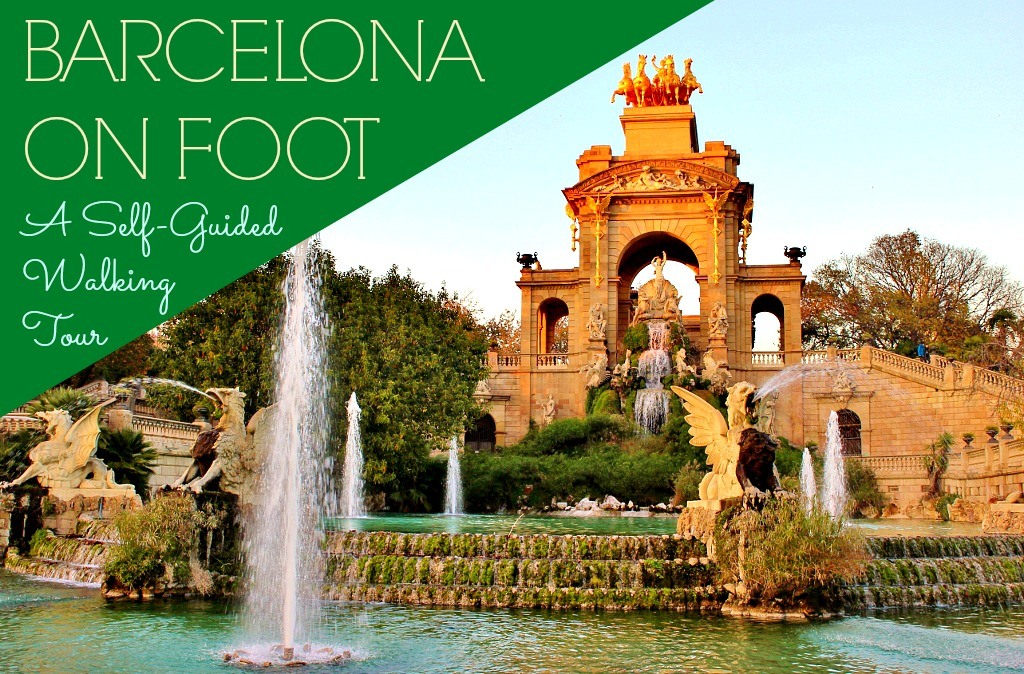

Self-Guided Free Walking Tour: Barcelona On Foot
Welcome to JetSetting Fools, here you will find our best travel tips for destinations worldwide. Some of the links on this site are Affiliate Links and if you use them to make a purchase, we may earn a commission. For more information, read our Disclosure Policy .
Barcelona, Spain has an amazing history and the city is packed with iconic sights. The best way to experience the Catalonian Capital is to set off on foot on a Barcelona Walking Tour.
Many of the city’s top attractions are clustered around the Barcelona Old Town – which is the best place to start exploring. Travelers can opt to join one of the Barcelona Guided Tours or plan to venture out and discover on their own with our DIY Free Barcelona Tour.
Our easy-to-follow Free Self-Guided Barcelona Walking Tour includes the best sights in the Old Town. Seeing these sights is a must for your Barcelona Itinerary – so lace up your travel shoes and follow in our footsteps for a fantastic introduction to Barcelona!
Self Guided Old Town Barcelona Walking Tour FREE

Our Barcelona Self-Guided Walking Tour is ideal for visitors who like to discover sights at their own pace. We include information about each attraction – as well as a map link so that you can easily find your way. At the end of the article, we include a complete Barcelona tour map that plots all of the attractions on the route.
The route of our Barcelona free walking tour loops through the metropolis, passing sights like Las Ramblas, the vibrant waterfront, Barceloneta beaches, the city’s greenest park, historic Barcelona neighborhoods and the most famous Barcelona attractions.
Guided Walking Tours Barcelona
We think our DIY Barcelona tour is the best way to see the city. However, if you would rather a guide lead the way to the sights, we offer recommendations on the top rated walking tours in Barcelona at the end of the article.
Tips For Exploring Barcelona on Foot

Before we hit the pavement and get started, we have a few tips for your Barcelona, Spain walk!
Barcelona Tourist Map
As we already mentioned, we provide a Barcelona Attractions Map at the end of the post that includes all the highlights of our tour. Additionally, we include a helpful with walking directions.
However, to follow along online, a WiFi connection is necessary. Foreign visitors can use a Mobile WiFi device , like GlocalMe for internet access (which can be cheaper for families and groups of friends than adjusting individual phone plans to include international data).
Travelers who prefer paper maps can buy one online (like this one ) or pick up a Barcelona tourist map from the Tourist Information Center.
Self-Guided Walking Tour Barcelona Details
Our Self-Guided Walking Tour of Barcelona covers 5+miles. The entire route can be (ambitiously) completed in about 2 hours. But, that won’t leave much time for stops, photos or detours. Unless you are short on time, we recommend slowing down and taking an entire day to enjoy the Barcelona sights.
Barcelona Detours and Suggestions
Walking around Barcelona, Spain, you can be easily distracted by architecture, hidden lanes and old churches. While we think our outlined tour is one of the best walks in Barcelona, there is plenty of room for wandering! Use this as a guide, but create your own walking routes in Barcelona to experience the city as it suits you!
Pin, Bookmark or Save our Barcelona Walking Tour for Free to plan your trip to Spain!
15 Barcelona Self-Guided Walking Tour Sights

Let’s get started on our Walk Through Barcelona! Remember to refer to the Barcelona Walking Tour Map below for walking directions.
#1 Placa de Catalunya

The starting point for our Best Walking Tour Barcelona is Placa de Catalunya – or Catalonia Square. It is a vast square located on the north end of the Barcelona Old Town. In the square are fountains and statues – and it’s central location is the ideal place to start your Barcelona exploration!
#2 Las Ramblas

The most famous street in Barcelona is Las Ramblas. What was once a drainage ditch is now a wide, pedestrian path – and the most well-traveled street in the city. Strolling the length of Las Ramblas is a must on your Barcelona Self Guided Walking Tour.
Newsstands, flower shops and street artists line the length of The Ramblas. Extending from Placa de Catalunya to the Waterfront, strolling down Las Ramblas is a must for Barcelona visitors! Detour off the main strip to discover small squares and quaint streets.
#3 Placa Vila de Madrid

The next stop on our free tour of Barcelona is the inconspicuous Placa Vila de Madrid Square – and it is filled with fascinating history. Once the site of a convent, excavations revealed an ancient past…one dating to the 1st century AD, when Barcelona was a Roman colony, known as Barcino.
The archaeological findings – about 60 tombs lining a road – are now on display in the square. The Roman Necropolis lends insight into the history of the city. A small museum at the Via Sepulcral site provides further information and artifacts.
#4 La Boqueria Market

The La Boqueria Market – officially The Mercat de Sant Josep de la Boqueria – can trace its history to the year 1217. The Barcelona city center market offers a range of goods, including everything from seafood to sweets – all presented in colorful displays. In addition to vendors, small kiosk restaurants are also on site.
In fact, La Boqueria is home to some of the Best Tapas in Barcelona – so if you are hungry, take a break from your Self Guided Tour Barcelona and grab a bite to eat.
#5 Gran Teatre del Liceu

One of the best sights near La Rambla, continue your Best Free Walking Tour Barcelona by sidestepping from the famous street to a top attraction: Gran Teatre del Liceu.
A luxurious opera house, Gran Teatre del Liceu opened in 1847 (although, it had to be rebuilt after a fire in 1994). The façade, however, is original – if not rather plain in comparison to the beautiful theater that lies within. Visitors can attend a performance or take a tour.
#6 Placa Reial

Another one of the great destinations just steps from Las Ramblas as you walk south from the La Boqueria Market is Placa Reial.
A hidden gem right in the heart of the city, Placa Reial is a spacious square located off a side street (Carrer de Colom) from Las Ramblas. The square is ringed with restaurants and cafes – and features swaying palm trees, a fountain and lamp posts designed by Antoni Gaudí.
#7 Palau Guell
The Guell Palace, a mansion designed for the Guell family, is an early (and quite extraordinary) work by Gaudi. It is part of the UNESCO World Heritage Site, “Works of Antoni Gaudi” and can be toured with a ticket.
Even if you don’t tour the palace, it is worth seeing Palau Guell from the outside on your Barcelona walking route.
#8 Columbus Monument and Barcelona Waterfront

Continue your Self Guided Free Walking Tour in Barcelona to southern end of La Rambla and the Columbus Monument. The obelisk rises 200 feet into the sky marking the south end of La Rambla and the beginning of the Barcelona waterfront. A statue of Christopher Columbus pointing to the New World is perched atop the singular, decorative column.
The monument stands to commemorate the return journey to Barcelona, where he reported the discovery to the Spanish Queen Isabella and Ferdinand. The statue was erected in 1888 for the Universal Exhibition. Today, visitors can take in the views from the top of the monument (buy your ticket in advance !).
#9 La Rambla del Mar

From the Columbus Monument, step onto the wooden walkway that is best known as La Rambla del Mar – the Walk by the Sea.
The boardwalk leads to a hub of activity – and plenty of places to distract you from your Self Guided Walking Tour Barcelona. Top things to see and do include seaside eateries, the Maremagnum shops and the Barcelona Aquarium ( buy your Skip-the-Line Aquarium tickets ).
#10 Barceloneta

Heading north around the harbor, continue walking in Barcleona past the hundreds of sailboats and a few extraordinary large yachts in Port Vell and enter the seaside neighborhood of Barceloneta.
Previously the local fisherman’s quarters, the dilapidated area was overhauled in the 80s – and is now one of Barcelona’s trendiest spots. In addition to the wide, popular beach, the Barceloneta district features a plethora of seafood restaurants and ocean view cafes.
#11 Parc de la Ciutadella

The next stop on your Barcelona city walk is the enormous park, Parc de la Ciutadella. It is Barcelona’s best (and, at one time, only) green space. The park encompasses the Barcelona Zoo, waterfalls, ponds and monuments.
Don’t miss Cascada del Parc de la Ciutadella, the most opulent fountain in the park. The decorative fountain dates to 1881, but was enhanced with sculptures and the arch in time for the 1888 Universal Exhibition – with some credit going to then novice Antoni Gaudi.
#12 La Ribera and Santa Maria del Mar

After visiting the spacious park, continue your Self Guided Walking Tour of Barcelona into the historic lanes.
Navigate your way to the cobblestone streets of La Ribera. Many of the buildings in the district date to Medieval times, when it was home to Barcelona’s most affluent citizens. Artist studios, boutique shops and hip cafes now line the streets.
In the tangle of lanes, find the Esglesia de Santa Maria del Mar. The expansive Gothic church, which dates to the early 1300s, is one of Barcelona’s most beautiful buildings.
#13 Barri Gothic Quarter and Barcelona Cathedral

Barri Gothic is the heart of the Barcelona Old Town and the oldest part of the city. The majority of the district is pedestrian-only – so take time to wander the streets, perhaps venturing into a few shops or tapas bars along the way.
As you wander the district, make your way to La Catedral – a must-see sight on Barcelona city walks.
The massive La Catedral – or Barcelona Cathedral – is situated in the Barri Gothic Quarter (and should not be confused with the still-unfinished work of Gaudi , La Sagrada Familia).
The cathedral façade is decorated with soaring spires and decorative gargoyles. The interior of the cathedral is lit by grand chandeliers. Beneath the altar is a crypt hosting the remains of Santa Eulalia, one of Barcelona’s Patron Saints.
#14 Palau de la Musica Catalana, Barcelona
If time permits, continue your free Barcelona Walking Tour to one of the best Barcelona sights: The Modernist Palau de la Musica Catalana.
It is one of Barcelona’s most beautiful concert halls. Built in 1908 by Spanish architect Domenech i Montaner, the exquisite building is a UNESCO World Heritage Site (just one of the many Modernist buildings in the city to earn the UNESCO status!).
Want to see the interior of Palau de la Musica Catalana? Join a 45-minute guided tour that includes the famous skylight, the grand staircase and sights that are usually off-limits!
#15 Arc de Triomf, Barcelona

The final stop on your Self Guided Barcelona Walking Tour is the Arc de Triomf.
Unlike most city arches, the Barcelona Arc de Triomf was not built to celebrate a military victory. Instead, the grand, red-brick arch was built in 1888 to welcome visitors to the Universal Exhibition World Fair.

Barcelona Sightseeing Map
Use this link to Google for an interactive version of our Walking Route Barcelona Map.

Barcelona Walking Map
Click for the Barcelona Tourist Attractions Map with Walking Directions in Google Maps .

Guided Barcelona Walking Tours
Our Barcelona Self-Guided Walking Tour is a great way to explore the city on your own! However, there are many guided Barcelona walks that are theme-based. We are featuring a few of the most popular Barcelona walking tours.
Old Town and Gothic Quarter Walking Tour

Visitors who want a local guide to lead the way through the heart of the city can join a highly rated tour that features the best sights in the Old Town and Gothic Quarter. The local guides share history, facts and fun stories along the route.
Gaudi Tour Barcelona

Antoni Gaudi is Barcelona’s most famous architect. Learn about his life, his designs and his impact on the city on one of the guided walking tours through Barcelona. Top Gaudi sights to see are La Sagrada Familia, Park Güell, Casa Batllo and Casa Mila.
Visitors can take a private tour, join a small group tour or even pedal along on a bike tour to Gaudi attractions. Read reviews on Viator to find the perfect Gaudi tour for your trip!
Barcelona Tapas Tour

Tapas are an art form in Barcelona! Let a local guide lead the way on an introduction to the unique cuisine on an evening tour .
However, you can follow in our footsteps and create your own Tapas-hopping Tour based on our recommendations for the Best Tapas in Barcelona !
Free Barcelona Walking Tours
Many different companies offer free walking tours in Barcelona. Just keep in mind that ‘Guided Free Walking Tours’ are not in fact free – as the tour guide expects to be tipped for their service.
More Things To Do in Barcelona, Spain

Navigating the city on foot is a great way to spend a day in Barcelona. Guests staying longer can use the travel tips in our 3-Day Barcelona Itinerary for tips on what to see and do.
We offer tips for what to do in Barcelona for 3 days – plus offer day trip ideas, feature top museums and highlight activities – like a popular Flamenco show.
Planning a Trip to Trip to Barcelona
We know that there is so much more to planning a Barcelona trip than deciding what sights to see – so we have a few more travel tips that will help you plan the perfect vacation.
First, if you are traveling from overseas, read our guide to Planning a European Vacation . We share need-to-know details and tips that will help you make the most of your trip abroad.
As you make your plans, be sure to stay on top of all the details! Use our Trip Planner Printables to stay organized for your trip to Barcelona.

Where To Stay in Barcelona
There are a lot of choices when it comes to places to stay in Barcelona! We recommend choosing centrally located accommodations – based on the activities that are of most interest to you. We like two areas – L’Eixample neighborhood and El Poble-sec.
We have stayed in the L’Eixample District in an Airbnb apartment (which we loved for the extra space and kitchen, where we could prepare breakfasts). The neighborhood was excellent for seeking out local cafes and bars – and extremely convenient to exploring the Modernism architecture.
El Poble-sec
Recently, we stayed in the Hotel Concordia Barcelona in the El Poble-sec district – which lies between Montjuic and the Old Town. The location was ideal for local transportation from the airport and within reasonable walking distance to the Old Town, Montjuic and the famous tapas street. The clean hotel features modern rooms, an outdoor pool and a casual on-site restaurant and bar.
Use our Guide to Finding the Best Hotels at the Best Rates – then start your search for the perfect Barcelona hotel on Booking.com !
What To Pack for Your Barcelona Trip
Now that you are well on your way to planning the perfect Barcelona trip, it’s time to start packing! We are sharing a few must-have items for Barcelona – but you can find all of our advice on our Packing Tips page. Grab your Free Packing Checklist before you go!
Comfortable Walking Shoes
Our Barcelona Walking Tour covers some ground – so make sure to pack good travel shoes . It’s best to wear shoes that are comfortable and versatile – which is why I like these sneakers . Kris prefers to wear Merrell trail shoes for men when walking around cities.
Travel Camera
Barcelona is beautiful! We recommend upgrading to a real camera for your trip. We use a Canon Rebel with an 18-135mm lens . We love that it is easy to use, takes quality photos and is well-priced as a budget DSLR camera for travelers .
Barcelona Map and Guidebook for Spain
It’s easy to get turned around or lost in any new city! Be sure to have a good city map and/or guidebook prior to arriving.
Anti-Theft Day Bag
While Barcelona has wonderful sights, it also has pickpockets. Be sure to pack a zippered day pack – like the ones by Travelon – to organize and secure all of your daily travel items . Read our tips for The Best Day Bags for Travel .
Spain Trip Insurance
If you haven’t already obtained travel insurance for your vacation to Spain, consider traveling protected with World Nomads .
Tips For Visiting Spain
Planning to visit more than just Barcelona on your trip to Spain? We have travel guides for top Spain destinations.
- Plan a perfect 1-Week Spain Itinerary
- Spend Christmas in Barcelona (and other European Winter Destinations )
- Discover the Best of Seville
- Explore the Sights of Madrid
- Enjoy the Best of Basque Country
- Feast on Pintxos in San Sebastian
Find more tips and guides on our complete Spain Travel Guides page!
Start planning your trip to Spain ! Search for the lowest airfares , the best accommodations and fun things to do …then start packing ! Want more travel planning tips? Head over to our Travel Planning Page for more information and tips on traveling – and for country-specific information, take a look at our Travel Guides Page !
We want to know: What would you add to our Barcelona on Foot walking tour? Give us your best tips and suggestions for a Self-Guided Barcelona Walking Tour in the comments!

Pin it! See all of our travel pins on our JetSetting Fools Pinterest Board .

Share This Story!
- Click to share on Pinterest (Opens in new window)
- Click to share on Facebook (Opens in new window)
- Click to share on Twitter (Opens in new window)
- Click to share on LinkedIn (Opens in new window)
12 thoughts on “ Self-Guided Free Walking Tour: Barcelona On Foot ”
Pingback: Budget Travel: 26 Ways to Travel Spain for less
Comments are closed.

A Free & Self-Guided Barcelona Walking Tour
By: Author Sophie Nadeau
Posted on Last updated: 4th October 2023
Categories Spain , walking tour
Last Updated on 4th October 2023 by Sophie Nadeau
Between endless plates of tapas, all the art nouveau architecture, and an abundance of hidden gems you’ve never heard of before (but totally should have done) , there’s no shortage of epic experiences to be had when exploring Barcelona, especially if you plan to see the city by foot. Here’s your ultimate free and self-guided Barcelona walking tour to help you get the most out of a visit to the capital city of Catalonia.

If you’re thinking about seeing a lot of attractions and monuments while in the region of Catalonia, Consider purchasing the 12-Month Unlimited Visits Catalonia Monument Pass , which includes access to 29 museums, monuments and historical sites throughout Catalonia.
To work out whether or not the pass is worth it for you or not, add up the cost of the individual attractions you wish to visit and see if you’ll save money. Find more details here.

Free Barcelona Walking Tour: Practical Advice, Tricks, and Tips
Plaça reial, artisa barcelona, palau güell (guëll palace), mercat de la boqueria, plaça de catalunya, libreria altaïr, casa battló, palau macaya, plaça de la sagrada familia, la sagrada familia, arc de triomf, parc de la ciutadella, basilica de santa maria del mar (basilica of saint mary of the sea), museu picasso de barcelona (picasso museum of barcelona), catedral de barcelona (barcelona cathedral), enjoyed reading this free and self-guided barcelona walking tour pin this article now, read it again later:.
The walk is best attempted on a sunny day when the streets are warm, a summer vibe is in the air, and the city looks its best. You’ll want to bring along a camera to snap some of the best of Barcelona, and so here are some of my very best travel camera recommendations !
Although the majority of the tour is on level roads (with a few cobbled hilled lanes thrown in) , I highly recommend shoes that are comfortable to walk in like these ones .
Otherwise, it’s worth noting that Barcelona can become incredibly hot (especially during the summer months) and so you’ll want to bring a reusable water bottle like this one with you.
As you might expect with a major European city, there are plenty of places to eat, hydrate, and caffeinate en route. And from budget eats to vegetarian fare to speciality coffee shops, you should know that Barcelona has plenty to offer!
Before you visit Barcelona, one of the most important things to know before you go is that many of the major attractions need to be booked ahead of time. To help you plan your trip, check out our guide on what to book in advance in Barcelona .
For even more inspiration before your trip to Catalonia, be sure to check out these beautiful quotes about Barcelona. For more general inspiration, then be sure to check out our top Spain quotes . So put on your comfiest clothing and enjoy this free Barcelona walking tour…
Walking Time: 1 hour 40 minutes
Distance Covered: 7.9 km
This self-guided walking tour of Barcelona begins in the beautiful pedestrian square of Plaça Reial. Situated in the Gothic Quarter of the city (and the place where I recommend booking a place to stay if you want to be close to all of the best attractions and foodie spots) , the plaza boasts a number of nightclubs, bars, and hotels.
Take a moment to orient yourself and load up your map before venturing out into the city. Otherwise, be sure to enjoy the stunning palm trees which litter the square (whose name translates into Royal place) and the King Ferdinand VII statue in the very centre of the square.

Start your day the right way (or, at the very least, your time exploring Barcelona on foot) by fuelling up with a breakfast formula, or tasty ice cream depending on the time of the day.
While a little bit more touristic than some of the other cafés in the city, there’s no denying the deliciousness of the coffee and patisseries on offer at ARTiSA Barcelona.
This café and confectionery shop offers indoor and outdoor seating, making it a suitable base to enjoy a quick bite come rain or shine. Well-reviewed across many sites, the café was opened in late 2009 and offers a variety of authentic Catalan produce at good prices.

Situated on Carrer Nou de la Rambla, this former mansion house was created by Antoni Gaudi at the behest of a wealthy businessman, Eusebi Güell, who wished to have an abode in the El Raval district of Barcelona.
Created in the late 19th-century, this house boasts all of the architectural features which are so quintessentially Gaudi; natural forms inspire carved brick and beautiful balconies. Today, you can visit the Palace for a small fee. Find more details here.

For the freshest, most authentic, and best local eats in town, be sure to head to the covered marketplace that is Mercat de la Boqueria. Fully known as Mercat de Sant Josep de la Boqueria, this thriving foodie spot has stalls ranging from beer stands to fish vendors to fresh vegetable sellers.
There has been a market of sorts on site since at least the 13th-century when the food court was mentioned as stalls selling meat close to the city gate.
During the 19th-century, the market was officially recognised, leading to the thriving Mercat de la Boqueria you can enjoy today. If you’re visiting Barcelona for several days, then a visit to the market is recommended in our 3 days in Barcelona itinerary .

Offering a fantastic glimpse of much of the different architectural styles that Barcelona has to offer; this is where the 19th-century buildings of the Eixample district meet the historic architecture of the old town district of the city, Plaça de Catalunya is one of the largest public squares in the city.
Take a moment to pause, sit on one of the many benches on the plaza, and watch the world go by. Otherwise, be sure to check out the beautiful architecture of the theatre, cafés, and restaurants which surround the public space. There are also sculptures dotted across the Plaza which represent several different styles.

Hands down, one of the best bookshops in Barcelona is that of the Altaïr Bookshop. After all, this book vendor is filled with shelves stacked from floor to ceiling, all dedicated to travel. Organised by region, there’s a huge section on Spain, and an even larger section on Catalonia, and on Barcelona.
It’s worth noting that while most of the books, tomes, and travel memoirs for sale were Spanish language, there were still plenty of works available to purchase in English and French. I personally even managed to pick up a book on secret Barcelona on my visit (even though my suitcase was already overstuffed!)

One of the most famous of the Gaudi buildings in Barcelona is that of Casa Battló, an organic-inspired architectural house complete with the broken-tile look that is so synonymous with Gaudi.
Constructed at the behest of Lluís Sala Sánchez, the house is often considered to be one of Gaudi’s greatest works of art. Known locally as the House of Bones ( Casa dels ossos ) thanks to its unusual form and shape, it’s worth noting that you can even go inside if you pay the entry fee.
However, you should know before you go that even the ‘skip-the-line’ pre-paid entrance ticket means plenty of waiting time in order to visit and so you should head to the house earlier in the day and mid-week if possible so as to avoid the worst of the queues.
Purchase your Casa Battló ticket here in advance.
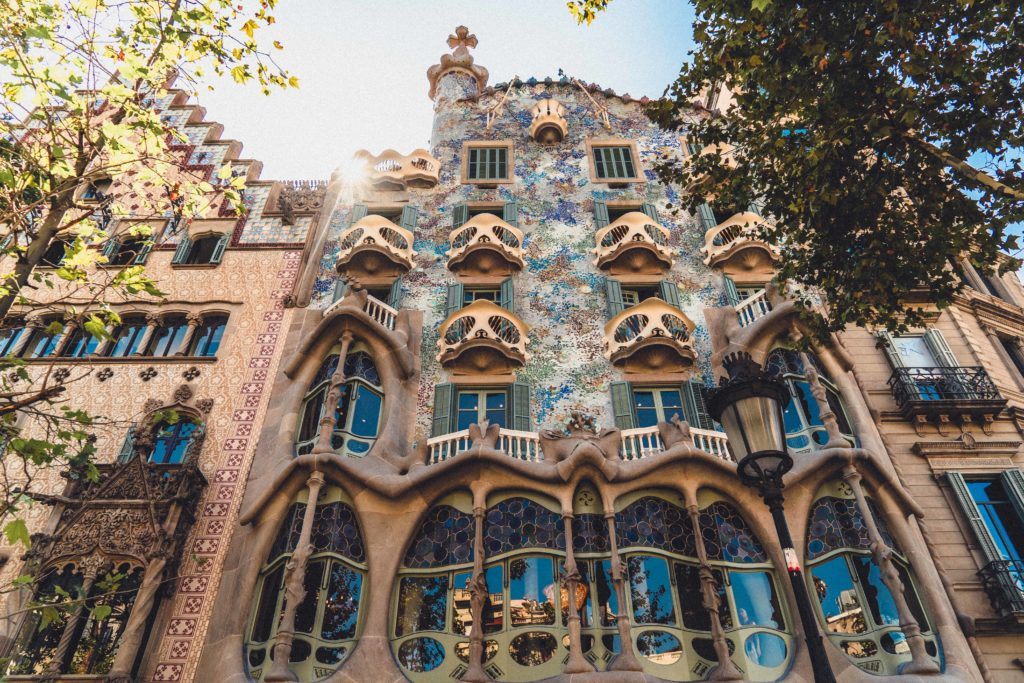
Beautiful and ornate, Palau Macaya is one of Barcelona’s best-kept secrets. Situated alongside the green space which lies beside Passeig de Sant Joan.
While you can sit and check on directions on the many benches which line the park (which also happens to offer a fantastic view of the Sagrada Familia) , the courtyard of Palau Macaya is also free to visit during opening times and is one of the best photo spots in Barcelona.

The best view of Gaudi’s beautiful ecclesiastical masterpiece (which is famously still unfinished) is not directly beneath the church itself, but instead from the small green park a little walk away.
Lined with benches and plenty of trees, this quiet and secluded spot feels miles away from the hustle and bustle of the immediate area surrounding the Gaudi building.

Next, carry on this self-guided Barcelona walking tour right towards the cathedral. This is one of the easiest steps of the self-guided tour as its hard to miss the nature-inspired towers of the Sagrada Familia presiding over the rest of the buildings in the area.
Designed by Antoni Gaudi in the 19th-century, the cathedral is perhaps so famous thanks to the fact that it’s still under construction (and has been this way for over a century).
The church was only consecrated in 2010 and today you can visit for a fee. However, you should know before visiting that this is one of the most popular buildings in Barcelona, meaning you should book your tickets well before you go.
Purchase your Sagrada Familia tickets here in advance.

Yes, you read that correctly! Barcelona, too, has a Triumphal Arch, just like the famous one in Paris , that of Montpellier, and of course, the Arcul de Triumf in Bucharest . Also known as the Arco de Triunfo de Barcelona in Spanish, this arch was constructed in 1888 to act as the main entranceway to the World’s Fair.
Today, you can wander underneath the archway of the Barcelona Arc de Triomf , all the while admiring the stunning stonework. Otherwise, be sure to sit down and rest for a moment or two beneath the palm trees swaying in the breeze and admire the architecture of this Barcelona district.

Best seen on a warm and sunny day when you can stroll around the park, enjoy a picnic in the shade, or rent a boat on the lake for the most romantic of Barcelona experiences, Parc de la Ciutadella is a must-see while in the city and is the perfect place to relax, away from the hustle and bustle of the busy rest of the city.
Created in the 19th-century, once upon a time, this was the only green space that Barcelona had to offer. Some of the main highlights of this sprawling parkland include the chance to glimpse the Palau del Parlament de Catalunya and the stunning chapel of Església de la Ciutadella.

Completely free to visit (though donations are, of course, always appreciated!), the Barcelona Basilica can be found in the Ribera district of Barcelona. One of the best examples of the Catalan Gothic architectural style, the ecclesiastical building dates all the way back to the 13th-century and a time when much of Barcelona’s main income came through sea trade.

For those who wish to marvel at a little bit of artwork during their time in Barcelona, a visit to the Picasso museum close to the Gothic quarter is an absolute must. For a closer look at the famous artist in Barcelona, be sure to book this Picasso Walking Tour & Picasso Museum of Barcelona.

Last but not least, the last stop on this free Barcelona walking tour is the Cathedral of the city, i.e. the ecclesiastical building which grants Barcelona its city status. Situated in the maze and passageways of tiny streets which snake their way through the Gothic district of the city, the Cathedral is much less frequented than the Sagrada Familia but is nevertheless still worth a visit.

Sophie Nadeau loves dogs, books, travel, pizza, and history. A Francophile at heart, she runs solosophie.com when she’s not chasing after the next sunset shot or consuming something sweet. She splits her time between Paris and London and travels as much as she can! Subscribe to Sophie’s YouTube Channel.
This site uses Akismet to reduce spam. Learn how your comment data is processed .
Kalyan Panja
Saturday 7th of September 2019
Barcelona seems so vibrant! I am so disappointed that I was not able to go there on my own recent trip to Spain. Next time!
Seeker is the social platform to find and share the places you love.
0 Places . 0 Trips and Guides.
Please enter your email
- Seeker for Brands
- Become a Brand Ambassador
- Let’s connect
New to Seeker? Join for free
Already have an account? Login
A Self-Guided Barcelona Walking Tour of Gaudi’s Magic City
Sustainable travel expert, adventure seeker
Few cities in the world can be swiftly summed-up with just the single name of a local artist. Yet when it comes to Barcelona, Gaudi certainly does the trick. As the embodiment of the Catalan Modernist architectural movement, Antoni Gaudi isn’t just a part of Barcelona, he is Barcelona. His fantastical designs greatly influence not just the face of the vibrant Catalonian capital, but immortalise its skyscape in the hearts of millions of tourists every single year. Even if you wouldn’t consider yourself a fan of architecture, you simply can’t go past a Gaudi tour-de-force when taking a walking tour of Barcelona; the master’s creations are considered more than mere ‘buildings’ but bonafide liveable works of art.
From street lights to fountains, museums, homes, public parks, and, of course, La Sagrada Familia — his most famous beloved pride and joy — Gaudi’s Barcelona collection is not only impressive, but also quite extensive. Unless you’re an avid fan (bordering on obsessive), I’d recommend you set aside one full day for a self-guided Barcelona walking tour of the 5 must-see Gaudi treasures around the city. This will not only give you a great overview of the artist’s unique and quirky style, but will also offer the bonus of guiding you through a mix of Barcelona’s most distinctive hoods.
Here are the 5 Must-See Gaudi Treasures in Barcelona (visit them in the order suggested for a day that will knock your socks off).
I kicked off my Barcelona walking tour in Park Güell and totally cheated by taking a metro ride (L3, Vallcarca stop) to save an hour’s steep walk uphill at the beginning of my day. Originally designed to be a privatised upmarket suburb, the funding project of Park Güell eventually ran out of gas (much like me by 4pm), and was converted to a public park instead, one that’s just brimming with Gaudi’s artistic touches at every turn.
Take the western entry into Park Güell and follow the walking trail upwards, where you can soak up wondrous views of the city skyline and the three houses which Gaudi designed. You’ll need to buy an entry ticket to see the houses (in the southern section), yet admiring them from above and below are certainly rewarding enough.
Follow the trail as it spirals down and you can pause to soak up the details of Casa del Guarda and the Dragon Stairway. Don’t forget to pack a picnic lunch; the park is always buzzy, but this is one of the most relaxing spots in all of Barcelona and finding a quiet nook in which to rest and admire the views is supremely easy.
Casa Vicens Gaudi
As you exit Park Güell in the south, you’ll find yourself in Gràcia, one of the least visited yet most enchanting suburbs in Barcelona. Wind your way southwest through the narrow alleyways lined with charming plazas (and stop for a cafe con leche in one of the many charming cafés) until you reach Casa Vicens , a grandiose mansion designed by the master himself, and the second stop on our Guadi-inspired Barcelona walking tour.
This was the very first house Gaudi built in Barcelona, yet because it’s only been open to the public for a couple of years, it still flies below the tourist radar. I loved the fact that I had this incredible place to myself for the first hour of my visit but, most of all, I adored the Moorish influence of Gaudi’s earlier works, which seemed to disappear later in his career. What has always been a constant, and is visible here, is Gaudi’s extensive and eclectic use of mixed material: ceramic, glass, and cast iron, always colourful and always used with skill. Lovingly restored and offering insightful guided tours, Casa Vicens is, in my opinion, one of the most inspiring Gaudi treasures in the city.
A leisurely 20 minute stroll down Carrer Gran de Garcia on your Barcelona walking tour will take you to Casa Milà , contrastingly one of the most famous Gaudi-designed homes in Barcelona. The fabulous exterior façade of the house, known as La Pedrera (the stone quarry), is intricate and captivating enough, yet the exhibition room in its interior and the amazing rooftop terrace certainly warrant an entry ticket of their own accord.
As with all of Gaudi’s works, Milà captivates both in its details and as a whole: you could spend hours on end trying to capture every minute detail and seeing how they all merge to complete the ethereal picture. Every column is unique and slightly slanted, the wrought iron work is magnificent, and the undulating balconies grant Milà an almost cartoon-like appearance.
Casa Milà was the last private house Gaudi worked on before dedicating himself fully to La Sagrada Familia in 1912. It has been UNESCO inscribed, like six other Gaudi treasures, since 1984.
Casa Batlló
Gaudi’s earlier works were mandated by Barcelona’s richest families, and so it was that he came to restore Casa Batlló for a prominent textile merchant. This is one of the most colourful Gaudi pieces of all, one that incorporates almost every style for which he became world-renowned: curved balcony detailing, extensive use of colourful mosaic ceramic, stained glass, stone ornaments, and intricate woodwork.
Overall, Casa Batlló is a spectacular architectural vision and it seems almost preposterous to know it is over 110 years old. Take a guided virtual reality tour and you can experience and envisage the mansion the way Gaudi meant it to be, before it became the tourist hive it is nowadays with most of its furnishings having been removed for preservation. A unique insight into Gaudi’s genius imagination and a wonderful precursor to his most celebrated accomplishment.
La Sagrada Familia
The first glimpse I had of La Sagrada Familia caused my heart to skip a beat. I was two blocks away when the spires came into view above the grand buildings of Carrer de Mallorca, and they still managed to stop me dead in my tracks. Up close, this incredible architectural marvel is nothing short of jaw-dropping and, trust me, I’ve certainly seen my fair share of architectural treasures all over the world. In fact, I was a little skeptical of the Gaudi-hype before starting this walking tour around Barcelona, but, at the end of my day’s walk, had a sense that this would be an overwhelming experience. And it sure was.
Everything about La Sagrada Familia is breathtaking — aside from the fact that it is incredibly imposing, its details are truly astonishing, and knowing this is one of the world’s top 20 structures that took the longest to complete simply adds to the appeal. The fact that the city is scrambling to have La Sagrada Familia completed by 2026 (to mark a century since Gaudi’s tragic passing ) is testament to the dedication, and some would say lunacy of its intricate design. You’ll want at least 2 hours here, as a minimum, and some would say you could visit the now sanctified Roman Catholic Basilica many times and still discover new details. This is one of the craziest, yet most beautiful, man-made structures I’ve ever seen.
The crowds are the only truly sobering aspect of a visit, but with a full-access ticket, you’ll soon learn to look beyond them and enjoy the multisensory experience. A true work of art, and the most beloved creation of a devoted and very religious man, La Sagrada Familia isn’t just a must-see in Barcelona, this is a bucket-list treasure everyone should see at least once in life.
Tips to help you plan your Gaudi-inspired Barcelona walking tour:

- I recommend taking this walking tour as soon as you arrive in Barcelona. I left it until day 4 of my visit, and I was already fatigued from all the walking around on the previous days. In hindsight, I should have done this as soon as I arrived as I found this to be the most exhausting day of all — over 25,000 steps and counting!
- If you wish to explore any of the buildings’ interiors, you should buy your entry tickets online a few days ahead of time . This is especially crucial for La Sagrada Familia, the single most visited site in the entire country.
- If you’re travelling to Barcelona on a budget, then I’d say the only treasure you should splurge on is the most expensive (ahem, La Sagrada Familia, of course) which is absolutely worth every penny. A full-admission ticket costs $32, which will also grant you access to one of the towers and a super informative audio-guide, the latter being an unmissable addition. You will really get the most out of your visit when you learn all there is to know about Gaudi and his vision for this yet-to-be-completed gem whilst visiting it. If you indulge in nothing else in Barcelona, indulge in this!
- Choose a clear sunny day for your walking tour around Barcelona: Gaudi was a fanatic of colour and mosaic tiling, and his masterpieces sparkle to life on a sunny day.
- Let La Sagrada Familia be the last place you visit. There are three main reasons to do this: first, the church is west facing and, in the late afternoon, the sun shines through the stained-glass windows to create a mesmerizing rainbow of colours inside. Secondly, it is undoubtedly the most impressive Gaudi treasure of all — just when you think you can’t be any more impressed, WOW! Thirdly, there’s a handy Metro station below the church — in case you’re absolutely wiped out at the end of your long walking tour around Barcelona, like I was, you can simply take the Metro back to your hotel.
You might like
The best cities in spain for a romantic getaway, 5 best places in barcelona to people watch over sangria, sant antoni: the hidden gem of barcelona.
- RADICAL STORAGE
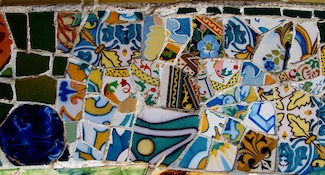
Self-guided sightseeing tour of Barcelona
Our self-guided tour of Barcelona is the best way to explore the city. You decide where to go, what to see, and how long to stay!
Supported languages
English, Spanish, German, French, Italian
Cancellation Policy
Non-refundable
Planning to visit Barcelona but don’t want to be limited to a set route? You can choose from about 130 landmarks and attractions in the city and create your own walking itinerary.
Discover famous sights such as the colorful Park Güell and the charming Gothic Quarter alongside great eating, shopping, and leisure options. Our tour contains a collection of professionally recorded guides of the best attractions in Barcelona, with excellent tips on the city and suggestions on public transport.
Barcelona is one of Europe’s most enchanting and cosmopolitan cities. It’s a great place to visit for several reasons, even if you’re just a casual tourist. A stroll through its unique streets reveals an array of architectural styles of the buildings, such as the Romanesque, Gothic, Baroque, Modernisme, and many others. The Catalan capital is home to a range of must-see attractions, with Gaudi’s Sagrada Familia and Casa Batlló making the top of most visitors’ lists. However, there are several other experiences that can enrich your tour of the city and make your trip even more memorable.
If this is your first time visiting Barcelona or you’re short on time, you may be wondering how to include all the main stops on your walking route.
Our self-guided tour can help you get the most of your time.
How does it work
Vox City app is the perfect travel companion for your trip to Barcelona. Download it from App Store or Google Play to your mobile phone or tablet and take a self-guided, offline walking tour of the city. The app includes several guided walking tours with a detailed map, public transport guidelines, informative background texts, local tips, and perfect audio narration. You can walk from one attraction to another with no need for an internet connection, as the Vox City map works offline.
Find out how to start your self-guided walking tour of Barcelona:
- Book the Barcelona self-guided tour.
- Download the Vox City app.
- Scan the QR code received after booking to activate the digital content.
Here is what includes Barcelona self-guided tour :
- Offline digital maps
- Walking itineraries and bicycle routes
- Bus and tram itineraries
- Great photo spots
- Free Wi-Fi and charging locations
Barcelona self-guided tour does not include:
- Entrance tickets to museums and attractions
- Food and drinks
- Headphones and devices
- Hotel pick up/drop off
Customize your Barcelona walking tour
Barcelona is one of the most popular tourist destinations in Europe, but that doesn’t mean you should rush to plan your tour in the city. Instead, it would be best if you take your time to plan a perfect route and choose the attractions that best fit your interests. This way, you can learn about every aspect of this incredible city and don’t miss any of your preferred sights.
Our self-guided tour is the best way to experience what the city has to offer. Our interactive walking itineraries developed by local experts will take you through Barcelona’s most famous sites, including several off-the-beaten-path places . All without the worry of figuring out which way to go.
With Vox City, you can plan your tour online in advance and explore Barcelona at your own pace whenever you want.
Related activities
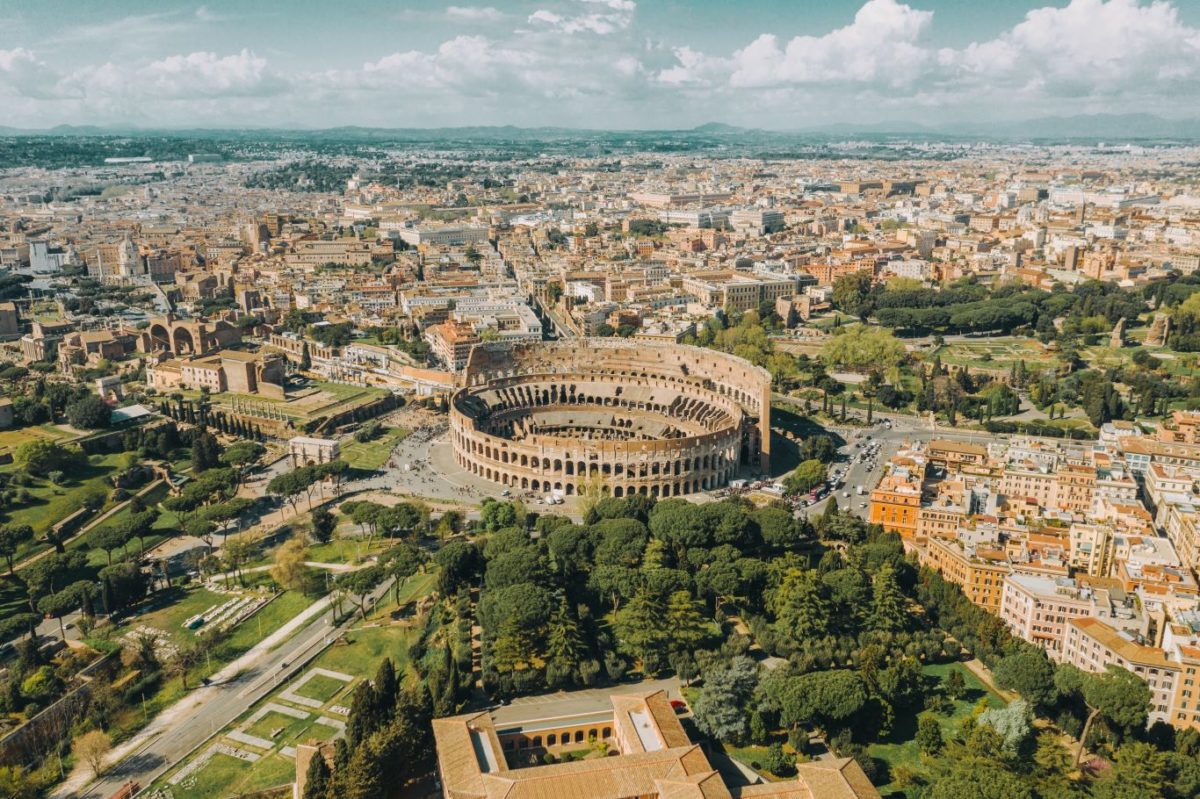
Rome in the Morning e-bike Tour
You can enjoy Rome without traffic and at the first light of dawn See buildings that no longer exist through 3D reconstruction of the ancient sites of the 80 AD period. Rome in the Morning e-bike tour allows you, in a few hours, to admire the ancient Rome and discover hidden corners of the city, not […]
Adult (Age 11-99) € 54.00 Children (Age 6-10) € 27.00
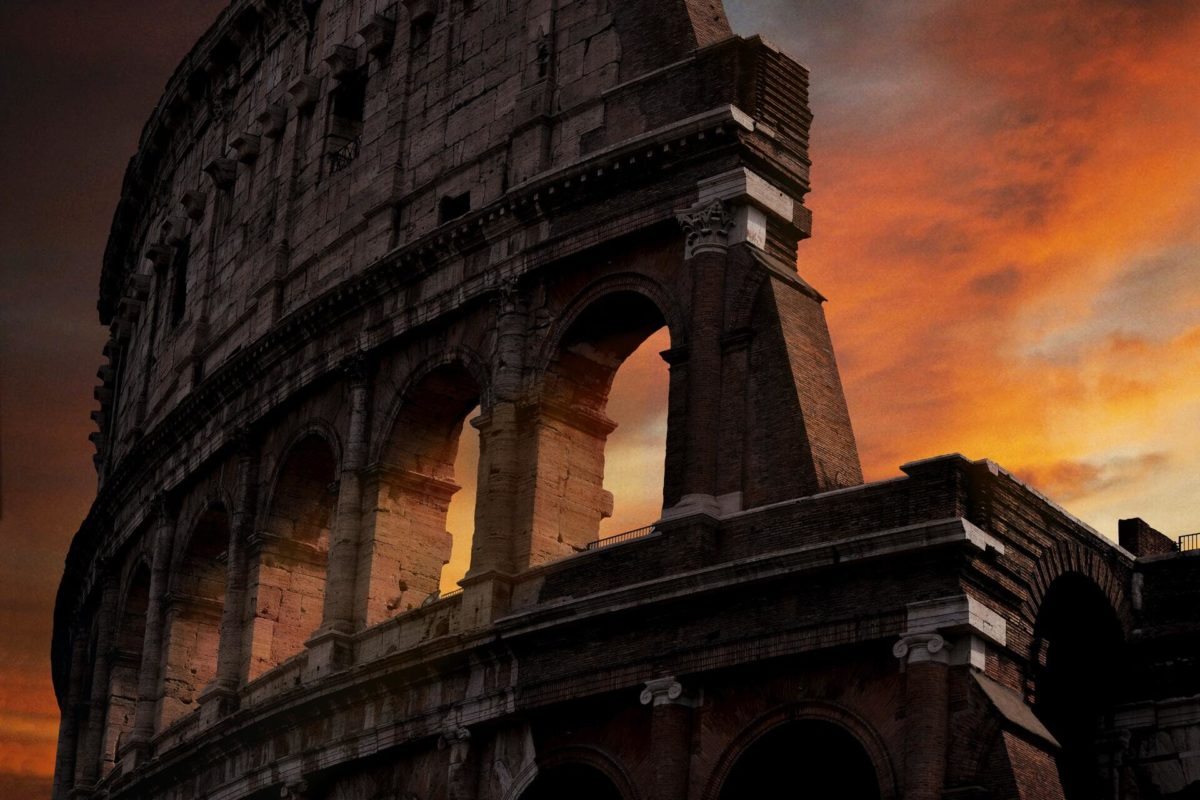
Rome by Night e-bike Tour
City sightseeing Rome at sunset by electric bike The best places to see in the City at sunsetAdmiring the beauty of Rome by night is an unforgettable experience: famous monuments, majestic fountains, churches and ancient buildings are tinged with warm colours, in a game of lights and reflections on the marbles and the ancient structures […]
Adult (Age 11-99) € 48.00 Children (Age 6-10) € 24.00
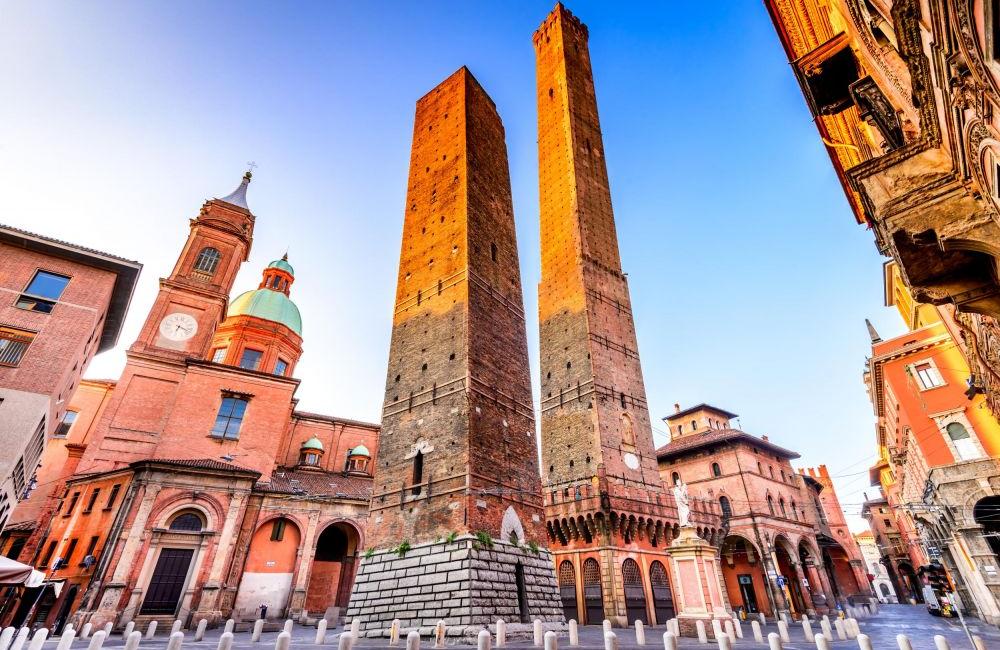
Bologna group walking tour
The Bologna group walking tours starts from the amazing Piazza del Nettuno (Neptune Square), where you can admire the iconic fountain. Continuing to Piazza Maggiore you will discover the imposing Basilica of San Petronio, one of the largest in the world, and the Meridiana. Visit the Archiginnasio, the oldest library in the world, and walk […]
€25 (Kids: €15)
This website uses cookies to improve your browsing experience and analyze the use of the website. Learn More

Self-Guided Walking Tours of Barcelona

- Self-Guided Barcelona Gaudí Tour: This self-guided tour will take you to all of the main Gaudí sites. As they are spread out, we will need to twice jump on the metro system. If you are planning on paying to enter the Gaudí houses, the monumental zone of the Park Güell , or la Sagrada Família , you should plan ahead and book tickets to avoid the lines. Antoni Gaudí was a well known architect, whose very distinctive style can be seen throughout Barcelona. Read more about him on his Wikipedia page.
- Self-Guided Gothic Tour of Barcelona: This self-guided tour will show you all the main sights of the Mediterranean’s most vivacious city from the Barcelona Cathedral to the Jewish Quarter. You'll discover some of the most beautiful views and awe-inspiring architecture spanning centuries. As a self guided tour you choose the pace and how long you want to spend at each location.
- Self-Guided Food Tour of Barcelona : Explore the tastier side of Barcelona with this self guided tour!
Choose a Destination... I want them all PLUS general travel tips. Amsterdam Berlin Boston Charleston Chicago Dubai Lisbon London Los Angeles Miami Nashville New York City New Orleans Paris Philadelphia Prague Rome San Francisco Washington DC
About The Author

Stephen Pickhardt
North america, united kingdom & ireland, middle east & india, asia & oceania.
Black Friday: Up to 15% off selected tours
Prices shown include discount | Offer ends November 28th at 11:59pm PST
Home / Blog / Destination / Spain / Barcelona / How to Take a Self-Guided Gothic Quarter Walking Tour
How to Take a Self-Guided Gothic Quarter Walking Tour
Barcelona’s Gothic Quarter is jam-packed with fascinating history and hidden gems. Its winding streets, towering stone buildings, and unique shops and storefronts all have stories to tell from the city’s past. With its medieval alleyways, small squares, and secret corners, this is one area that you simply can’t miss.
Barcelona is the perfect city to explore on foot, as even a short stroll can take you through six centuries of architecture. Going on a Gothic Quarter walking tour allows you to confront the city’s history up front as you walk the same steps its residents have taken for hundreds of years. What’s more, it’s so easy to take a self-guided Gothic Quarter tour with our handy insider knowledge.
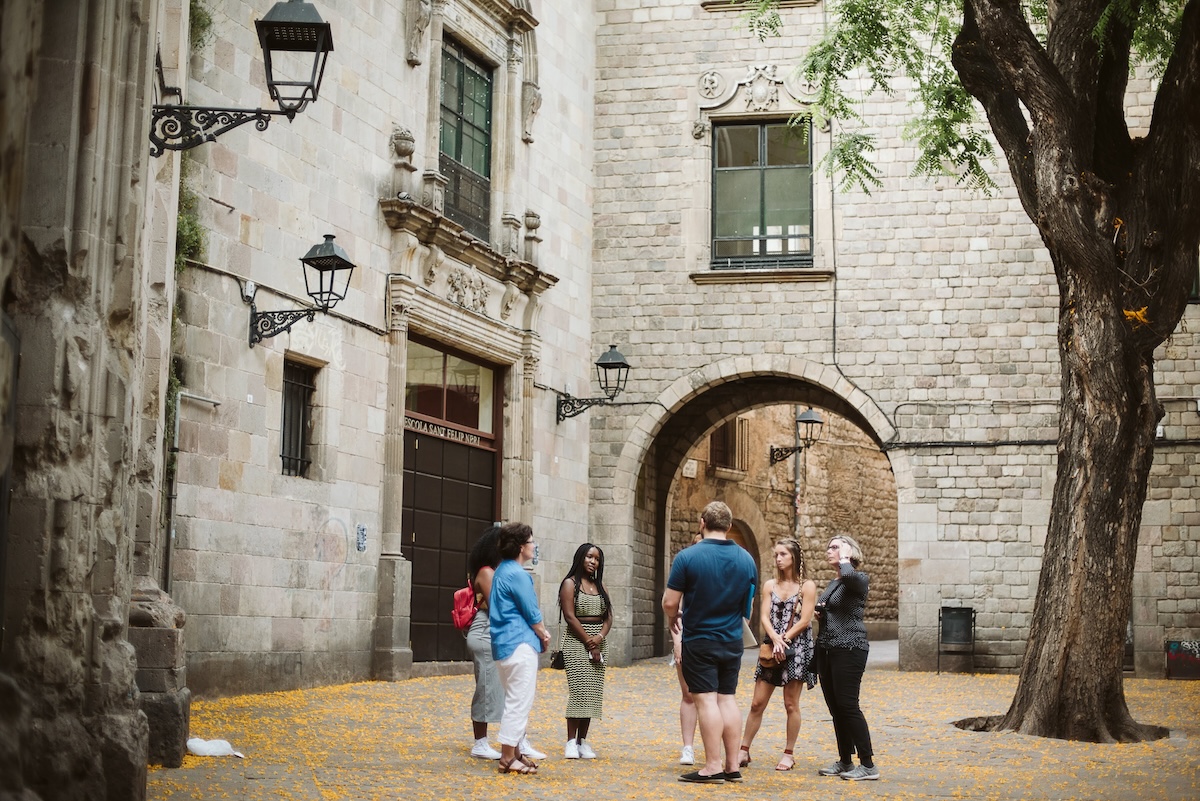
Discover Plaça Nova and the Cathedral
No trip through the Barri Gòtic would be complete without a visit to the Cathedral of Barcelona in Plaça Nova. Start your Gothic Quarter tour here by taking a walk around this imposing structure and then look up. In addition to traditional gargoyles on the roof, you’ll also find curious animals like unicorns and elephants.
Construction of the cathedral took place between the 13th and 15th centuries, but it got a facelift for the World Expo in 1888. If you walk around the right-hand side, you’ll see that its façade stops abruptly. This is because the city decided to save money by only renovating the parts of the building that would appear in photos.
The cathedral is beautiful inside as well. There are a variety of ticket options depending on what you want to see and do once inside.
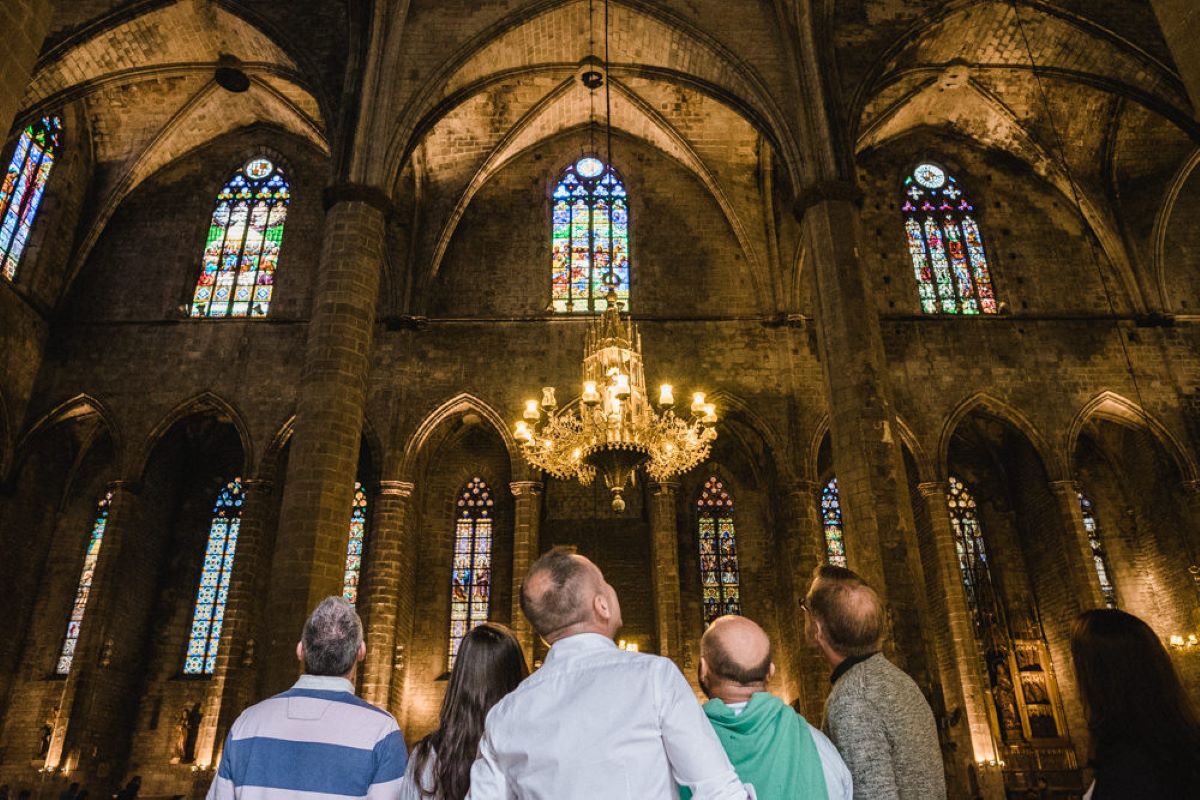
What to see in the Gothic Quarter next: Plaça de Sant Josep Oriol and Plaça del Pi
From Plaça Nova, head down Carrer de la Palla and sneak your way through the iconic narrow streets of the Gothic Quarter. After a few minutes, you’ll enter Plaça de Sant Josep Oriol.
This lovely square is home to the Basilica de Santa María del Pi . In years past, the wealthy residents of Vila de Gràcia would go to church here. While they worshiped, their drivers would hang out at Bar del Pi . This place has been open since the 1920s and previously served as a stable in the 18th century. In the 1930s, the Unified Socialist Party of Catalonia was founded here.
The masses gather at Plaça del Pi during the La Mercè festival to watch castellers climb and weave together to make impressive human towers. In addition to its colorful history, Bar del Pi is the perfect place to stop for tapas and a glass of vermouth or cava .
Plaça del Pi has plenty more to offer:
- If you’re lucky, your visit will coincide with the artisanal food market held here.
- Otherwise, grab something sweet at Granja Dulcinea ( Calle de Petritxol, 2 ). Opened in 1941, this is one of the best places for chocolate in Barcelona .
After your sugar fix, head to the far side of Plaça de Sant Josep Oriol. Take Carrer de l’Ave Maria, then head down Baixada de Santa Eulàlia.
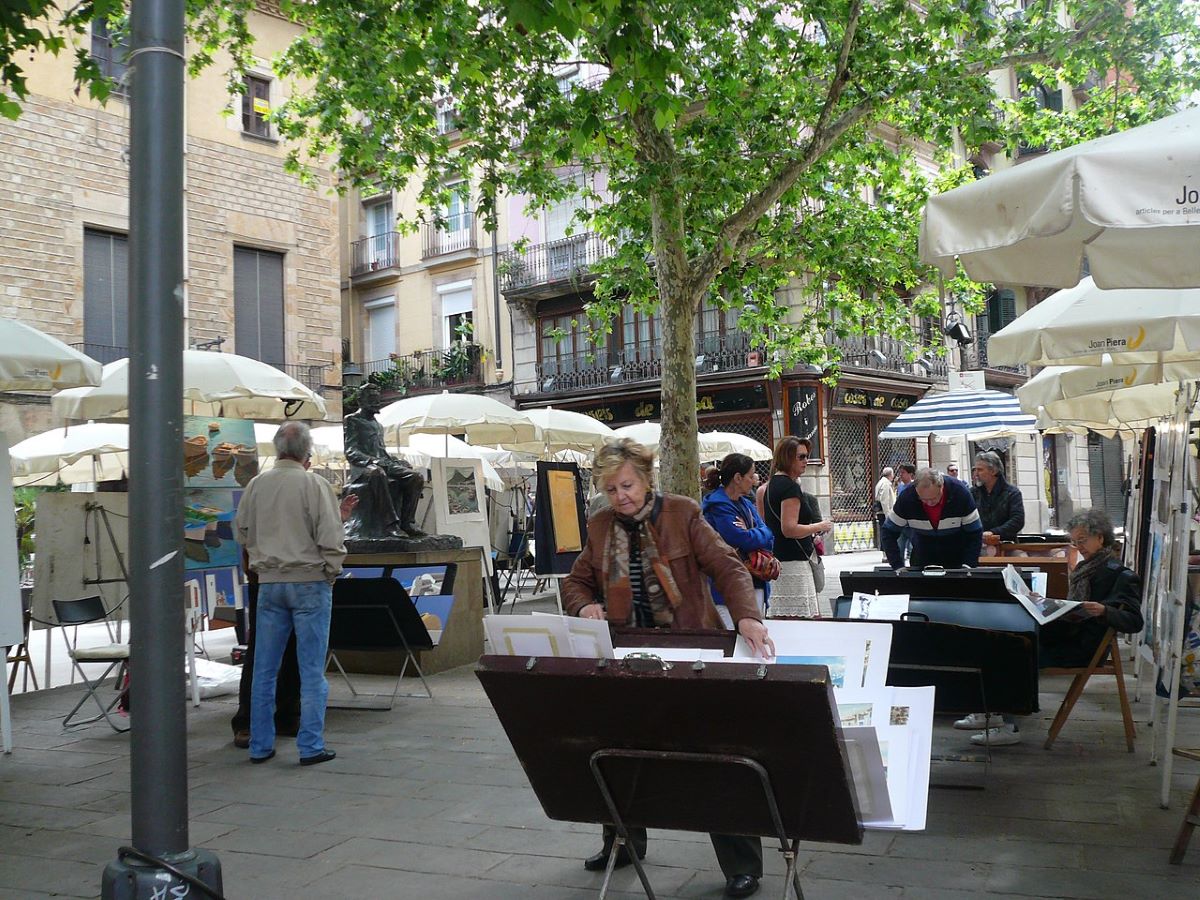
Continue your guided tour of Barcelona in Plaça de Sant Felip Neri
This is a more solemn stop on our tour of Barcelona’s history. Laid bare across this city’s beauty are harrowing reminders of its past, and Sant Felip Neri is the perfect example. At first glance, this square is peaceful and unassuming, with a small fountain and a baroque church. But if you look deeper, you’ll find pain etched into every stone.
In 1938, during the Spanish Civil War , Mussolini’s troops dropped bombs on civilian targets in this very plaza. Several schoolchildren were killed after seeking safety in the shelter below the church, which collapsed. Cracks and chips still cover the facade of the Església de Sant Felip Neri.
Today, the square is a school playground during the day, the terrace for a hotel restaurant in the evening, and a local hangout in the early hours of the morning. The visible damage to the church’s exterior, especially when combined with the sound of children playing, serves as a stark reminder of what can happen when society falls apart.
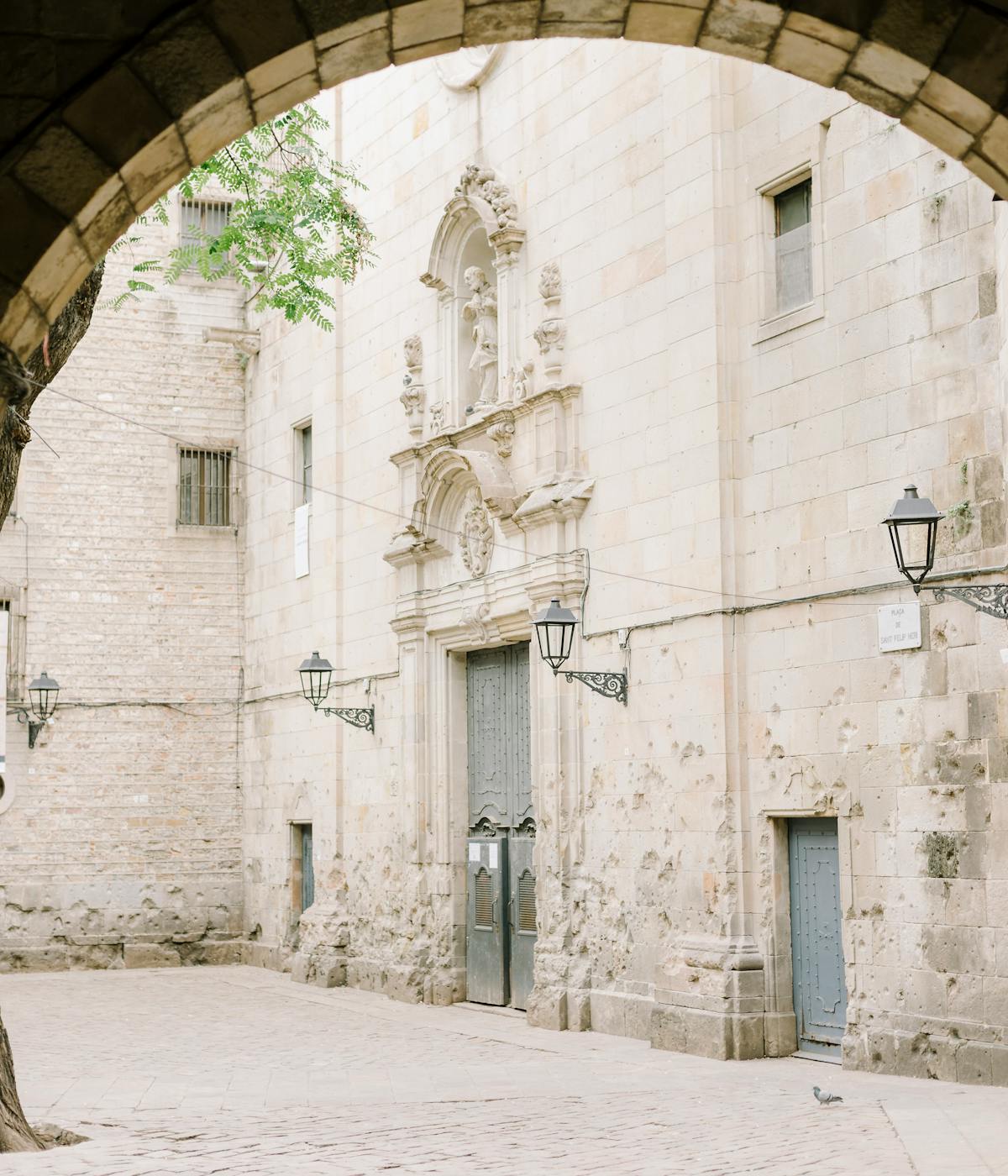
Plaça del Rei: Where your self-guided walking tour of Barcelona lets you step back in history
Head down Carrer de Montjuïc del Bisbe, then take Carrer de la Pietat through the General Archive of the Crown of Aragon . Upon exiting the archives, you’ll find yourself in Plaça del Rei , home to an interesting story:
- Legend has it that the steps in the left corner of this square are where Christopher Columbus presented his bounty after discovering America. Whether or not this story is true, Columbus’ findings had an important impact on Barcelona.
- Until this point, it was the prosperous capital of the powerful region of Catalonia. But after trade began with the Americas, Andalusia became the peninsula’s trading center.
- Due to this, along with the Spanish Inquisition and various plagues, Barcelona fell into neglect and didn’t regain its status until the Industrial Revolution.
However, we have Barcelona’s bad fortune to thank for the Gothic Quarter. If money had continued to flow, the structures you see today would have been knocked down to make room for more modern and fashionable buildings.
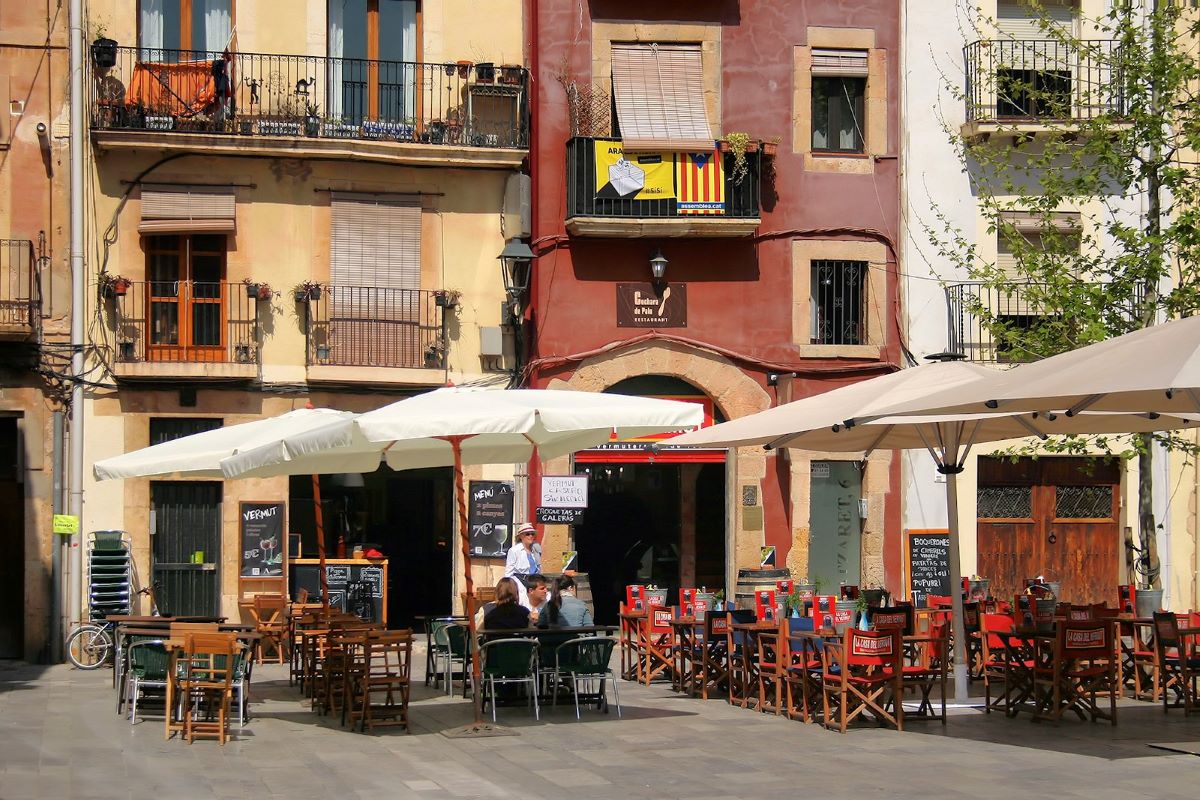
Eating in Barcelona on a budget: Plaça de Sant Jaume
From Plaça del Rei, take Carrer del Veguer and pass the MUHBA history museum . Crouch down to look through the low windows at the remains of Roman Barcelona. You can even explore them under the cathedral.
If you’d rather stay above ground, follow Baixada de la Llibreteria to Plaça de Sant Jaume. This has been the political center of Barcelona for 2,000 years. It’s often a venue for demonstrations and peaceful protests.
We’ll finish this self-guided walking tour of Barcelona with a stroll to the shoreline, and where to eat in the Gothic Quarter :
- On your way to the water, stop at Bodega La Palma ( Calle de la Palma de Sant Just, 7 ) for patatas bravas and croquetas . Today it’s known for tapas, but it used to be a famous Bohemian hangout frequented by Picasso and his contemporaries.
- Just five minutes away, you’ll find La Plata : a local institution beloved for its food, atmosphere and staff. The manager, Pepe, is there every day. Grab a table or a spot at the bar and enjoy the fried fish, tomato and onion salad, butifarra and, house vermouth.
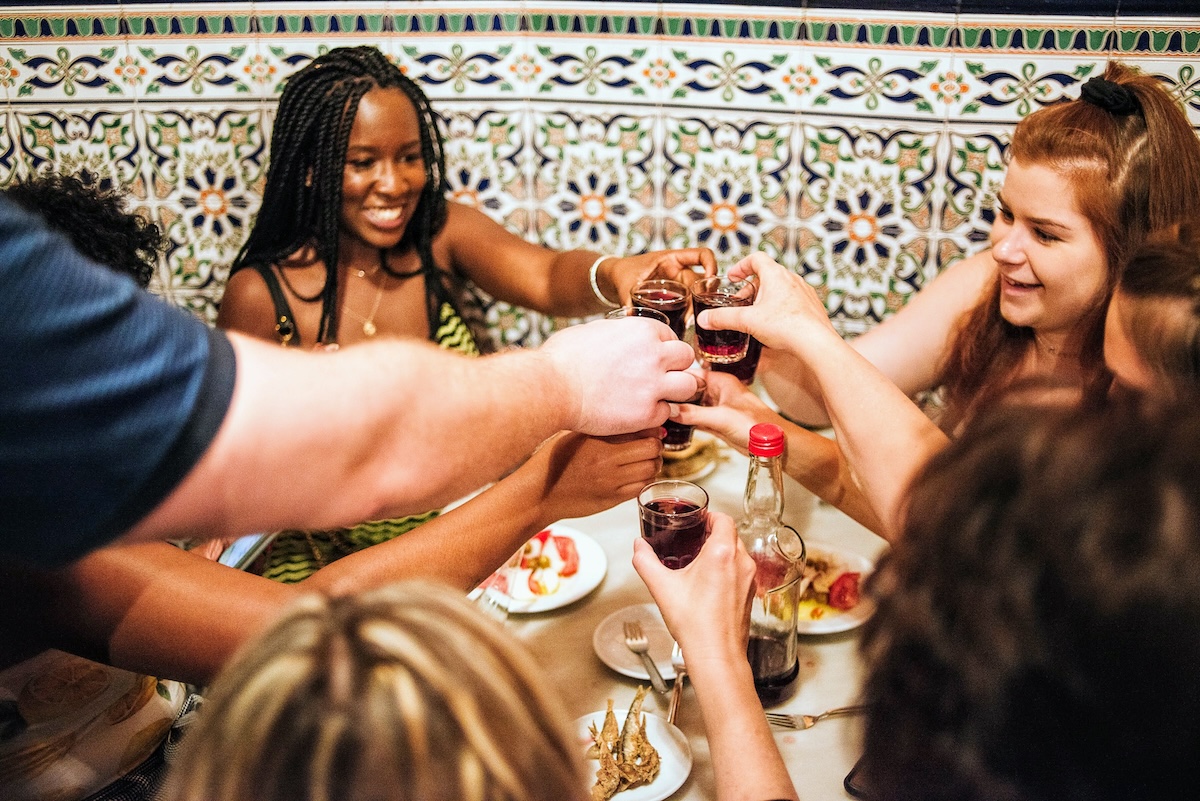
Update Notice: This post was updated on April 26, 2024.
Want to discover the real Gothic Quarter away from the hoards of tourists? Why not join us on our Barcelona Tapas, Taverns & History Tour where our knowledgeable guides will take you through the Gothic Quarter to authentic tapas bars, explore Roman to Moorish architecture, and uncover secrets of Barcelona’s past.
Most helpful
Thanks so much for reading!
Leave a Reply Cancel reply
You must be logged in to post a comment.
- Skip to content
- Skip to primary sidebar
- Skip to footer

Somto Seeks
Navigate the world with confidence
A Self-Guided Gaudi Walking Tour of Barcelona with Map
November 28, 2018 By Somto Ugwueze Leave a Comment
Last Updated on April 1, 2023

You can’t visit Spain without experiencing the out-of-this-world creations of Antoni Gaudi, the iconic Catalan architect. Influenced by elements of Art Nouveau, Gothic, and traditional Catalan architecture, built some of his greatest works in Barcelona. His modernist buildings are sprinkled around the city, and you can visit them through your own self-guided walking tour. This post shows you how to design your own self-guided Gaudi walking tour of Barcelona . You’ll also get a map with a route you can follow to see 6 Gaudi masterpieces in one day or over the course of a few days.
Disclaimer: this post contains affiliate links as explained in my disclosure policy
First, the truth about Barcelona…
If you’ve read my Self-Guided Walking Tour Barcelona , you know that I think this city is overhyped. You’ve probably read or heard a million times that Barcelona is the number one city to visit in Spain. I beg to differ. After living in Spain for 1.5 years and visiting almost every autonomous community, I compiled a list of the 8 most beautiful and underrated cities to visit in Spain.
I’m not mentioning this just to bash Barcelona – far from it. I believe Barcelona is definitely worth a visit, especially because of the Gaudi architecture I’m going to talk about in this post. I just don’t want you to go to Barcelona thinking that it’s the best that Spain has to offer. Catalan culture and history are definitely worth exploring, and you could even venture to other less-touristy towns like Girona and Sitges. Still, if you’re looking for the ‘typical’ Spanish experience you have in mind, you’ll have to venture south. What’s the best place to experience the essence of Spain? In my humble opinion, that would have to be the beautiful Andalusian city of Granada !
Gaudi walking tour logistics
Total distance : 4 miles Walking time : approximately two hours if you follow the route without stopping. I’d recommend you reserve half a day for this tour if you want to spend a good amount of time at each place. Also, it may be a lot to see all six Gaudi sites in one day so another option would be to break the tour up over two days.
Items to pack
Comfortable shoes – wearing some running shoes with soles that provide support. The Nike Air Max Thea Sneaker is a great choice. Portable Wi-Fi – I use the Travel WiFi Portable Hotspot device to access reliable Wi-Fi abroad. it’s a better alternative to using SIM cards or racking up roaming fees. It’s also really convenient and reliable. You can read my full review of Travel WiFi Wireless to seek if it’s the right pocket Wi-Fi for you. Water – stay well hydrated, especially if you visit in the summer! Map or GPS – with pocket Wi-Fi, you can access Google maps or Apple maps on the go. In Spain, Google maps’ directions may be a little off (in my experience, at least). A good alternative would be the Moovit app, which is free to download. Camera – A DSLR will capture those Gaudi buildings so much more beautifully! I always recommend the Nikon D3400 for beginner photographers. It’s very simple to use. Snacks – pack some fruit, cookies, or some other snacks if you get hungry easily, like me. My go-to travel snack, the WanderBar , is a protein bar made specifically for travelers and frequent flyers. I can’t get enough of the Cocoa Crunch flavor.
Gaudi Walking Tour of Barcelona with Map
Our first stop on this walking tour is Park Guell, the whimsical, cartoonish park that looks like something out of a Dr. Seuss book. It’s like a wonderland of gingerbread houses, quirky pathways, and mazes. Park Guell, which was opened to the public in 1922, is one of Gaudi’s most visited buildings in Barcelona. The park was officially commissioned by a Catalan businessman called Eusebi Guell in 1890. He wanted Gaudi to build a ‘garden city’ inspired by nature. The park is perched on a hill in the El Raval district overlooking Barcelona. The history of Park Guell is just as interesting as the park itself!

You can tour the public park for free, but you’ll need a ticket to get into the main fantasy world, known as the monumental zone. You should definitely buy your ticket online to save you from waiting in line. I’d purchase my ticket at least a couple of days in advance because this park is very popular with tourists.
Beware of crowd control at Park Guell
Another thing to keep in mind is that there is a limit on the number of people who can enter the monumental zone each hour. This goal is to maintain control over the crowds. That’s another good reason to purchase your ticket online before you go. A great way to make the most out of your visit to Park Guell is to do a walking tour with a live guide .
With this tour, you also get to skip the lines, and you won’t have to worry about the hourly limit on the number of visitors. A local guide will walk you through the monumental zone and explain all the parts in a way that is fun and engaging. That’s why I always use and recommend Get Your Guide tours. I always leave with something memorable that I learned and a notes app filled with interesting details about the destination that I couldn’t find online.
Address : Carrer d’Olot, 13, 08024 Barcelona, Spain Hours : Every day from 9:30 am – 7:30 pm Distance to next stop : 0.6 miles
Casa Vicens
Casa Vicens is one of Gaudi’s lesser-known works, but it’s definitely worth a visit. In fact, it is the first private residence that Gaudi ever designed. Located in the Gracia neighborhood, Casa Vicens was opened in 1888. It’s a townhouse designed with bricks and features many colors and patterns in orange, beige, and green hues. Gaudi built this house for the wealthy Vicens family to use as their summer vacation home.
If you’d like to experience Casa Vicens fully, I’d recommend you book a tour with an audio guide or a guided tour with a live guide. With the first option, you can skip the lines, access the building, and tour it on your own as an audio guide, staying as long as you’d like. With the second option, you’ll have a local guide showing you around the building and explaining the history and significance of each level. After the 1.5-hour tour, you can explore the building at your own pace and revisit the areas you liked the most.

Address : Carrer de les Carolines, 20-26, 08012 Barcelona, Spain Hours : Every day from 10 am – 8 pm Distance to next stop : 0.8 miles
Completed in 1910, Casa Milà was built for a wealthy couple – Pere Mila and his wife Roser Segimon. Funnily enough, Barcelona residents are the time thought the house was hideous! It had an unconventional exterior with contoured waves made out of gray stone. That’s how it got the nickname ‘La Pedrera’ which translates to ‘the Quarry House.’ Nowadays, people from around the world flock to see this building that was once considered ugly. Isn’t it amazing how people’s tastes change from generation to generation?
The best way to experience Casa Milà is to do a tour with an audio guide . With this tour, you get to skip the line and also view the house from the rooftop. The vantage point from the rooftop is really amazing! You’ll also have a narrator speaking in your ears and explaining what you’re looking at. That way, you can leave with an appreciation for the building, its history, and its significance to the city of Barcelona.

Address : Provença 261 – 265, Passeig de Gràcia, 92, Barcelona Spain Hours : Every day from 9 am – 11 pm Distance to next stop : 0.3 miles
Casa Batlló
Just down the street from Casa Mila, you’ll find another one of Gaudi’s famous houses, Casa Batlló. The shape is similar to that of Casa Mila, but the exterior is much more colorful. This is by far my favorite of all the houses that Gaudi built in Barcelona. Unlike Casa Mila, the building was actually not built from scratch. The wealthy Batllo family were the owners of the home. They commissioned Gaudi to demolish their existing home and build a new one. Instead, Gaudi simply refurbished it and added his signature waves on the exterior. The best way to see Casa Batlló is to do a tour with an interactive audio guide . You can skip the lines and explore all of the building at your own pace, with an audio guide explaining everything you’re looking at on the tour.

Address : Passeig de Gràcia, 43, 08007 Barcelona Hours : Monday-Wednesday and Friday from 9 am – 8 pm Thursday and Saturday from 9 am – 10pm Distance to next stop : 0.4 miles
Casa Calvet
Gaudi’s buildings are famous for their eclectic, somewhat eccentric designs, but Casa Calvet is an exception. It actually just looks like a normal building with a heavy Baroque influence. Casa Calvet is located in the Eixample district, where you’ll also find La Sagrada Familia. Gaudi built it for a textile manufacturer known as Pere Martir Calvet to use as both his factory and residence. Unlike the other buildings on this list, you cannot go inside Casa Calvet. You can only have a look at the exterior and keep moving. If you want to check off every single Gaudi building from your list, then you can make a quick stop here. Otherwise, you can skip and head to the next place on this list.

Address : Carrer de Casp, 48, 08008 Barcelona, Spain Hours : Not open to the public Distance to next stop : 0.7 miles
Cascada Monumental

Gaudi didn’t just build houses. He also built the Cascada Monumental fountain at Parc de Ciutadella, the only park in the entire city of Barcelona. This park is a great place to sit and relax a bit when you tire of walking around the city. The ornately-decorated Cascada Monumental is located at the north of Parc de Ciutadella. It reminds me of the lake at Retiro Park in Madrid. Some people compare it to the Trevi Fountain in Rome, but I’m not sure about that. You’ll have to see for yourself. Visiting the park and the fountain is free.
Address : Passeig de Picasso, 21 | Ciutadella Park,08003 Barcelona, Spain, 08003 Hours : Every day from 10 am – 10 pm Distance to next stop : 1.2 miles
La Sagrada Familia
Well, I saved the best for last. I’m sure you’ve heard about La Sagrada (Church of the Holy Family) Familia a million times. There’s a good reason for that. This basilica is easily Gaudi’s greatest masterpiece. Gaudi devoted his final years to building La Sagrada Familia but never completed it. In fact, the basilica is still under construction as of today. The completion date is 2028, almost 150 years since construction began.

For me, the most impressive part of La Sagrada Familia is the interior, built in the Gothic style. The best way to experience La Sagrada Familia is through a guided tour with access to the Nativity Tower . You can skip he lines and explore the interior and the towers higher up the building while learning about the famous church from a local guide. If you’d rather just see the interior of the church, you can go with this guided tour of La Sagrada Familia . A local guide will show you around the arches, sculptures, ceiling, stained glasses, and altar and explain the history and symbolism behind it all. To make sure you’ll fully prepared for your visit, also check out the 5 mistakes to avoid when visiting La Sagrada Familia.
Address : Carrer de Mallorca, 401, 08013 Barcelona, Spain Hours : Every day from 9 am – 6 pm
There you have it – your very own self-guided Gaudi walking tour of Barcelona. Which of these Gaudi sites are you most excited to see?
Travel Resources I Love
Travel WiFI Pocket WIFI Device – With portable WiFi, you can say goodbye to ridiculous roaming charges and SIM cards for good. I’ve been using the Travel WiFi Portable Hostspot device for years and love the peace of mind it gives me. The device provides 3G-4G WiFi for at least 6 hours and works in 100+ countries. In my experience, it lasts 9 hours. It also works in a variety of landscapes and terrains. I even filmed a Facebook Live from a boat in the Atlantic Ocean using my device. I can also use Google Maps, request an Uber, call my mom, and do tons of other things I couldn’t do before. Quick tip: turn off the device when you’re not using it so that the battery can last longer.
Booking.com – Booking.com is my go-to website for booking discounted accommodations around the world. What I love most about Booking.com is the variety of properties you can find, from luxury apartments to treehouses to university housing. It’s hard to beat the insanely low prices. The website also has a flexible cancellation policy, which is great if things come up or you change your mind.
Skyscanner – Skyscanner.com is my go-to website to search for flights. It’s hard to beat the prices! I’ve snagged a $24 direct flight to Milan, a $30 flight to Berlin, a $400 roundtrip ticket to Colombia, and a $500 roundtrip ticket to Japan. I’ve been using Skyscanner since I studied abroad in Spain back in 2012. I check the website along with the Hopper app to determine the best time to buy tickets.
For more travel product recommendations, check out my travel essentials page .
Continue reading…
The 7 Best Day Trips From Barcelona: Roman Ruins To Moorish Palaces
If you liked this post, don’t forget to share it!

Somto Ugwueze
Hi! I'm Somto. Two years ago, I stopped making excuses, ditched my indecisive friends, and started booking flights. Today, I'm a full-time solo traveler on a mission to inspire young women to seek new adventures.

@somtoseeks

Reader Interactions
Leave a reply cancel reply.
Your email address will not be published. Required fields are marked *
Save my name, email, and website in this browser for the next time I comment.

Who Is Somto Seeks?
Hi there, I’m Somtochukwu. Can you try pronouncing that? I've always gone by Somto (Sohm-toe). I'm a child of Nigerian immigrants who decided to pursue her dream of living an extraordinary life. In 2015, I chose faith over fear, packing my bags and moving to Spain with $1,000 in my pocket. This was after being diagnosed with an autoimmune disease that caused me to develop a giant bald patch in the middle of my scalp. Living in Spain and traveling around Europe for a year changed my life forever, allowing me to discover the freedom of solo travel and the freedom of working from anywhere. Today, I’m a full-time travel writer whose mission is to help you navigate this big, beautiful world with confidence and have those omg-pinch-me-moments you’ll remember for a lifetime.
Grab my first guidebook, Europe by Train!

Experience the ultimate adventure across Europe by train with this detailed guidebook with 50 routes expertly created from travel insiders, including myself. You'll explore the most amazing attractions that Europe has to offer, from Roman ruins to off-the-beaten-path villages and everything in between. Get ready for the adventure of a lifetime!
Ready for your solo trip?
I believe that traveling solo doesn't have to be scary. In fact, it should be fun and seamless! Sign up for my solo travel resource library to get everything you need for total peace of mind on your solo adventures.
- Boating Holidays
- Asia & Pacific
- Australia & New Zealand
- Central America
- Indonesia & Indian Ocean
- Middle East
- Scandinavia
- South America
- Business Travel
- Culinary Travel
- Wellness Travel
- Golf Travel
- Travel Style
- Travel Gear
- Travel Fashion
- Real Estate
- Destination Weddings
- Fishing Holidays
- Tricks & Hacks
- Travel News
- #WHERETONEXT
- Read All the Issues
- Working with DRIFT Travel
- Submit Your Photos to DRIFT Travel
- DRIFT Travel Magazine Media Kit

Self-Guided Walking Tour of Barcelona’s Gothic Quarter
Nestled within the heart of Barcelona, the Gothic Quarter stands as a living testament to the city’s rich history, architectural splendor, and vibrant culture. As sunlight filters through narrow cobblestone alleys and dances across centuries-old facades, visitors embark on a journey through time, immersing themselves in the enchanting allure of this medieval neighborhood.
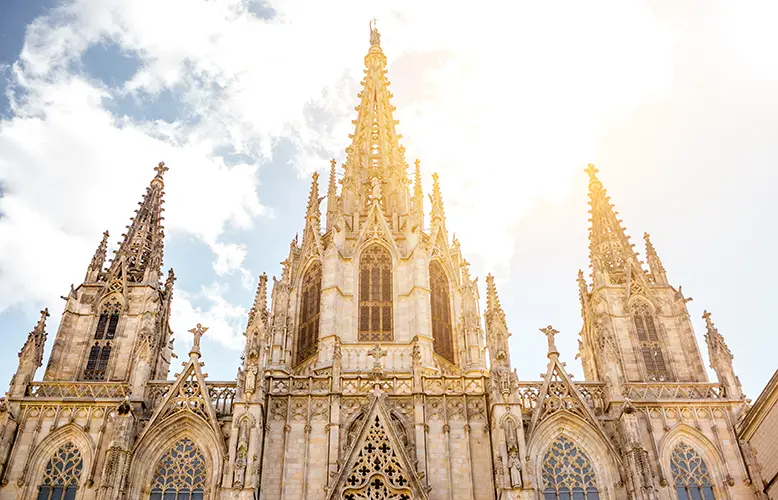
In this bustling metropolis, where the modern seamlessly intertwines with the ancient, the Gothic Quarter emerges as a captivating labyrinth of narrow streets, hidden squares, and storied landmarks. Every step echoes the footsteps of generations past, whispering tales of Roman origins, medieval grandeur, and the spirited pulse of contemporary Catalan life.
Our self-guided walking tour of Barcelona invites you to unravel the layers of history etched into the very stones beneath your feet. As you meander through the labyrinthine streets, each twist and turn unveils a new chapter in Barcelona’s narrative, offering a profound and immersive exploration of one of Europe’s most cherished neighborhoods.
5 Must-Visit Places in the Gothic Quarter
The Gothic Quarter is one of Barcelona, Spain’s most enchanting and historic neighborhoods. Steeped in centuries of history, this labyrinthine area is a treasure trove of medieval architecture, narrow alleys, and charming squares. Here are five must-visit places in the Gothic Quarter.
Plaça Nova and the Cathedral
At the heart of the Gothic Quarter lies Plaça Nova, a bustling square surrounded by historic buildings. The standout feature of this square is the Barcelona Cathedral, also known as the Cathedral of the Holy Cross and Saint Eulalia. The cathedral dates back to the 13th century and is a stunning example of Catalan Gothic architecture. Visitors can explore the interior, including the abbey and the rooftop, for panoramic city views.
Visitors are transported through the cathedral’s doors into a world of religious grandeur and architectural splendor. The interior has soaring columns, rib vaulted ceilings, and a sense of sacred serenity. The abbey, an oasis of tranquility within the bustling Gothic Quarter, features a charming courtyard inhabited by thirteen geese, symbolizing the age of Saint Eulalia, the patron saint of Barcelona.
One of the highlights for those with a penchant for heights is the ascent to the cathedral’s rooftop. Climbing the narrow spiral staircase rewards visitors with panoramic views of Barcelona’s skyline, providing a unique perspective on the city’s architectural evolution from medieval to modern times. The spires and gargoyles create a silhouette against the sky, emphasizing the cathedral’s religious and architectural landmark role.
Plaça de Sant Josep Oriol and Plaça del Pi
These adjacent squares offer a charming blend of history and local life. Plaça de Sant Josep Oriol is dominated by the Church of Sant Josep Oriol, known for its beautiful Baroque facade. The square is a lively gathering spot with outdoor cafes and street performers. Just a short walk away, Plaça del Pi is home to the Basilica de Santa Maria del Pi, a Gothic church with a stunning rose window. The squares are perfect for strolls and soaking in the vibrant atmosphere.
Centered around the imposing Church of Sant Josep Oriol, this square exudes a lively yet relaxed atmosphere. The church, with its Baroque facade adorned with sculptures and decorative elements, serves as both a religious focal point and a captivating architectural backdrop. The square is a meeting place for locals and visitors alike, with outdoor cafes spilling onto the cobblestone pavement. It’s a place to savor a cup of coffee, observe street performers, and soak in the vibrant energy of Barcelona.
Plaça de Sant Felip Neri
Tucked away in a quieter corner of the Gothic Quarter, Plaça de Sant Felip Neri is a hidden gem with a poignant history. The square is surrounded by the Church of Sant Felip Neri, scarred by shrapnel from bombings during the Spanish Civil War. The serene ambiance of the square, combined with its tragic past, creates a moving experience for visitors.
This intimate square bears witness to a tragic chapter in Barcelona’s history, as evidenced by the scars that still mark its surroundings. The square’s centerpiece is the Church of Sant Felip Neri, a modest yet beautiful Baroque structure. However, the gravestones embedded in its walls and the pockmarked facades of nearby buildings tell a somber tale. During the Spanish Civil War, in 1938, the square became the unintended target of a bombing raid, resulting in the loss of numerous lives, many of them children from a nearby school.
Plaça del Rei
Plaça del Rei, or King’s Square, is a historic square that transports visitors back to medieval Barcelona. The square exudes a sense of regality, surrounded by impressive buildings, including the Palau Reial Major (Grand Royal Palace) and the Chapel of St. Agatha. The Museu d’Història de Barcelona (Barcelona City History Museum) is located here, offering a journey through the city’s past with archaeological finds and exhibits.
A collection of notable structures frames Plaça del Rei, each contributing to the square’s unique charm. The Palau Reial Major (Grand Royal Palace) dominates the scene with its regal facade. This palace served as the residence of the Counts of Barcelona and later the Kings of Aragon. The Saló del Tinell, an impressive Gothic hall within the palace, has witnessed significant historical events, including the Catholic Monarchs’ reception of Christopher Columbus upon his return from the Americas.
Plaça de Sant Jaume
This square is the political and administrative heart of Barcelona. Bordered by the City Hall (Ajuntament) and the Palau de la Generalitat de Catalunya (Palace of the Generalitat of Catalonia), Plaça de Sant Jaume is a significant civic space. It has been the site of political and social gatherings throughout history. The architecture surrounding the square is noteworthy, and the atmosphere is vibrant, especially during public events and celebrations.
Exploring these five places in the Gothic Quarter provides a rich tapestry of Barcelona’s history, culture, and architecture, making it a must-visit destination for travelers and history enthusiasts alike.
RELATED ARTICLES MORE FROM AUTHOR
Enchanted Visions of Madeira, Portugal: Discover Véu da Noiva, Guindaste and Rocha do Navio
Global Cheers: Oktoberfest Festivities Worldwide
Making the Most of Your Visit to the Palace of Versailles
Privacy overview.
The Ultimate Guide to the Most Opulent Casino Hotels in London

Bathed by the restless blue waters of the Mediterranean Sea and cradled in the Collserola mountains, Barcelona is a vibrant city with a striking ability to reinvent itself. Throughout its history, the city has served as a Roman colony, a Medieval port, the lodestar of Spain’s Industrial Revolution, and host to the Olympics. Today, Barcelona has become one of Europe’s most cosmopolitan and renowned cultural hubs.
Urbs' audio tours of Barcelona are the ultimate way to see the sights, including the many hidden gems dotted throughout the city. Whether you’re visiting for a day trip or longer, there’s no better way to take it all in than a self-guided walking tour of Barcelona.
The Urbs Way
Listen & discover.
.png)
Enjoy 4+ hours of audio content written by cultural experts Explore 70+ fascinating cultural locations Discover 150+ restaurants, cafes, bars and shops recommended by local writers
Plan your route
.png)
Plan your perfect day with our unique route plotting function You can also use one of our curated routes which can be amended according to interests, schedule and budget
Book tickets

Find out which locations require tickets Book attractions and activities in advance to avoid the queues

Bustling Barcelona
The city of Barcelona holds its own when it comes to world-class attractions, famous artworks and beautiful beaches. With millions flocking to the city every year to get a glimpse of the uber-famous Sagrada Familia, and its beautiful parkland, isn’t it time you came to see what the fuss was all about?
Don’t have the time to research transportation and put an itinerary together? You don’t need to. Using the new Urbs app, you can discover and explore the best of Barcelona, adding your favourite sights to create a bespoke audio tour of Barcelona. Best of all, they’re all recommendations from top local travel experts.
Time on holiday is precious, so don’t lose any of it flicking through outdated maps and dog-eared guide books. Using your mobile and a set of headphones is all that’s required to get started on Urbs. Make sure you download the app before you go
The ‘appy’ way to travel!
Iconic artworks, breathtaking buildings and a cosmopolitan dining scene – you have all this and more to look forward to on your next visit to Barcelona. And what better way to plan it, than with Urbs.
Taking a self-guided walking tours of Barcelona is the best way to tour the city at your own pace, and here’s just a few of the things to add to your itinerary.
World-famous architecture
On your visit to Barcelona, it would be remiss not to visit some of the best architecture in the world. Designed by Antoni Gaudi, the Sagrada Familia is an icon in the city skyline and quite possibly his most famous work. Dare you climb the inner spiral staircase – make sure you wear flat shoes!
Looking for jaw-dropping cathedrals? Santa Maria del Mar is one of the most famous examples of Catalan Gothic design that never fails to impress. Add it to the audio tour and see why people flock to this heritage site.
Green space
This is a city that prides itself on beauty and arts. If you’re looking for a covid-secure space in the great outdoors, Barcelona has a surprising amount of options for a bustlingcity. One of these, that must be visited is Parc Güell. Set in a local beauty spot, these stunninggardens are ordained with tiles and art on the top of a mountain in Carmel Hill. Be prepared forthe epic walk up, although it’s worth it for the views.
There’s no shortage of arts and culture to soak up on your visit to Barcelona. Discover the sights on a self-guided walking tour of Barcelona. People come here from all over the world to marvel at the famous art, be it Gaudi, Picasso or Joan Miró.
Sports galore
For football fans, there’s only one place to start your tour of Barcelona, and that’s the Nou Camp. This international soccer club and supreme stadium is home to FC Barcelona and can be visited as part of your audio tour of Barcelona. Sit in the stands and listen to the noise of the fans, it’s quite something to take in.

Foodie's heaven
Of Barcelona’s many gifts, cuisine is right up there. This is a city that fuses cultures and flavours of all kinds. Wherever you find yourself, it won’t be far from innovative dishes bursting with flavour. Your visit wouldn’t be complete with tapas, so don’t miss the opportunity to try out a local cerveza and patatas bravas – it’s what you came for.
Museums and galleries
Barcelona and art go hand-in-hand, so expect a culturally enriching visit during your stay. The Picasso museum in El Born is one of the most compelling for art-lovers, while the Museum of Modern Art is one of the most famous celebrating contemporary artists. This includes work from everyone’s favourite icon – Banksy, as well as Warhol, Koons and Kusama.
At the other end of the scale, Barcelona has a banging night life and club scene to keep the after-hours fun flowing – many are LGBTQ+ friendly too. Add your favourite picks to you audio tour of Barcelona, so you can plan your day (and night).
The beaches
Pack your speedos and blend in with the locals! Not quite as touristy as the beaches in Portugal, there’s a number of golden stretches to spend your day. Barceloneta Beach is one of the most popular – you have to come with the kids and have a splash about on your visit.

Barcelona by app
Be sure to download the Urbs app to your Android or Apple device ahead of your travels to get the most from it. Here’s a couple of benefits in doing so:
Book attractions
Barcelona is a tourist-heavy destination. Bypass the queues and book tickets to tourist attractions and events via the app.
Discover something new
With loads of audio descriptions to choose from, you’re guaranteed to discover something new on your tour.
Customised travel plan
To get the best out of your trip, create your own itinerary using our easy audio tour guide. Our popular self-guided walking tours of Barcelona can be customised to your personal preferences.
Download the app
Planning a trip to Barcelona? Then don’t miss the chance to access the city in this audio feast, now available to download on Android and iOS devices.
.png)
Ready for your next adventure? Don’t forget to pack your headphones and take Urbs with you.

The Ultimate Insider’s Self-Guided Tour of Gaudi’s Sagrada Familia in Barcelona
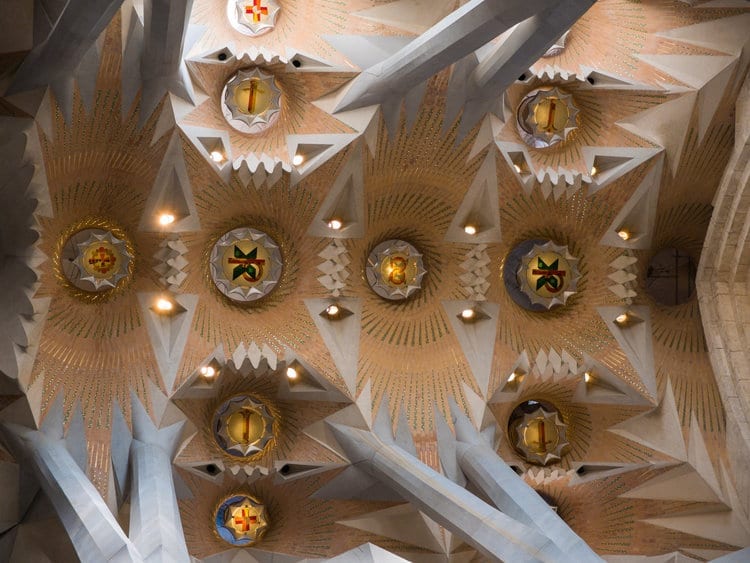
La Sagrada Familia is the beating heart of the city of Barcelona. It can be seen across the skyline almost anywhere you go. The top of the spires peaking out, watching over the city at all times. Designed by Catalan architect Antoni Gaudí , construction began in 1882. And you might be surprised to learn that development is still occurring today. Currently, the best projection for its completion is 2026! A significant year that marks the centenary of the death of Gaudí. Despite its incomplete nature, this is THE MOST important sight to see when visiting Barcelona. Its history, design and the feeling you get upon stepping inside are unparalleled. The church feels like a summation of what Barcelona is all about. And understanding it before visiting or while you tour is essential to better enjoying this fantastic monument.
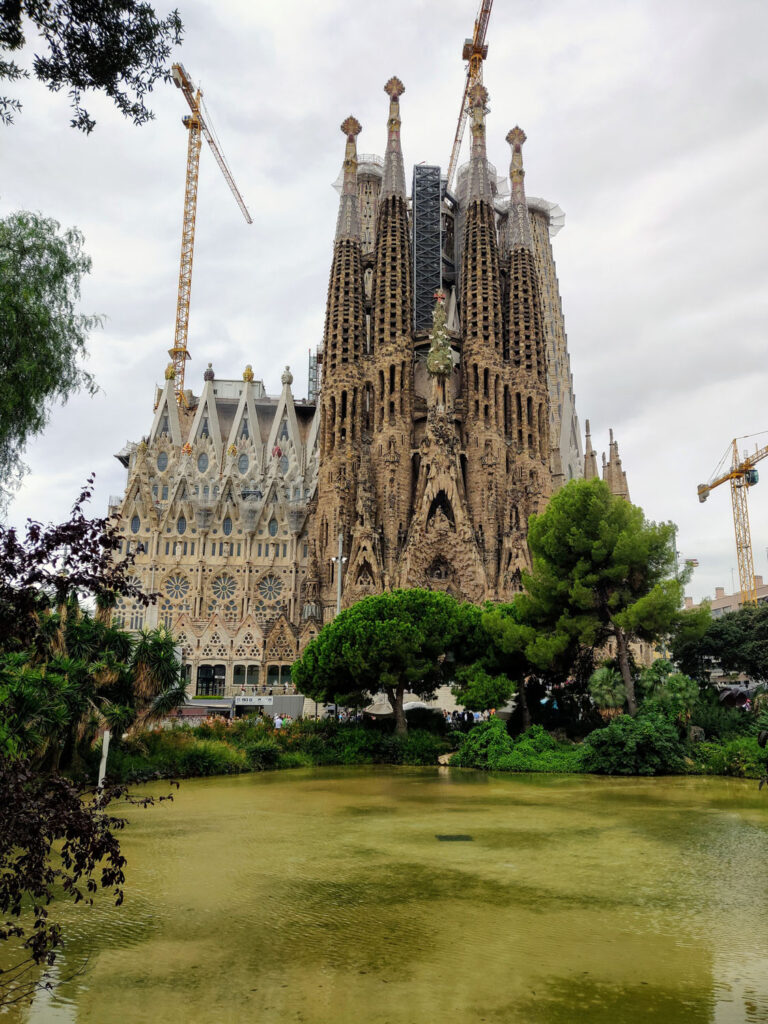
This is a very detailed guide, so I’ve been sure to make a table of contents for you in case you want to jump to a particular church area. This works great if you’re visiting and need more clarification on a certain area. If you’re looking for a shorter summary of what to see, check out my post on the ‘ Top 12 Things to See.’ That guide is ideal if you’re pressed for time and want just the highlights tour !
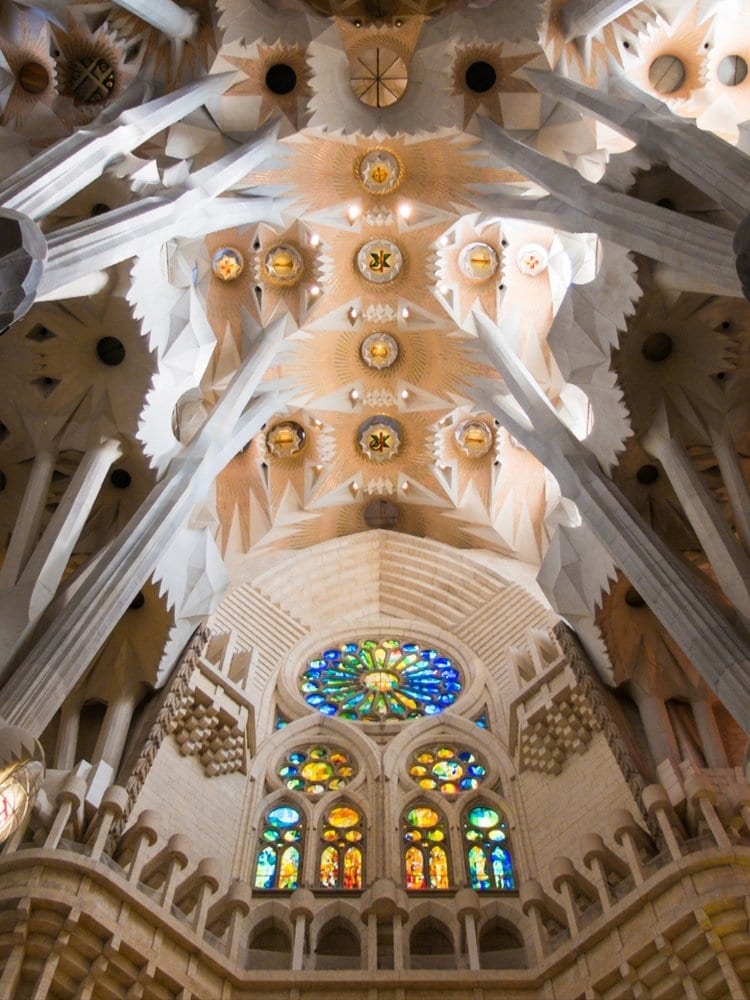
Access & Admission
The Sagrada Familia is pretty easily accessible since it’s located in the centre of town. By metro, you just need to hop on the L5 line towards Sants Station . Upon getting out of the metro, simply follow the signs for the ‘ Sagrada Familia.’ If you are arriving by bus, get on the H10 and get off at the València, Lepant stop. If you bought a Hop-On Hop-Off Bus ticket, these also all stop right in front of the church.
When to Go?
When booking your ticket, you need to select a specific entry time . I’d recommend not leaving it too late. You want to give yourself plenty of time to explore before the church closes. I’d recommend booking your ticket an hour or two before sunset. That way, you can see the building in the light of day and enjoy the magnificent lighting effect of the sunset across the structure. The golden light inside the church casts the most magical glow over the entire nave. And it feels like being transported to another earthly plane of existence.
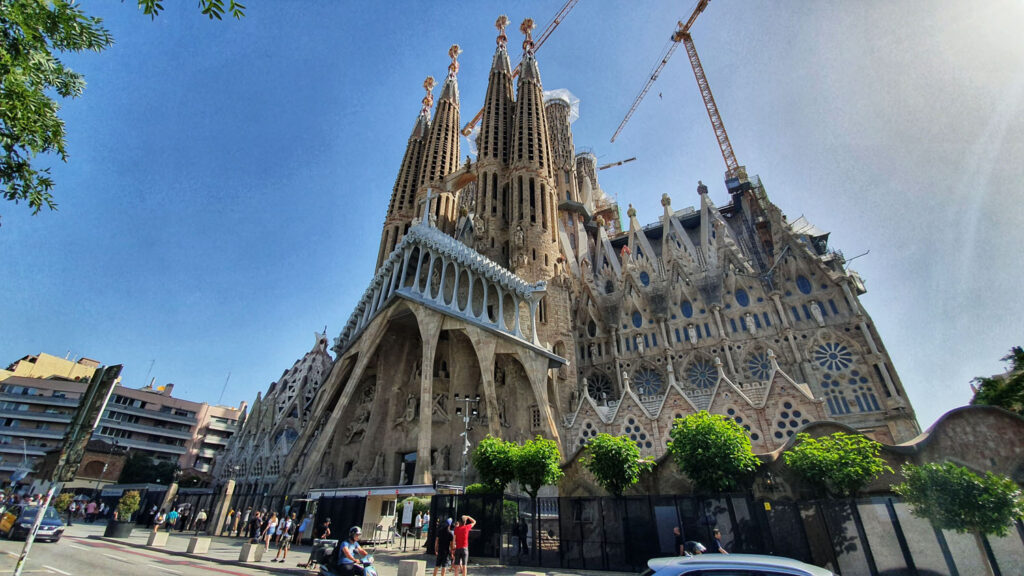
As the Sagrada Familia is the most famous landmark in Barcelona, it draws in some shocking numbers daily. It’s no surprise that thousands of people enter their doors daily. Booking your tickets in advance is always best to ensure you can experience this church easily. You can buy your tickets online up to two months in advance. But I’d advise that you only book them about a week or two before your arrival unless you’re visiting during the holiday season.
Which ticket to buy?
There are basically four ticket types for visiting the Sagrada Familia :
- Basic Ticket 17€
- Audio Guide Ticket 25€
- Guided Tour Ticket 26€
- Audio Guide and Towers Ticket 32€
While I did enjoy my guided tour, and I’d usually strongly recommend them, I felt like the guide rushed us through the church. Fair enough, there is so much to see, and you only have them for an hour. But even still, it felt incomplete. Even though I could go back to what I felt I’d missed after the guided tour, there was so much to see that I wished I could have understood better. That’s why I created this blog!
This self-guided tour allows you to go at your own pace. You can sit and absorb what you’re seeing. Take a moment to just listen to the sounds around you. And learn about all the facets of the church. Plus, this free tour will save you a bit of money. While the towers are interesting to see and give a nice view over the city, there are betters views to be found for a much lower price. So I’d advise skipping them and instead focusing on looking into the building instead of out of it.
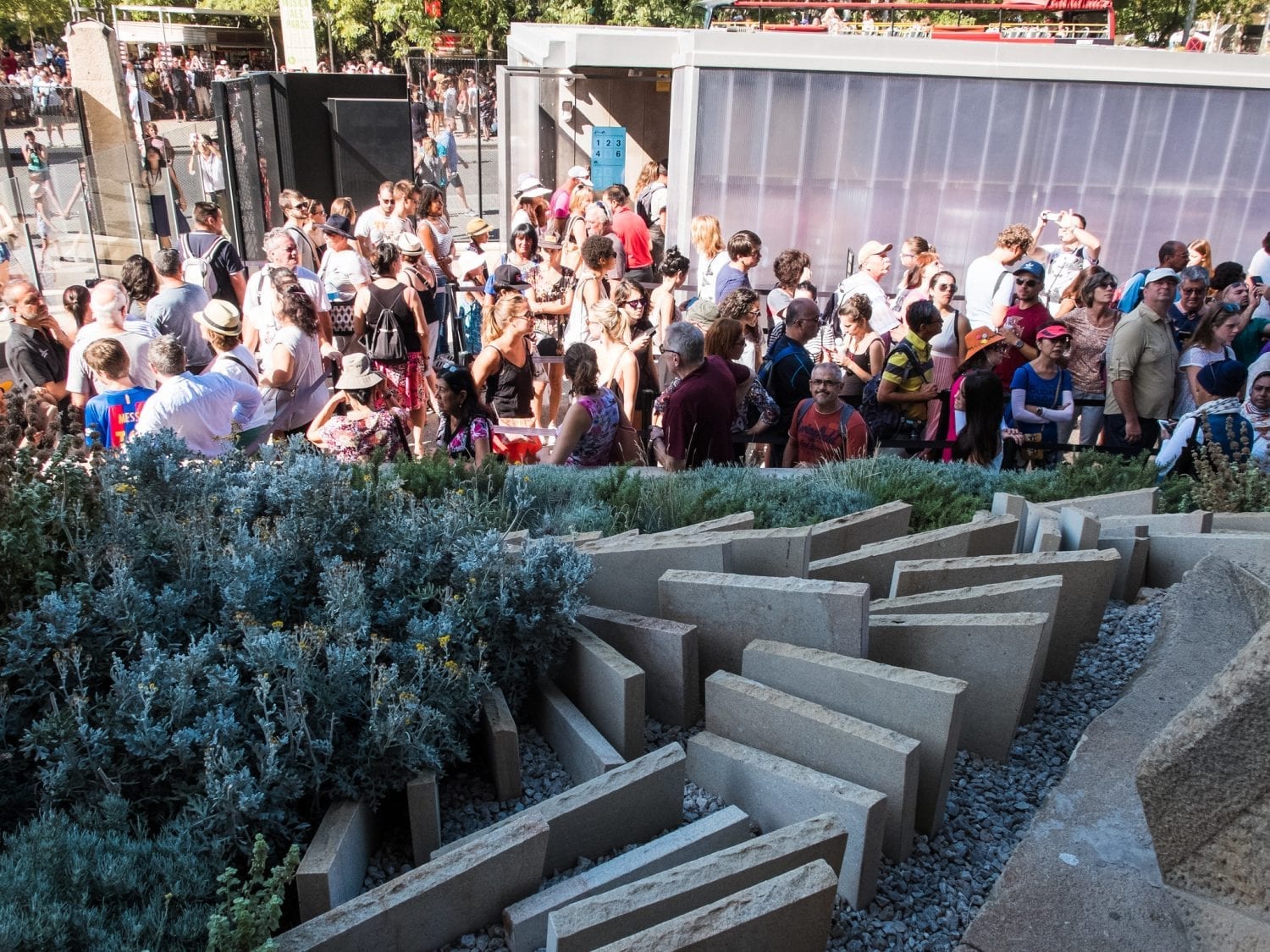
During the 19th century Barcelona, along with the rest of Europe, was undergoing a significant change. The church, which had once held such immense power and authority over cities, now lost its cultural influence with the growth of independent governments. Urban lifestyles were changing the way that Catalonians lived, and more and more, the church was becoming less and less a central part of their daily routine.
In 1866 the Spanish clergy created the Association of Devotees of Saint Joseph . They took it upon themselves to help bring back the relevance of faith and spirituality in Catalonia. They raised enough money to start construction on a wondrous temple. A church is so spectacular and eye-catching that it would be the spot where pilgrims from all over the world would travel and which would encourage locals to come back into the fold. The church was dedicated to the Holy Family. The first architect of the church was Francisco de Paula del Villar y Lozano . But soon after construction started, he resigned. They then enlisted Catalan architect Antoni Gaudí . And that one decision would be the catalyst for the creation of what is now one of the greatest man-made wonders of the world.
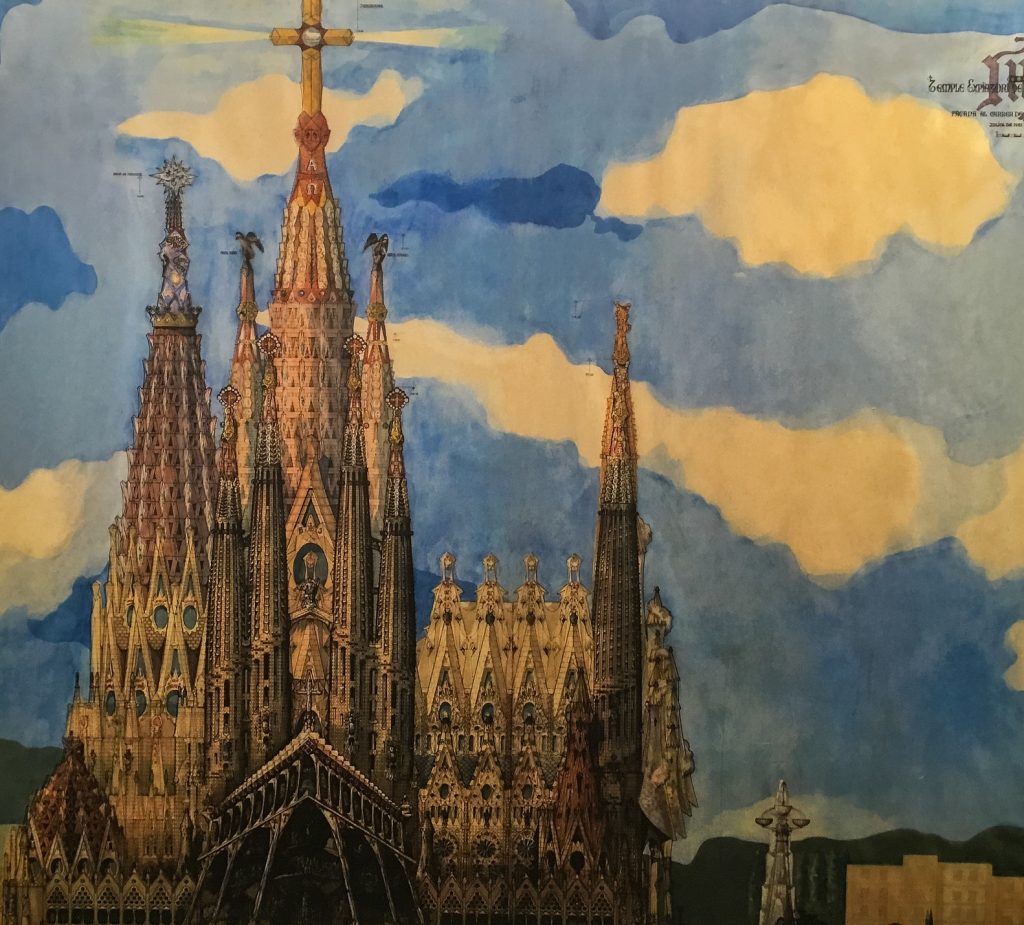
Master Architect Antoni Gaudi
Antoni Gaudí is the mastermind behind this incredible church design. Gaudí’s works can be seen all across Barcelona. And he was one, if not the most, influential artist who helped create the Modernism movement in Catalonia. Gaudí was inspired by neo-Gothic art, organic forms, and Oriental techniques, which can be seen throughout.
Gaudí’s style formed the artistic style of the city, and the critical piece to his portfolio is the Sagrada Familia. Gaudí’s greatest inspirations were nature and religion. In designing the Sagrada Familia, he combines these elements to near perfection. Gaudí’s aim in creating this Basilica was to link heaven and earth together. He was inspired by the nearby Montjuic Mountains’ shape and power over the valley. He wanted the church to feel like a new mountain sprung from the ground.
Gaudi’s Death
Gaudí was run down by a streetcar and died in 1926. Only a small portion of the Basilica had been built when he passed. Although his life was cut short, Gaudí knew he would never see the church finished. He looked back to the great medieval cathedrals which took hundreds of years to create. Some take over 100 years from start to completion. He put every ounce of creativity, innovation and imagination into the temple’s design. When he died, his revolutionary work would inspire the next architect who took over. Many people were surprised that Gaudí would set out to create something which would take so long to build; when asked why, Gaudí would always say, “ My client is not in a hurry.” This is where he got the nickname “God’s Architect.”
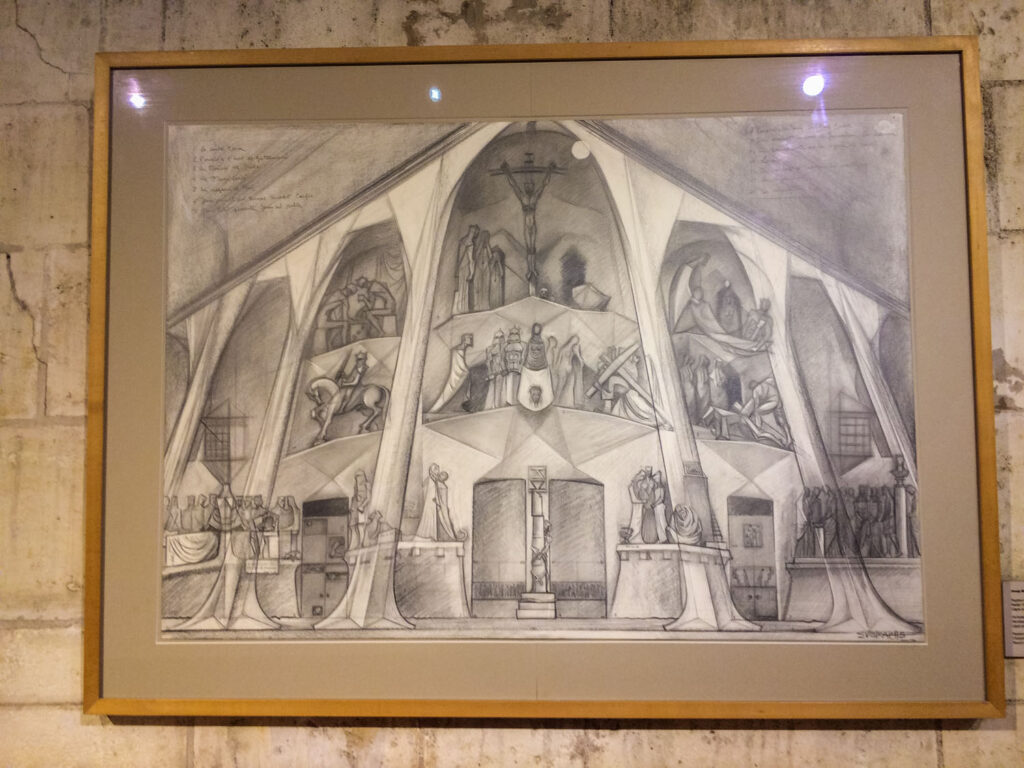
Sagrada Familia Design
The Sagrada Familia is 4,500 square meters large. It’s the size of an American football field. And when you see it in person, you can truly understand how big it is. The Basilica’s layout is that of a traditional Latin cross design. The Latin cross design features five naves, a crossing, an apse and an exterior cloister-style ambulatory. The exterior has three different facades, each a varied work of art whose imagery tells a story. Although not yet built, the tallest part of the church will be 172.5 meters tall. The highest point in the city but just shorter than Montjuic Mountain (because no man-made building should exceed what God created). The church can hold 14,000 worshippers! That’s the size of a small city. Gaudí wanted to create a place where everyone in the city could gather. Making it feel like it was always open to whoever wanted to come in. A small church just wouldn’t have had the same effect.
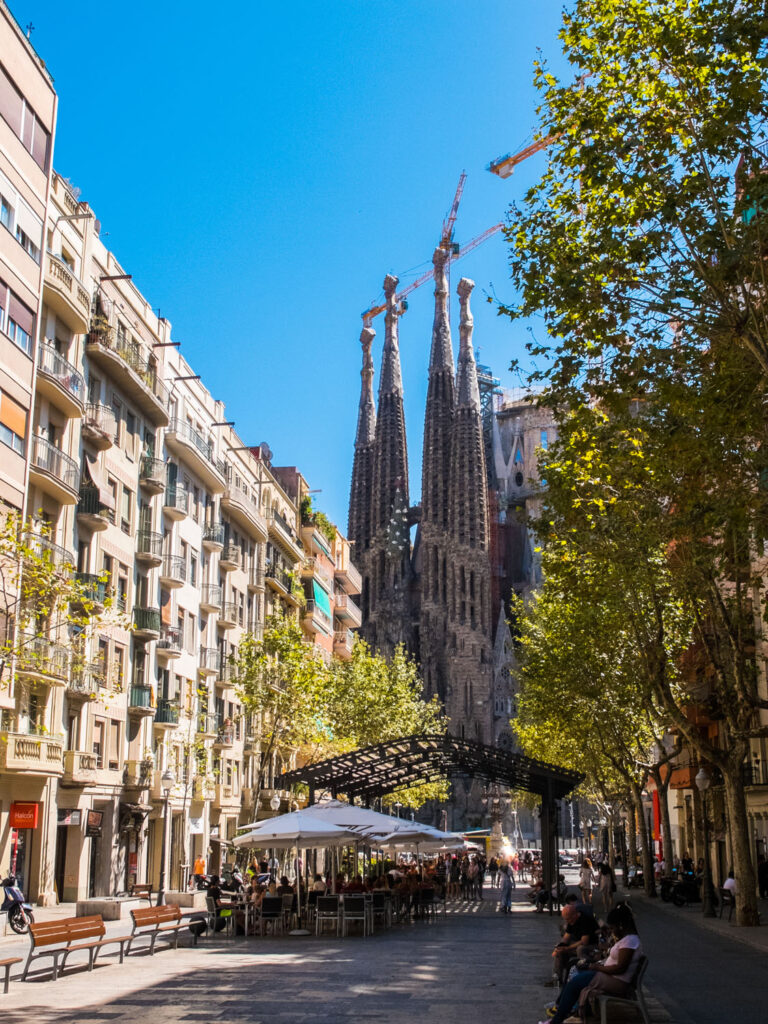
It’s important to highlight that, for our readers to understand Gaudi’s vision and references, we will be talking broadly about stories from the bible. And while not everyone who visits this church will be religious, the context will help you understand the meaning behind the construction. If you aren’t spiritual, just think of these citations as stories (or consider the real people who inspired those characters).
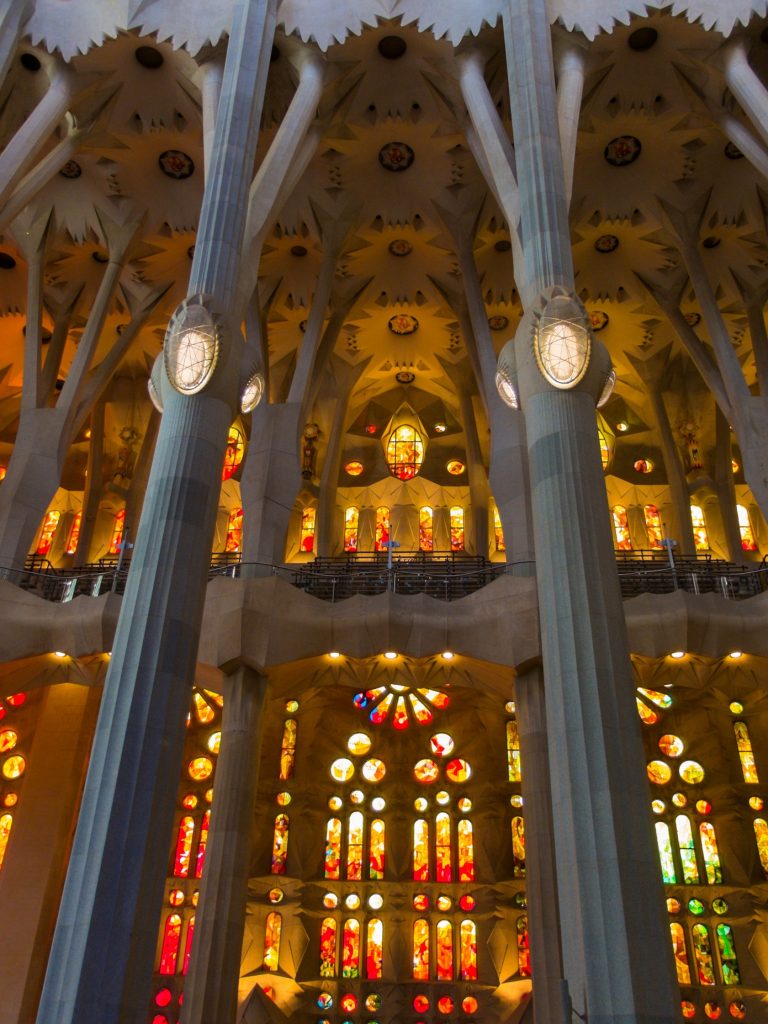
The Nativity Facade
To enter the Sagrada Familia these days, you’ll approach via the Nativity Facade. This was the only part of the church entirely designed by Gaudí. And he almost saw it finished as it was completed in 1935, just after his death. He was there almost daily overseeing the work, and it feels like the part of the church which is the most personal. The Nativity Facade has three entrances. One central and two lateral topped with four hollow bell towers, representing the four stripes of the Catalan flag. The Nativity facade faces the rising sun, as it represents the dawn of the life of Jesus Christ.
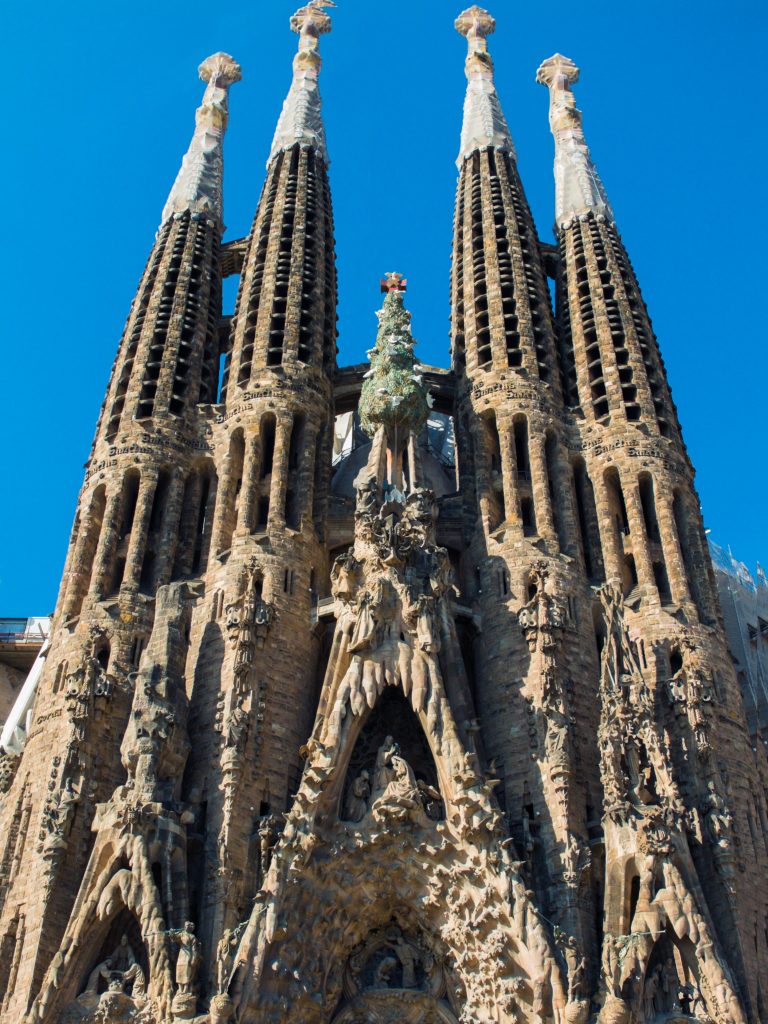
The three entrances on the Nativity facade are each dedicated to a theological virtue of the three members of the Holy Family; Hope, Charity and Faith. A portico is a triangular porch hanging over the church’s entrance. One of the most delightful little aspects of these entrances is the little details you might miss, so keep your eyes peeled.
One of these small details to notice when looking at the entire facade are the snowcaps carved into the stone. The snow is meant to look like it is melting off the tops of the hollows of the entrances. Gaudí used snow to remind the people of the festive Christmas season. So many aspects of Gaudí’s plans were drawn from historical architectural references. But others were meant to evoke a response for the common man. Something everyone can understand and evokes something within them.
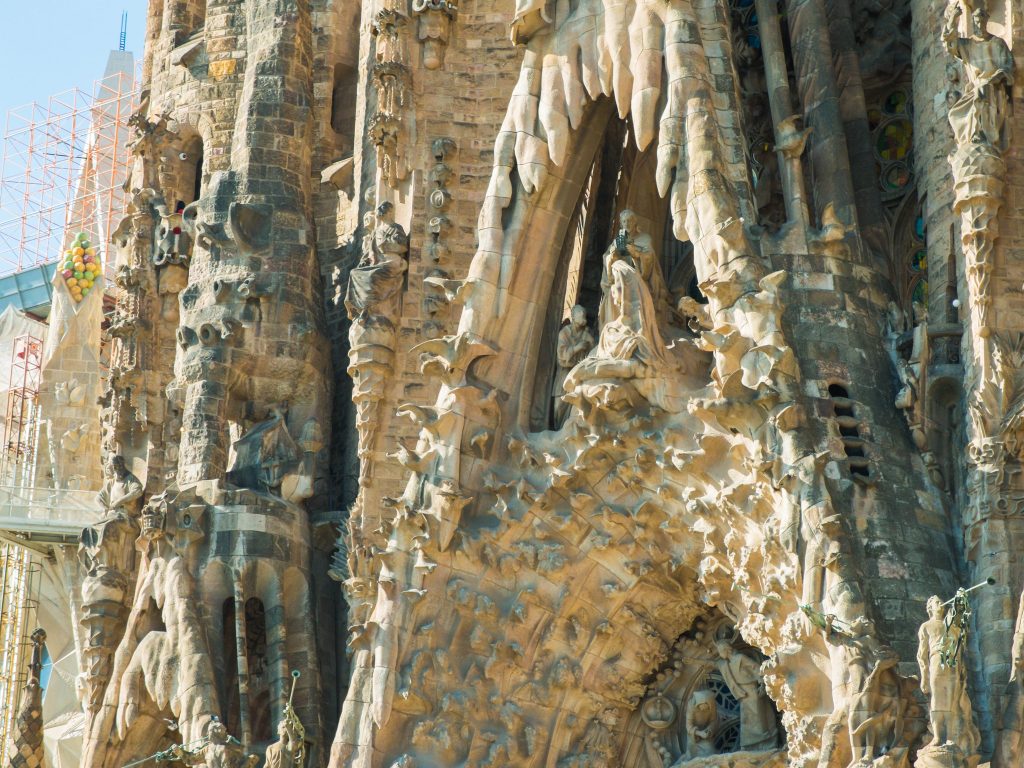
Gaudi’s Gargoyles
Instead of gargoyles, which are so prevalent in neo-gothic architecture, you’ll find a different kind of creature which caps the various edges of the roofline on the Sagrada Familia. Gaudí chose to use reptiles and amphibians (like snails, frogs, chameleons and lizards.) These creatures crawl on the edges of the building. While gargoyles are mythical creatures, Gaudí chose to pick beasts from our world who are biblically associated with the lower ranks. Gaudi believed they served the same monstrous purpose as the gargoyles in Gothic churches. They are not decorative, but their open mouths are used to drain rainwater from the temple’s roof.
The Hope Portico
The Hope Portico, dedicated to Saint Joseph, is on the far left side of the facade. This portico depicts scenes of virtue in times of adversity. We’ll study this piece from the top of the entrance, continuing downwards, beginning with St. Joseph’s Pinnacle.
St. Joseph’s Pinnacle
St. Joseph’s Pinnacle is almost hard to make out. It’s so high up, and sculptures blend in with the rest of the stonework. The textures given to the exterior are designed to reflect the crags you find on Montserrat, the sacred mountain of Catalonia. Just below the climax of the Hope Portico, you’ll see the figure of Saint Joseph sitting inside a small boat. The boat is an important symbol. Saint Joseph helped navigate the Catholic church as the patriarch of the Holy Family.
On the ship’s helm are three emblematic objects; a dove, an anchor and a lantern. The dove symbolizes the holy spirit, the anchor signifies faith’s constant grounding, and the lamp implies the light the word of Jesus Christ provided to the faithful. It’s important to note that this carving of Saint Joseph is thought to resemble Gaudí himself. The sculptors decided after his untimely death to immortalize Gaudí in the church. Gaudí himself feels like a patriarchal figure to all those architects who would follow in his footsteps.
The Holy Marriage
Below the pinnacle, in the hollow of the top arch, we find a grouping of three people. This is the scene of the marriage of Saint Joseph to the Virgin Mary carried out by a high priest who stands in the centre. They kneel over a basket of roses that symbolize God’s love at work in the world. Blossoming below this sculptural group are luscious flowers reminiscent of those growing on the Nile banks. Egypt was where the holy family experienced so much fear and terror; eventually, they had to flee the country. But they fled not without hope, which is what this entrance is dedicated to remembering. Hanging amongst the flowers are stone-carved rosary beads. 59 beads surround most of the windows on the porticos. Another way in which Gaudí combined the physical act of prayer into his church.
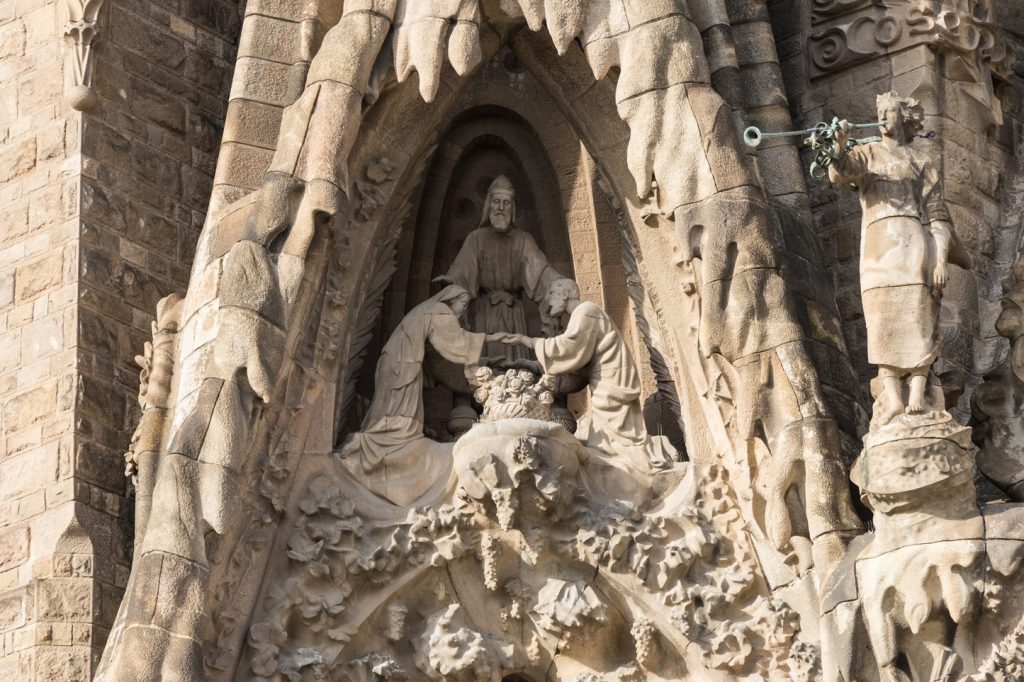
The Tympanum
Above the doorway, in the Hope Portico, we have the tympanum, which contains scenes from Jesus’ childhood. These tender moments between the young Jesus make him much more human rather than godly. On the bottom right, we see the Holy Family with Mary and Joseph and an angel guide fleeing Egypt. In the centre, we see the child Jesus in his father’s arms. A single dove flies off into the distance below them. Amidst this scene of father and son is something which you might miss. A set of carpentry tools carved in stone. Jesus’ adolescence was spent being a carpenter’s apprentice. And it was lovely to see that human side of his life immortalized in stone.
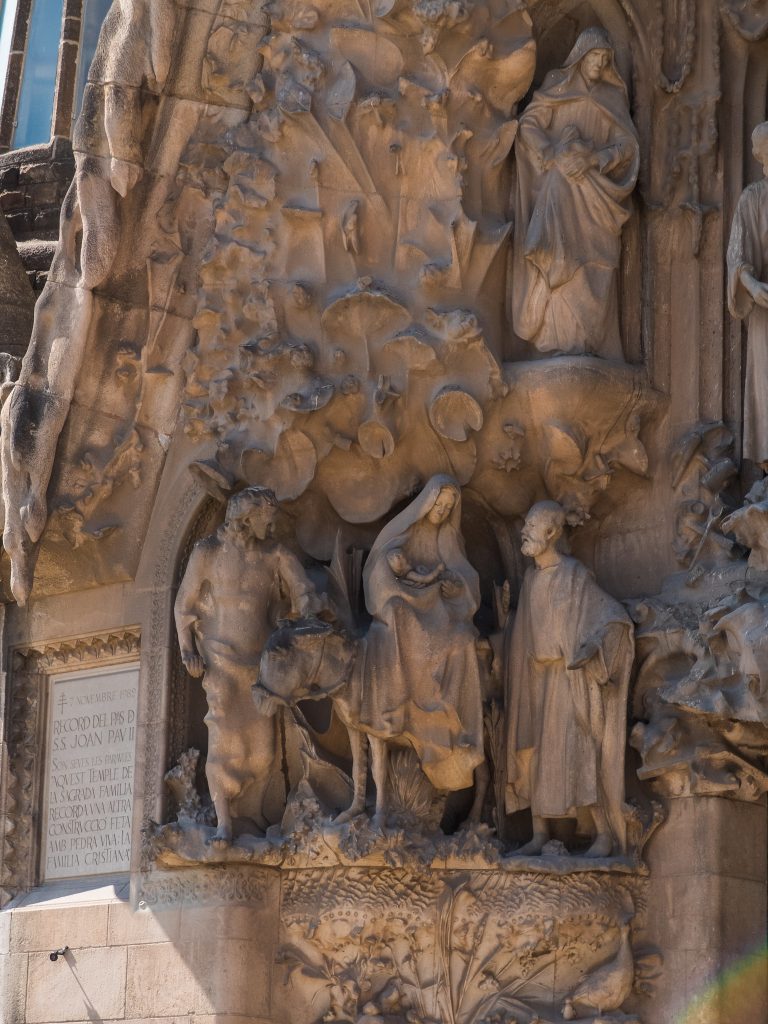
Slaughter of the Innocents
On the right, we have one of the most violent scenes from the bible: the Slaughter of the Innocents. This display shows a Roman soldier tearing a child from their mother’s arms. Under the soldier’s feet are babies’ bodies who have already fallen to the soldier’s sword. Although this is hard to see, if you manage to look closely, you can see that the Roman soldier has six toes on one foot. A small detail but one denoting his monstrosity.
Although this is a sad scene, it’s an important historical moment. When hope was all that these people had to cling to survive. On this side, the edges of the entrance are formed into the shape of a chameleon. The chameleon is an animal that represents change, and change is what hope is based upon. The fact is that even in the darkest times, there will be light. Light is representative of change, and the turning of tides gives even the most lost hope.
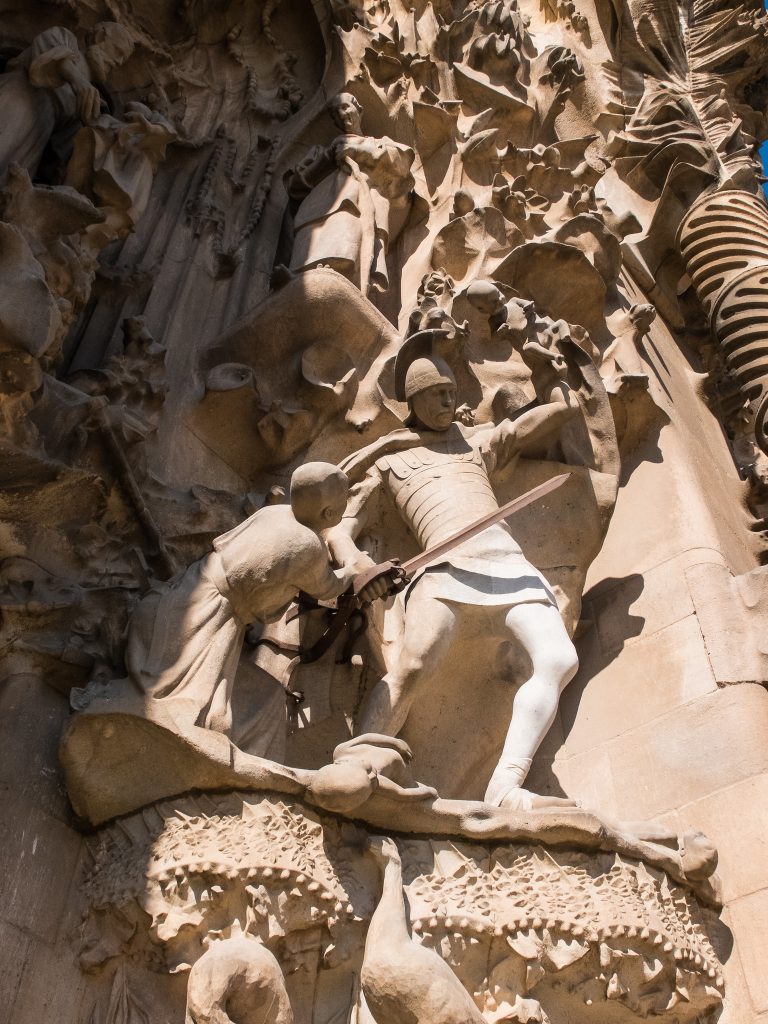
The Charity Portico
The central and most crucial portico on the Nativity Facade is the Charity Portico. Jesus’ charitable nature was one of his most notable characteristics, yet this entrance is filled with scenes of the Virgin Mary. This reflects how those who nurture us pass on their core values and attributes. The textural treatment of this portico is slightly different than the others. The exterior is covered in design elements that resemble or call back to the stable in which Jesus was born. Animals, birds and various plants are hidden throughout the mass of ornamentations that swell over the pointed portico.
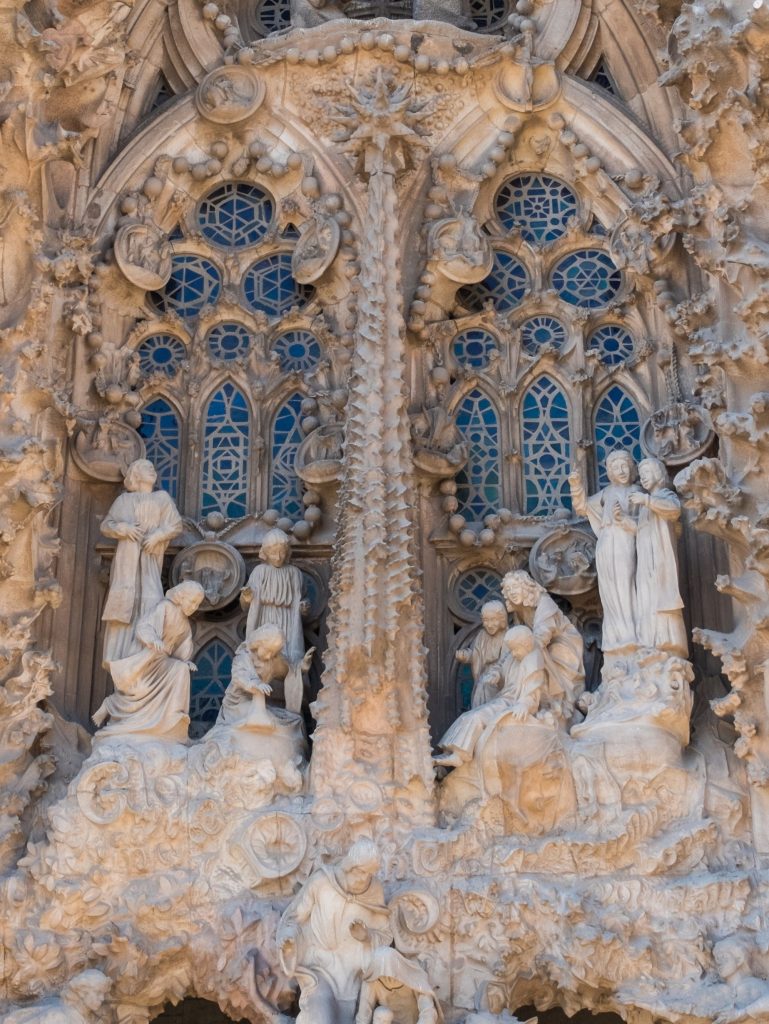
The Tree of Life
Again, starting from the top down, let’s first focus on the Tree of Life . The culminating part of this portico is capped with a polychrome-coated green cypress tree. Polychrome decorates architectural elements, like pottery or sculpture, in various colours. Gaudí originally intended for the entire Nativity facade to be polychromed. He believed that if every sculpture, face, plant and animal were painted, they would come to life in a much more realistic way. Unfortunately, the cost of this much exceeded the budget! And so, polychrome was used sparingly. But therein making where you see those colours that much more impactful.
Symbolism on the Tree
The cypress tree symbolizes eternity since it’s an evergreen plant and never loses its leaves. Covering the tree are 21 white doves that fly out of their nests and into the sky. On the top of the tree, like a Christmas Star, is the red and white symbol of the holy trinity. The Greek cross formed the base of this symbol. The Greek cross combines the letters’ alpha’ and ‘omega,’ which mean the beginning and the end. Atop the cross is the last white dove, its arms spread wide, resembling the shape of Jesus on the cross.
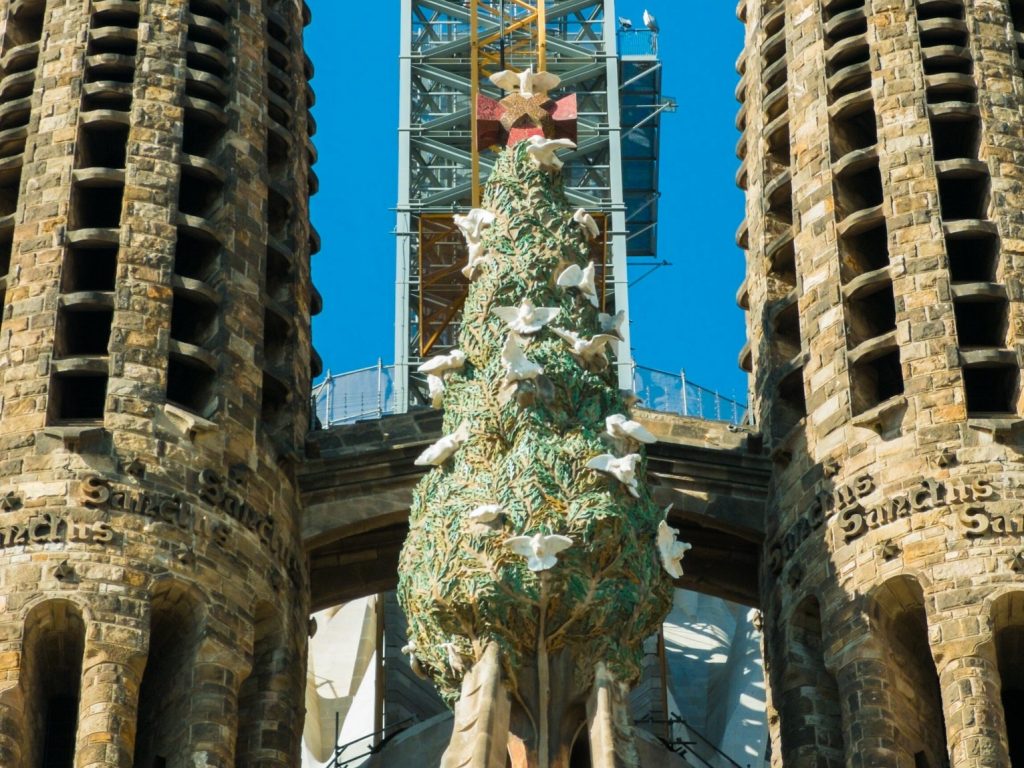
Two ladders are placed below the tree, representing our mortal desire to reach eternal life. Below the tree, you’ll see a pelican perched, her beak angeled toward two baby birds, ready to be fed. The pelican was once believed to be a symbol of the Eucharist as in ancient times, people thought the pelican opened its chest to feed its young, just like Christ offered up his own body to feed his disciples. Hidden beneath the young pelicans is a brightly coloured egg adorned with red and yellow glass. The egg is thought to represent either the birth of the universe or the symbol of Jesus’ resurrection.
Below the tree is a group of angels burning incense inside old vessels called ‘centers.’ Burning incense in the church is an ancient tradition representing the faithful’s prayers rising to heaven. The pinnacle’s stonework is covered in little bubbles, thought to represent the incense floating up toward the sky. It’s important to note that the angels here were actually sculpted by Gaudí himself.
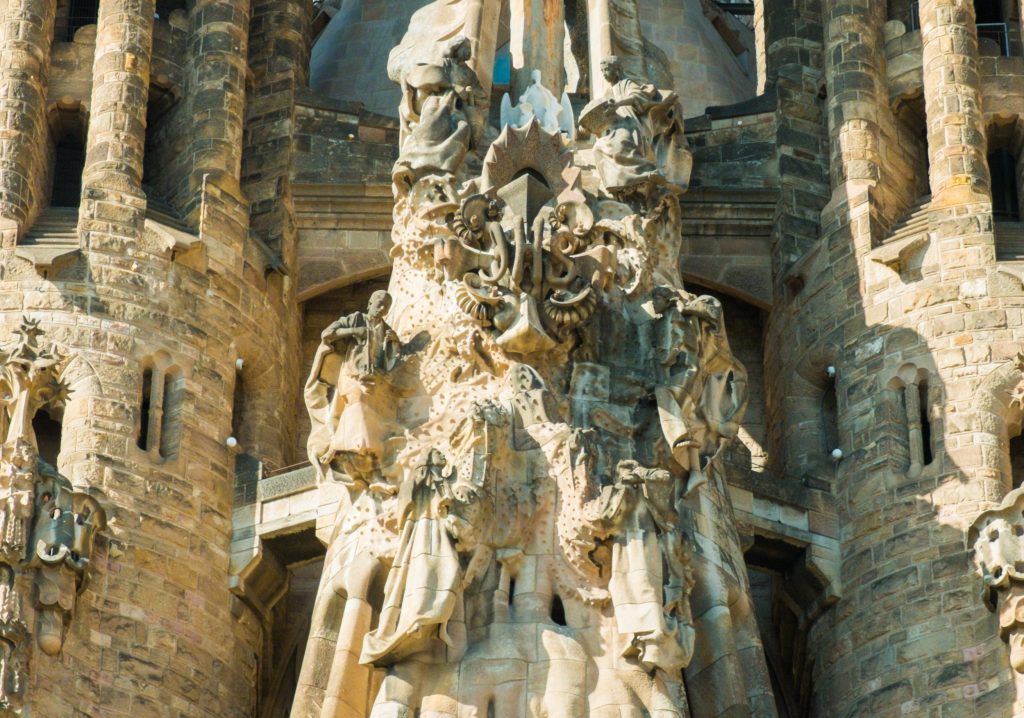
The Crowning of Mary
Below the tree of life, we come to a small cave. Here we can see a little intimate scene of Jesus placing a copper crown atop the Virgin Mary’s head. Crowning her the Queen of Heaven on Earth. This was her reward for her ceaseless love for God and humanity. Despite what they had done to her beloved son. On the left, we see Saint Joseph there to witness the event. And on the right, we see the Holy Spirit represented as a man. The entire scene is set in front of one of the incredibly colourful stained glass rose windows. At certain times of the day, the glass seems to set the entire scene aglow with mystical light.
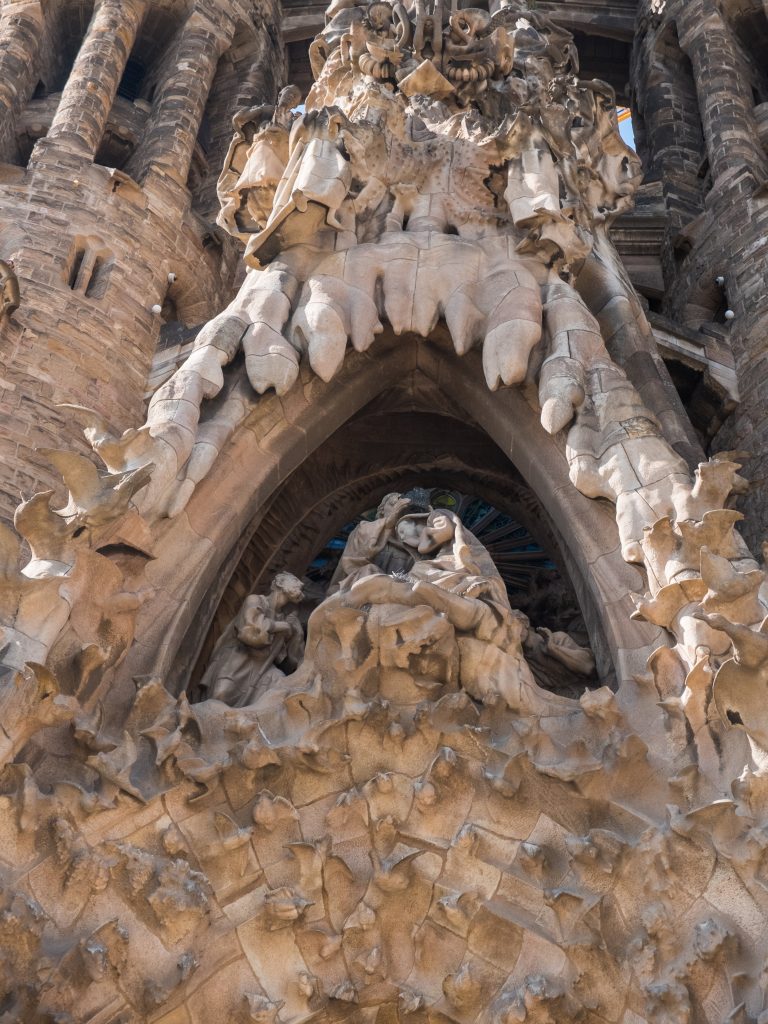
The Charity Vault
The vault in the Charity portico contains the scene of the Annunciation. We find the archangel Gabriel told Mary that she is the chosen one. Who will bring the son of God into this world? Surrounding this petite scene are the signs of the zodiac. And depictions of constellations across the sky. Just as they would have been on the night Jesus was born. Bands of rosary beads surround the scene. Hanging around the rosary are medallions carved in stone representing the ‘Miraculous Medals,’ which you find around rosary bracelets.
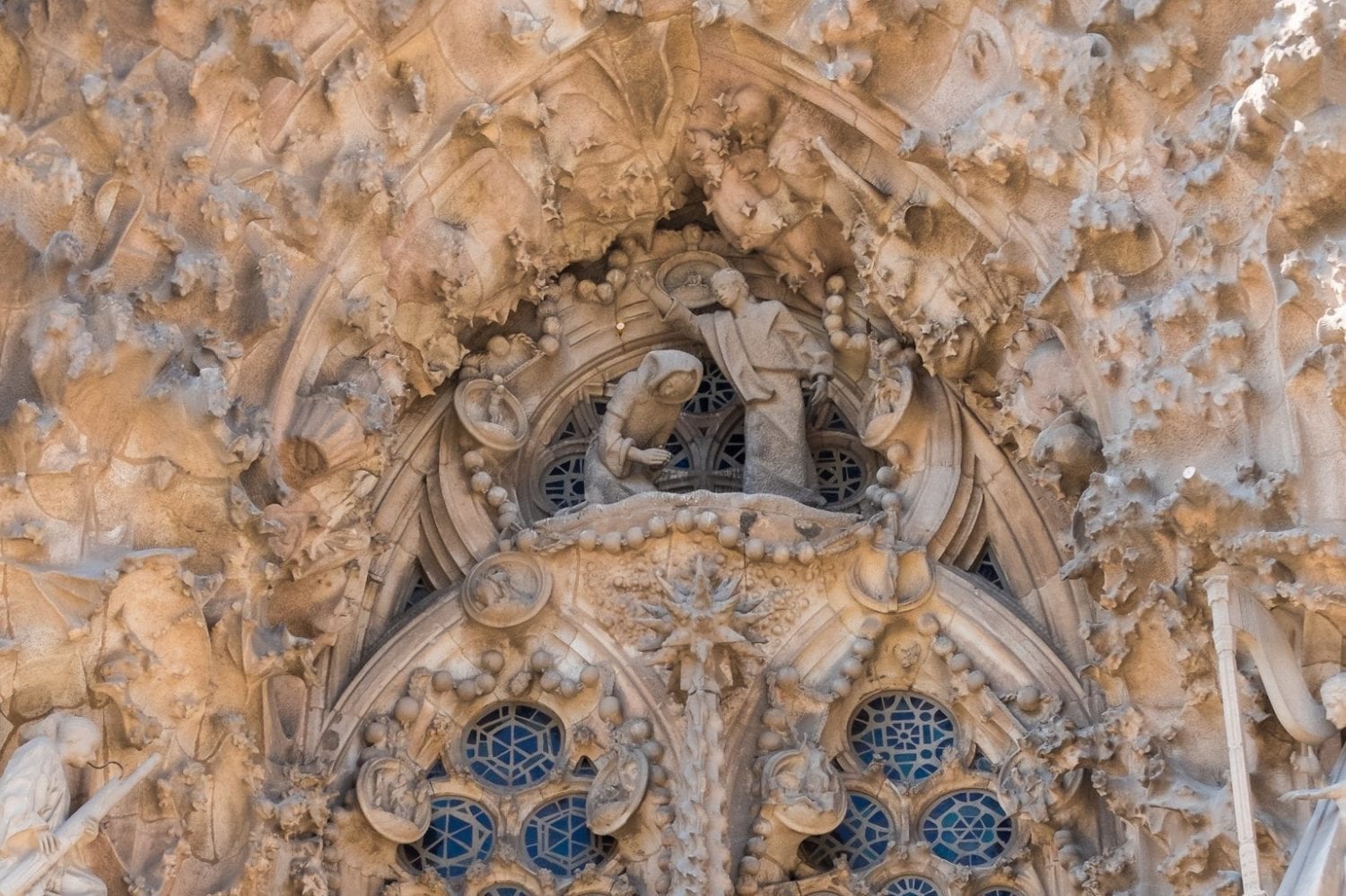
The Chorus of Angels
Above the Charity doorways, here is a chorus of angels. Each angel is a musician, playing popular instruments in religious settings. Instruments like the lute, the violin and the harp, the more common guitar, the bagpipes and the tambourine can all be found here. Once more, this was a way of the common fold being able to see themselves in the divine. Running up between the two sets of stained glass windows behind the angels is the multi-pointed star of Bethlehem. This was the star that shone in the sky to announce the birth of Jesus.
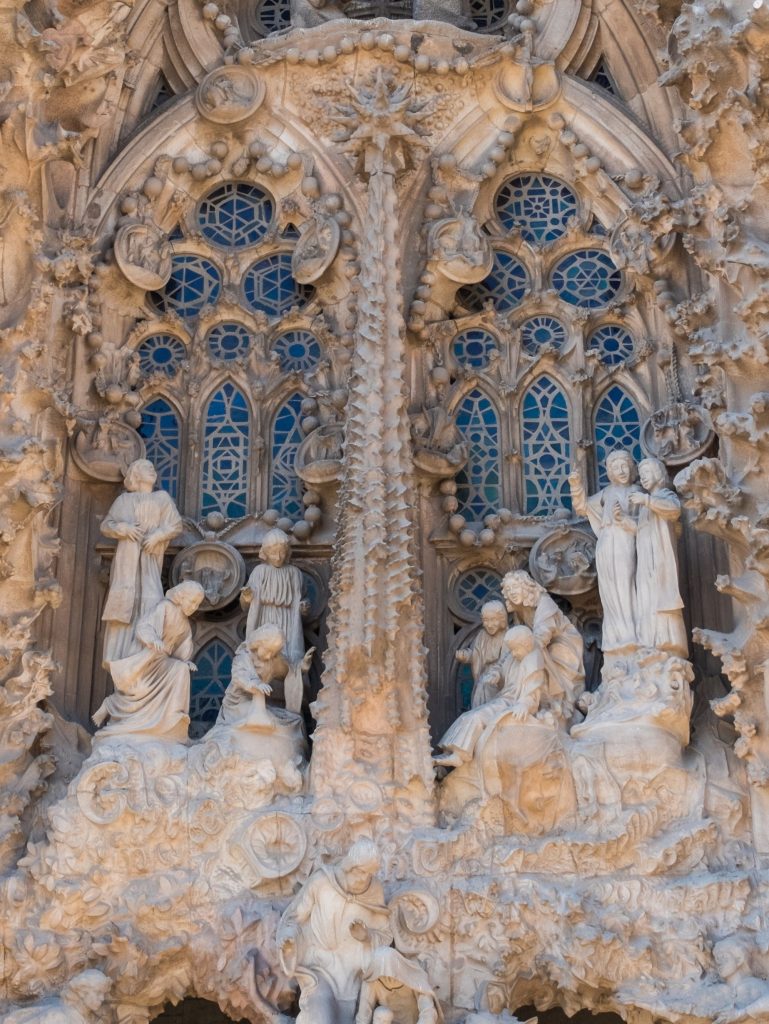
The Adorations
To the left of the double doorway, we can see sculptures of the Adoration of the Magi. And on the right, we have the Adorations of the Shepherds. Some scenes from the Nativity represent how Jesus’ arrival brought people from such disparate groups together. For me, this scene is especially poignant since I feel Gaudí achieved a similar reaction in the construction of this church. No matter if you are religious, spiritual or neither, this building still draws people from far and wide into its arms. And once they behold it for themselves, there is never a question of its outstanding cultural value.
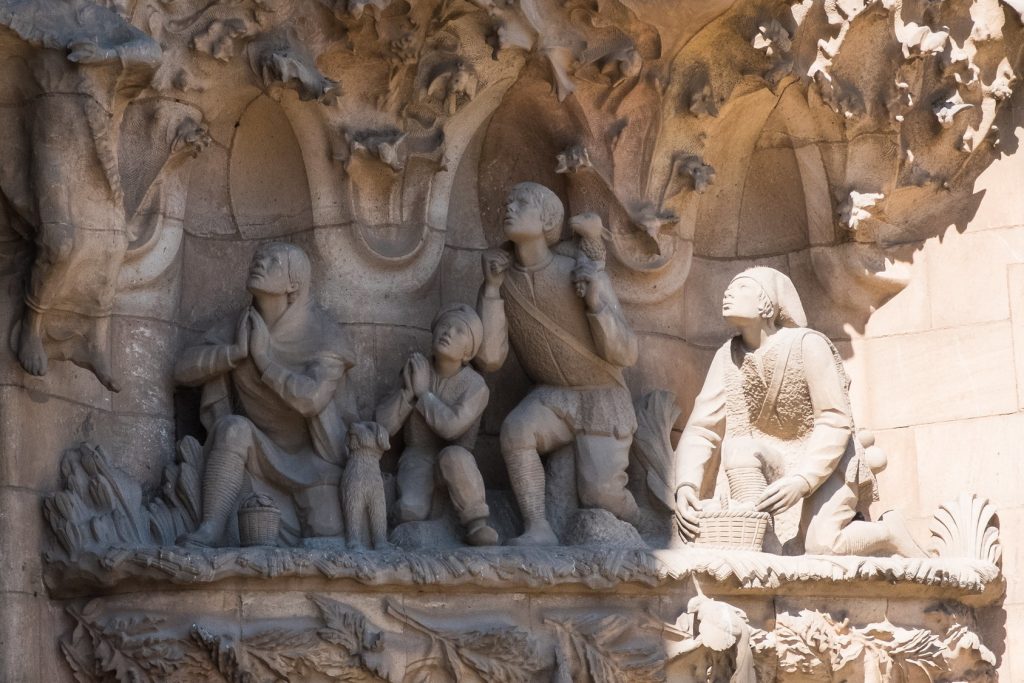
The Monumental Columns
Three primary columns are located at the base of the church, each representing a member of the holy family. The one in the centre of the two charity doors is the Jesus’ Column, and the other two flanking the charity portico are dedicated to the Virgin Mary and Saint Joseph. On the very top of the central column is baby Jesus, being placed into a bassinet by his mother. His father looks on, as do an ox and mule, just like the Christmas carol. To the left of this scene is a small text inscription expressing “Gloria in Excelsis Deo,” a phrase spoken by the angels on the night Jesus was born.
Large palm leaves look like they’re supporting the group atop the column. Palm leaves are a symbol of victory in Roman culture, and the date fruits hanging from the leaves symbolize faith. Surrounding the column is a thick ribbon with inscriptions inlaid upon it. The form of ribbon almost looks like one side of a DNA strand. Fittingly, it is thought that the inscriptions on the fabric are Jesus’ genealogy dating back to Abraham. Halfway down the column, the stone is surrounded by dense iron mesh. If you peek through the mesh, you can make out the shape of the snake biting an apple, the symbol of original sin. The iron mesh traps the reptile from fleeing the garden and invading the pious world.
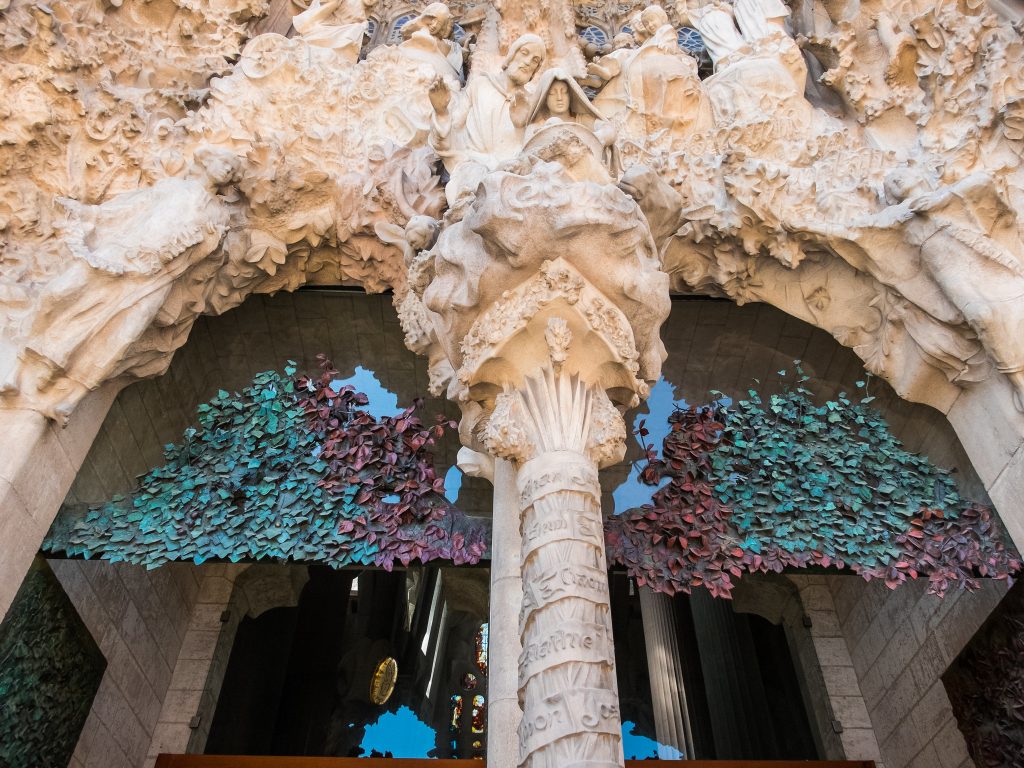
Carvings on the Column
Atop the two remaining columns flanking the sides of the Charity portico are a pair of angels playing long bronze trumpets announcing the birth of Jesus. The models for these sculptures were a group of military musicians who were good friends with Gaudi. The angels stand atop more palm leaves, covered in snow and dates. The centre of the columns is marked with an inscription, each inscribed with the names of those to whom they are dedicated to. At the bottom of the columns are carvings of a tortoise and a turtle, holding the entire weight of the column up. The turtle represents the land, and the tortoise the sea. Both of these animals are unchanging and, as such, are capable of being the foundation upon which this church is built.
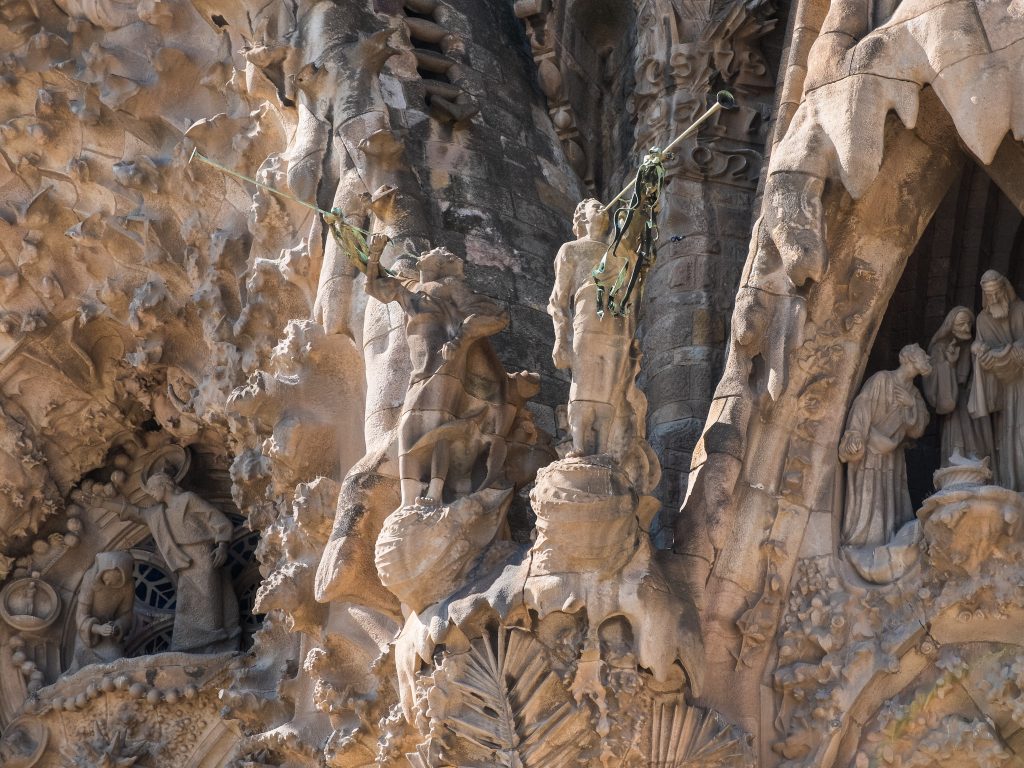
At the bottom of the columns is the carving of a tortoise and, on the other, a turtle, holding the entire weight of the column up. The turtle represents the land, and the tortoise the sea. Both of these animals are unchanging and, as such, are capable of being the foundation upon which this church is built.
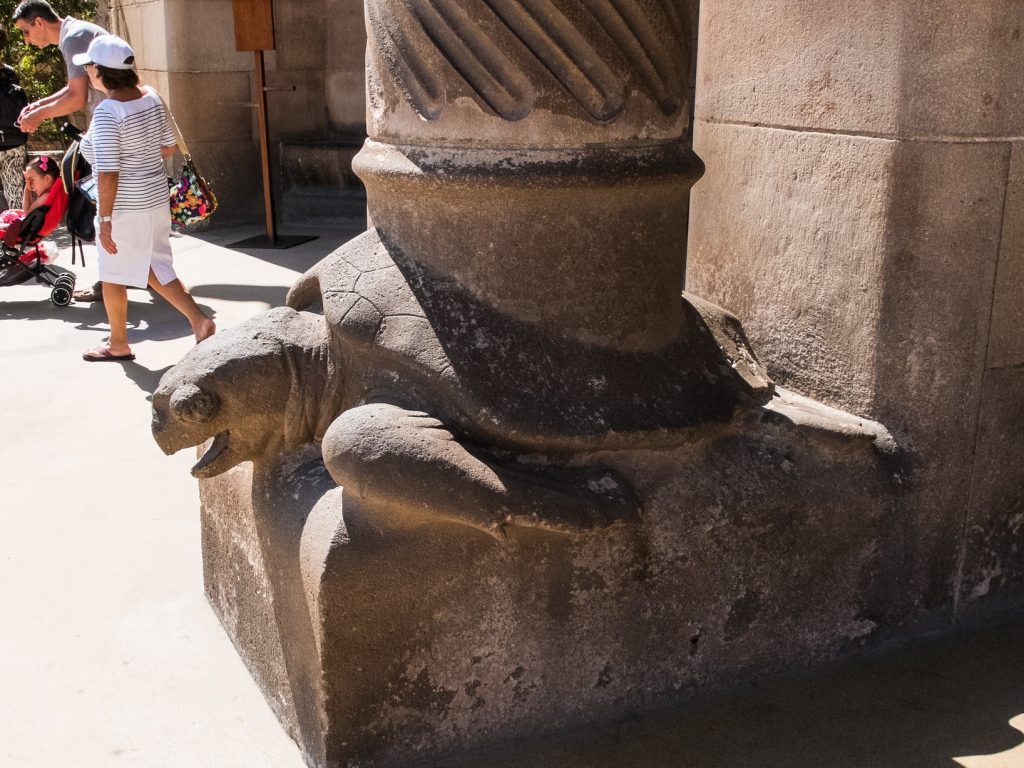
Faith Portico
The last of the tree porticos is on the far right-hand side, called the Faith Portico. This portico is dedicated to the Virgin Mary, yet most of the scenes here actually feature her son when he was a young boy and his life during adolescence.
While centred around Jesus, these scenes show Mary’s faith in God. Imagine being a mother and seeing your son grow up so innocent and kind, all the while knowing he will die for the sins of humanity, and you’ll be the one to bury him. It takes a strong woman to keep faith in this knowledge, and yet she persevered and, not only that, made sure to be the best mother she could be against all the odds. I think everyone can take something from this story into their own lives at times when they feel they perhaps have lost faith in themselves or the direction their lives are going.
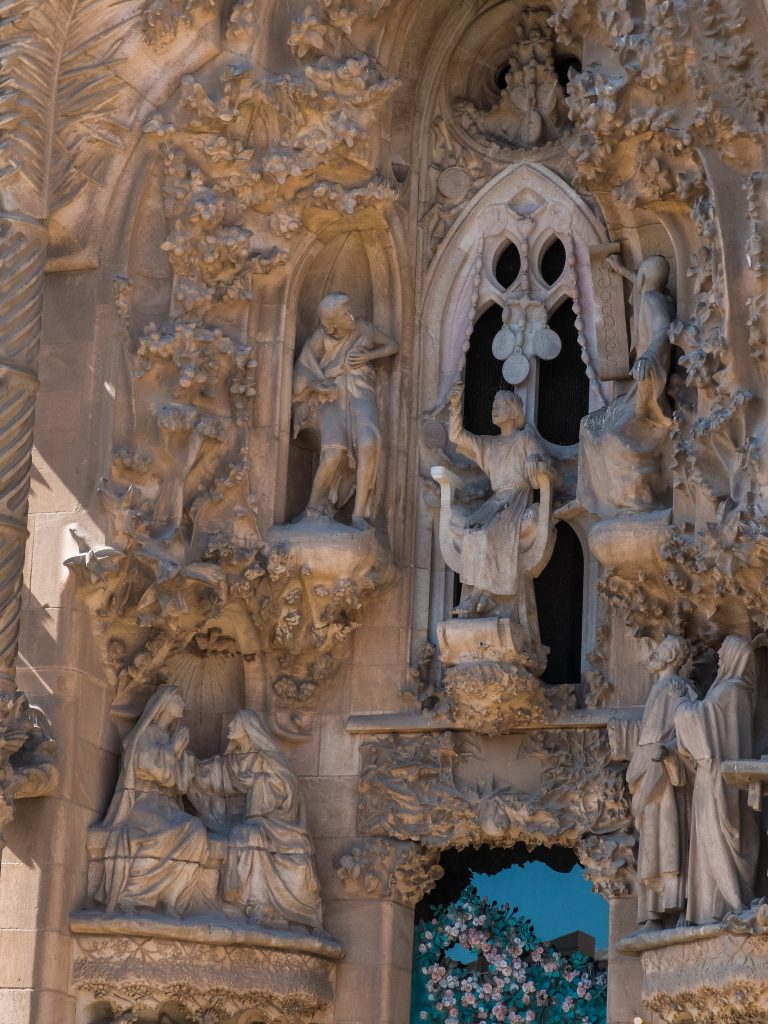
Blessed Virgin’s Pinnacle
At the very top of the portico is the Blessed Virgin’s Pinnacle. The head of the pinnacle is capped with ears of wheat springing forth. These symbolize the bread Jesus shares with his disciples in the Last Supper. Below, in a small hollow cave, is a carving of a hand with an open eye in the centre. This is the symbol of divine providence, which represents God, who can see all and even perhaps influence the destiny of humankind. Vines and grapes intertwine all over this pinnacle, another symbolic element of the Last Supper.
In the centre of these vines is the figure of the Virgin Mary, her hands crossed over her chest and head leaning back, utter vulnerability and trust emitting through her language. Mary stands upon a three-pointed lamp, representing the light of the holy trinity. Below her figure, we can see Saint Joseph’s anagram, another little detail tieing these two people together consistently through the design, even when they are not physically together.
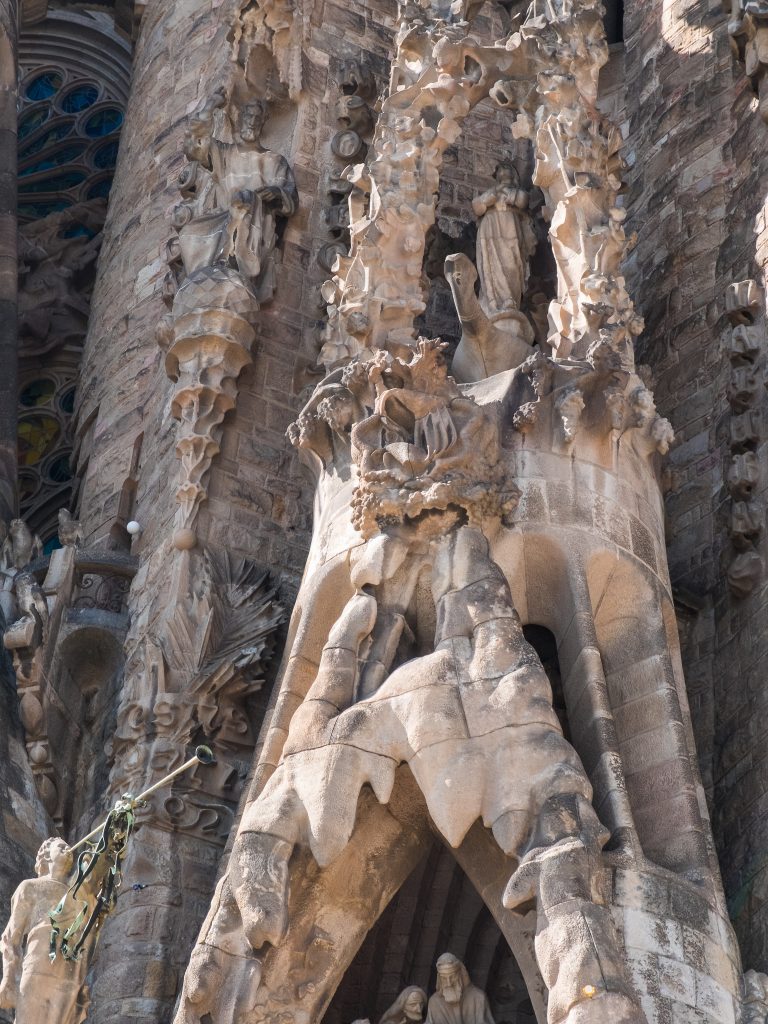
Jesus in Simon’s Arms
In the hollow at the top of the portico is Jesus in Simon’s arms in the temple of Jerusalem. Many parents would bring their children to the temple to be blessed. A bowl is at the bottom of the scene, and within it are two birds. But these are not doves as we’ve seen before, but are pigeons. Every parent needed to bring a sacrifice to the temple for their child to be blessed. Most people would bring a lamb to display wealth, but as Mary and Joseph were poor, they could only afford to bring two meagre pigeons.
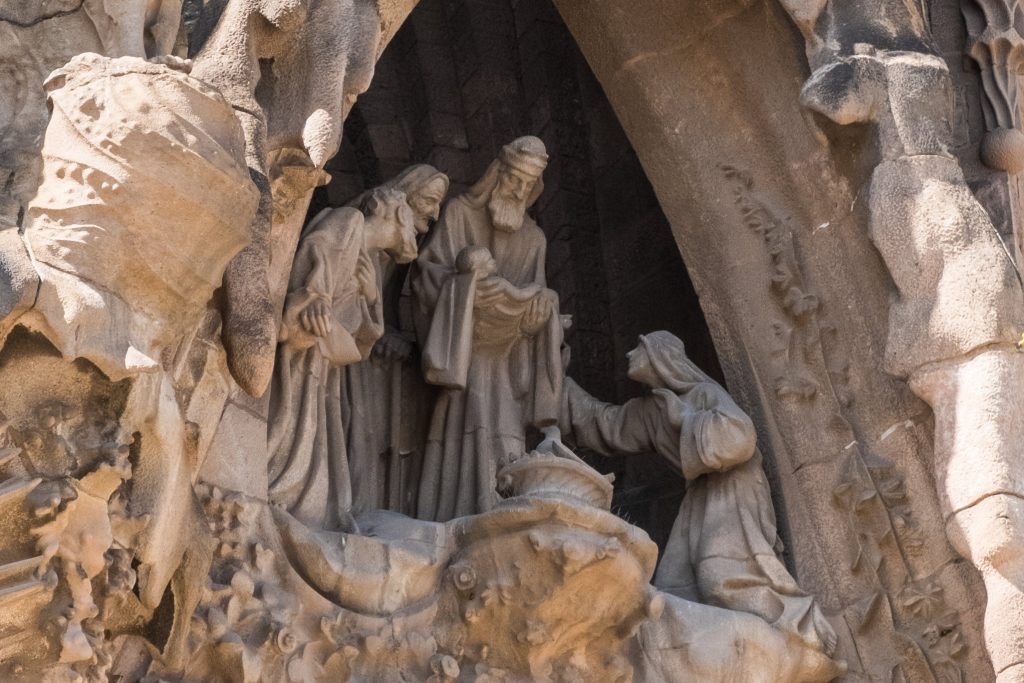
Central Scene on the Faith Portico
Under the vault on the Faith portico is a beautiful rose window made up of multicoloured glass. Looking up from underneath the vault is the figure of Jesus seated in a chair, his hands raised towards the sky. On his left side is Saint John the Baptist. On the right is Saint Zachariah. These two scholars were some of Jesus’ best teachers and would shape how he would preach. Despite being his elders, they are seen here looking at Jesus with admiration and wonder. Below the scholars, right above the doorway, is the symbol of the heart of Jesus, surrounded by thorns and covered in bees who feast on the blood. A morbid foreshadowing of things to come.
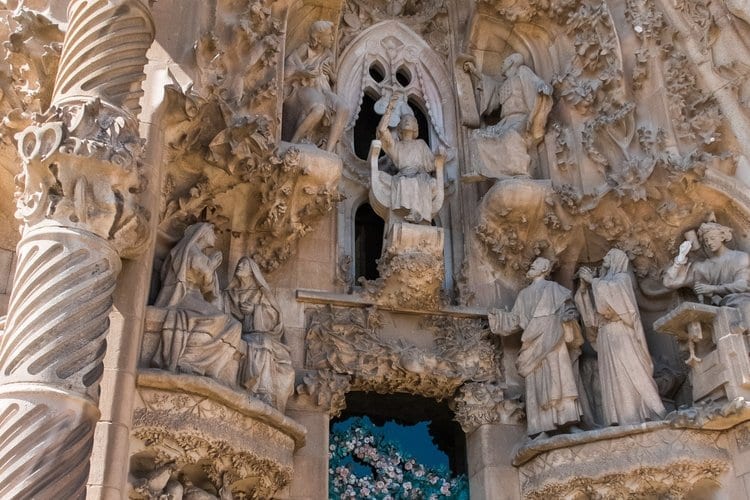
On the left-hand side of the doorway, we can see the scene of the visitation of the Virgin Mary. Here we have Mary, pregnant with baby Jesus, visiting her cousin who at the same time was pregnant with the would-be Saint John the Baptist. In the scene on the right, we find Jesus as a young carpenter at his work table. In front of him are the figures of Mary and Joseph. Their faces are that of surprise, anguish and denial as they learn of their son’s fate for the first time. But Jesus remains unphased, working quietly on his carpentry, his posture slightly slumped, mirroring a more human figure who knows not yet of his divine destiny.
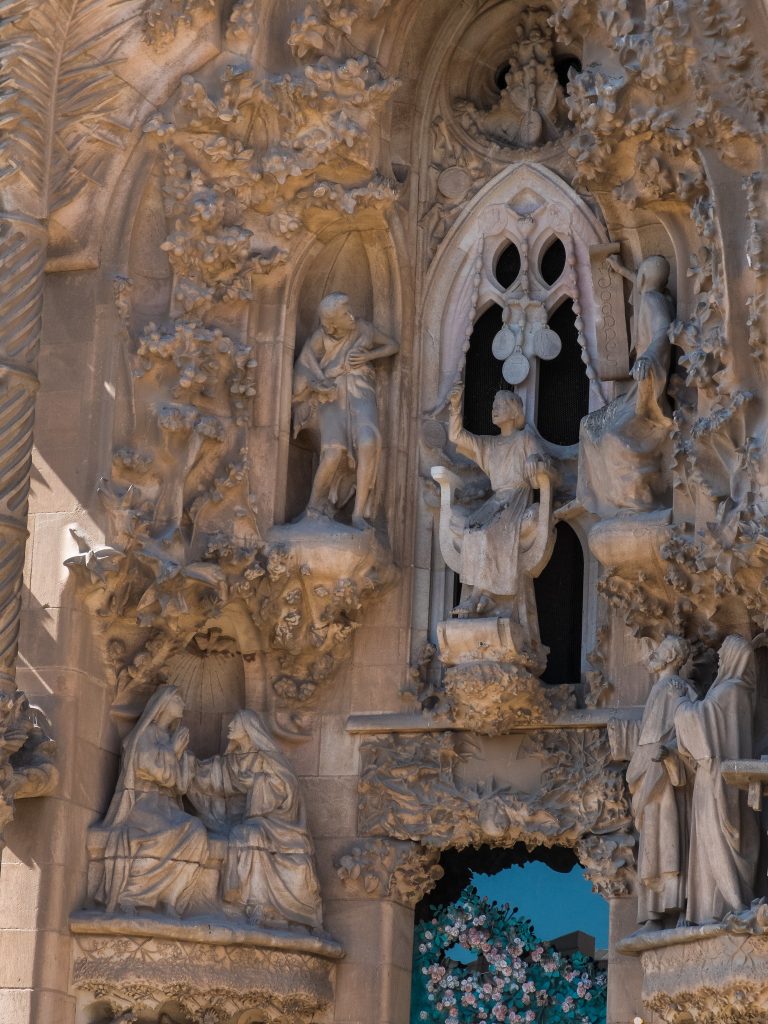
The Spires and Towers
Gaudi desired to make the Sagrada Familiar as the tallest building in Barcelona. He was inspired by stories of architects in medieval times who built their churches as the central figure in the city. These churches needed to be tall as they were often used as meeting points, a guiding light to those travelling into town. Their bell towers signal the beginning of the workday or even warn people of fires, earthquakes or other devastating events. Gaudi wanted to implement this same idea, but just one tower wouldn’t suffice. He decided to far and away exceed anything created for basilicas before.
Gaudi’s design called for eighteen spires, reaching up toward the heavens. The hollow and hole-filled design of the spires makes them look like a sort of beehive or anthill, as the stone’s colour so closely resembles the earth. But the hollow design was actually a form of lanterning, an architectural element that illuminates the church while also giving it enormous height and grandeur.
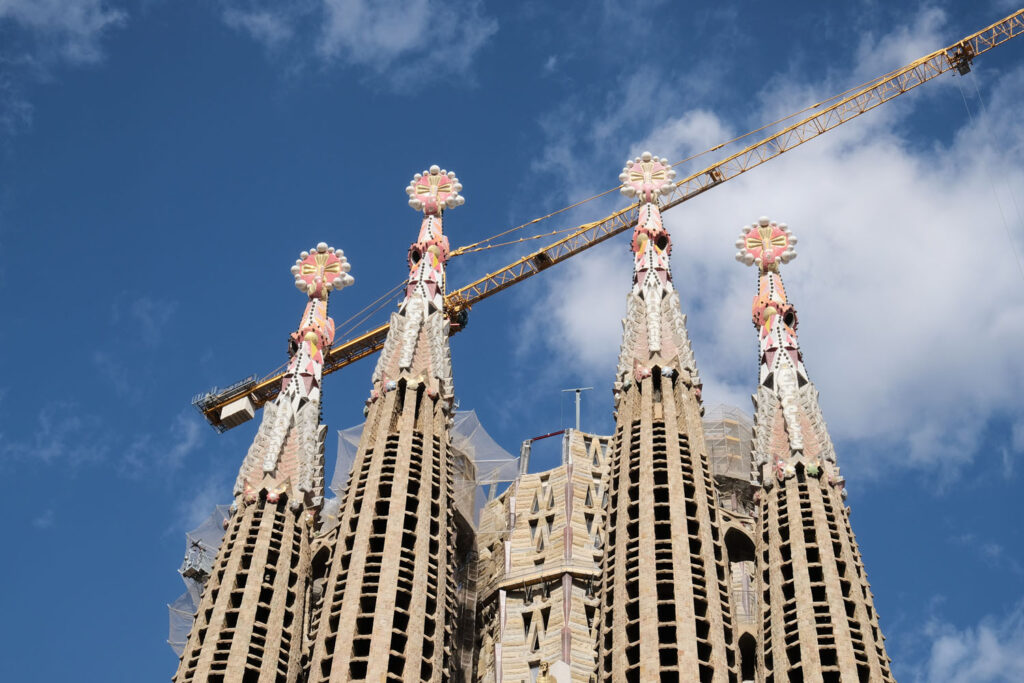
The spires are representative, in ascending order of elevation, of the Twelve Apostles, the Virgin Mary, the four Evangelists and, tallest of all, Jesus Christ. The Evangelists’ spires were designed to be topped by sculptures of their corresponding symbols. A bull for Saint Luke, symbolizing sacrifice, service and strength. An angel stands for Saint Matthew, who represents Jesus’ human Incarnation, who, upon his death, became divine. An eagle sets off to soar in the representation of Saint John, as the eagle symbolizes a figure of the sky and the fact that Christians should look to their eternal fate instead of their mortal one. And finally, we have Saint Mark represented by a lion. Saint Mark’s beautiful gospels were thought to be the “voice of the one who cries in the wilderness,” like the roar of a lion.
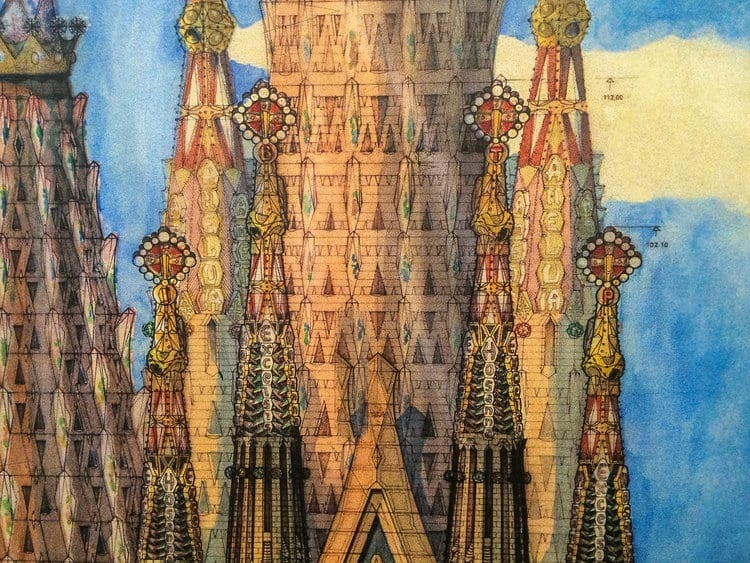
Atop each of the spires along the perimeter of the church, over top of the cloisters, are a set of pinnacles. These are in various shapes, abstractions of elements of the bishop’s attire, such as the mitre, the ring, the cross and the staff. They are all decorated in rich tones of Murano glass which is much stronger than ceramics, so they can withstand the elements up high.
Jesus and Mary Towers
The Virgin Mary tower will be the widest right over the high altar. Her tower is currently finished, but its shape has already been a form of a cathedral. Her tower, once completed, will be crowned by the ‘morning star.’ This star is the guiding light that travellers use to find their way even in darkness, and the star is still visible even when the sun has risen at dawn.
The interior of her tower is made up of a large hyperboloid skylight which brings natural light into the presbytery. The hyperboloid will be covered in white tiles, the colour of purity, looking like a divine cyclone sucking in the light from above. The largest and tallest of the towers, the Jesus Christ Tower, has yet to be built, but once completed will be the most impressive of them all, reaching a height of 172.5 meters, capped with a Gaudí-style four-armed cross. The tower’s interior will act as a giant lantern since Gaudi wanted this part of the church to reflect the phrase Jesus spoke, “I am the light of the world.”
The Cimborio
At the top of the spires, you’ll find elaborately coloured and designed cimborio. A cimborio is a dome or a cupola from traditional Spanish architecture. Gaudi’s cimborio is more sculptural, with images of plants decorating the surface, specifically those plants connected to the Christian faith. We see ears of corn, wheat, cedar and lavender all swirling around. Gaudi also chose plants native to the Mediterranean or that once grew on the site where the church was built. Gaudi used his technique of trencadis cladding to ensure the tops were as colourful as possible so you could see them across the sky from all over town.
The Cloisters
As you enter the Nativity facade, you pass through those large doors and enter the cloisters surrounding the entire church. A traditional cloister was first used in monasteries and was meant “enclosure.” It was a covered walkway for the monks to use as a space of private contemplation. When cloisters were incorporated into cathedrals, they would run along one side of the church.
Gaudi used his cloisters in a revolutionary way; instead of just placing them on one side of the church, he wrapped them around the entirety of the Basilica. This was his solution to create separation or barrier between the church’s interior and the loud and obnoxious outside world. This resulted in a quieter interior and an almost zen-like atmosphere. A conventional monastery cloister would surround a garden. Because the interior here would be the church’s apse, Gaudi made sure that his interior still felt like a garden, like the of Eden. A mythical forest in the centre of town.
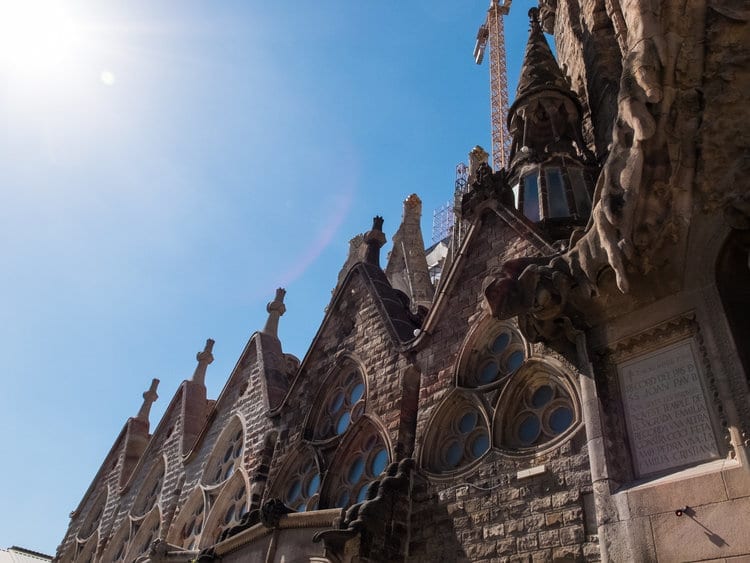
Cloisters and Light
Gaudi wanted to find a way to bring natural light into the interior of the church even though there were no windows that faced directly outside the apse. He did this through his ingenious redesign of the cloister windows. Gaudi went through two different variations in his light experiments. Both of which are still present to this day. The first was designed in 1890 and was based on the three ogival modules inspired by traditional Gothic architecture.
The secondary design done in 1919 was a more modern interpretation of Gaudi’s which looked less like Gothic art and was more inspired by nature. These circular windows, stacked in a triangular pyramid, looked like a honeycomb and fit better with the rest of the naturalist design across the temple. The cloisters also served another purpose. By having this area around the entirety of the church, Gaudi made it so that these galleries could be an area where people could move throughout the church quickly without interrupting the worship that was taking place inside.
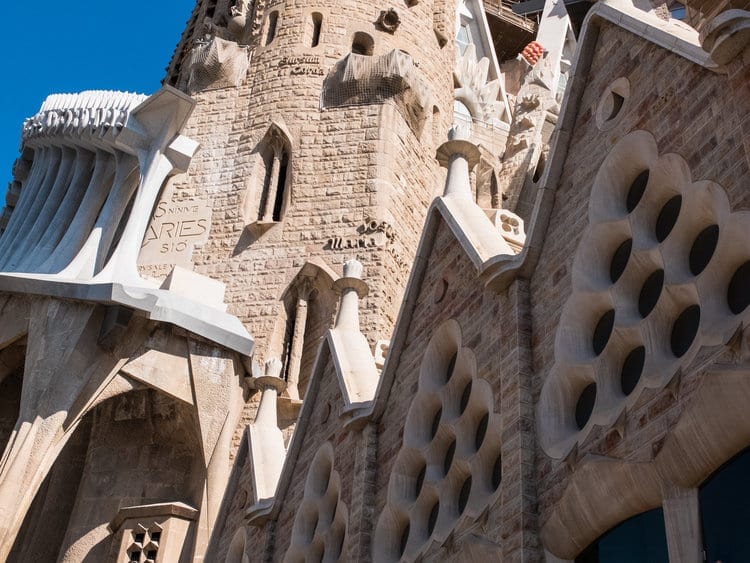
The Bronze floral Doors
To enter the church, we must head back to the Charity portico and walk through the archway. The doors you pass on your way are made from polychrome bronze and designed by various plant species and covers and are ed in highly realistic insects. The paintwork on these doors is breathtaking and an introduction to the colours you’ll be wowed with inside.
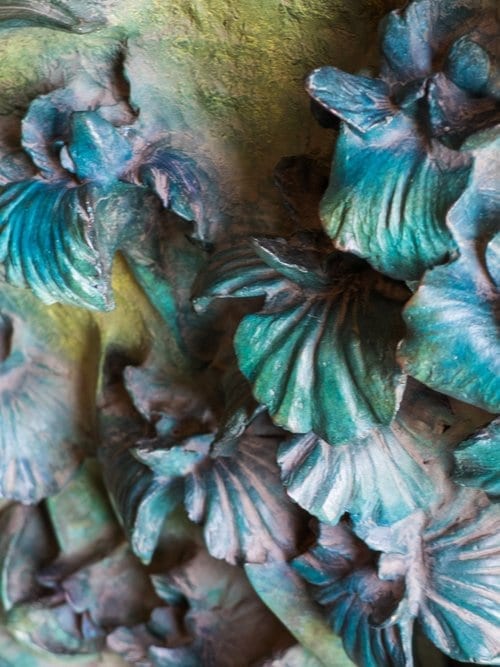
The Rosary Portal
You’ll first pass through the Rosary Portal to enter the church’s interior. This incredible doorway is called the door of Our Lady of the Rosary . In the tympanum above the doorway is the sculpture of the Virgin Mary holding a crowed baby Jesus. Mary also wears a crown, as she is the Queen of Heaven on Earth, but she is also symbolically crowned with an archway of roses on the portal above her. Since the rose is the symbol of purity is almost always hidden somewhere in depictions of the Virgin Mary.
Above this doorway is a cupola lantern which perfectly lets in a ray of light that highlights Mary’s face. This effect is almost too beautiful, and if you didn’t know the cupola was there, it takes on looks heavenly side of the doorways are various sculptures of characters from the old testament.
On the bottom of the arches around the door are scenes dedicated to the theme of temptation. We see the temptation of woman, the death of Judas and the temptation of man. The temptation of man is the most surprising as it is symbolized by a fish-like devil offering a bomb to man. While you might not always associate the devil with bombs, this scene was of particular significance to the people of Barcelona. Bombs were heavily used during the Spanish civil war, and this particular artist was inspired to make this alteration after the bombing of Barcelona’s Liceo Theatre in 1893.
The Interior Apse
The floorplan of the Sagrada Familia is designed to replicate the traditional Latin cross, but Gaudi’s floorplan featured five naves, a large central one and four lateral naves. He also took it upon himself to widen the naves, therein creating an unparalleled vastness of space, which feels impossible to have in such a lavish interior. But with all this space, there had to be structure. Some way to keep the building from falling down without sacrificing that ethereal atmosphere.
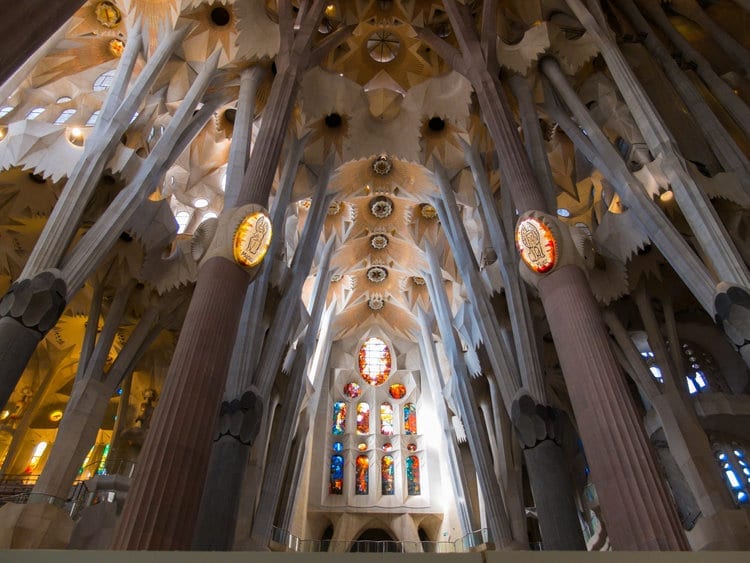
The Arborescent Columns
The interior of the church was meant to resemble a spiritual forest. Gaudi wanted it to feel like a retreat into nature. Gothic churches were revolutionary in creating openness and space; they wanted the interior to feel light and the high ceilings as if they were reaching up toward the heavens. Gaudi once more wanted to take this to the next level. He wanted to incorporate huge stained glass windows on either side, which meant they could not be load-bearing, so that load had to be carried elsewhere.
Gaudi researched for years to develop this new concept he called the ‘Arborescent Columns.’ Inspired by the strength and beauty of large trees, the columns tilt slightly about their height so they can withstand the roof load. They also split off in two directions, like the branches of a tree and also like a flying buttress to better support the vaults. At any time, you expect to see birds flying from branch to branch, making a nest for themselves. And what better place to do it?!
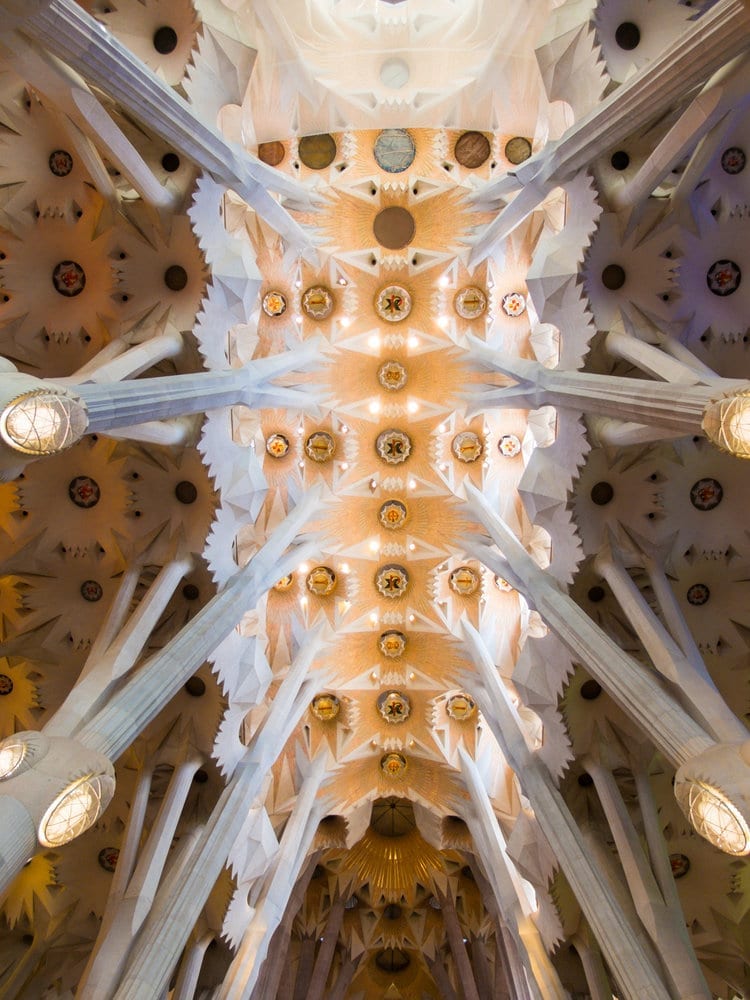
36 Tree Columns
There are 36 columns in total with different heights and widths. The variation of these sizes makes them seem more unique and less man-made. Four materials were used to create the columns; porphyry, basalt, granite and Montjuic stone. The Porphyry columns support the vaults over the crossing and are the widest in diameter. They are the red-coloured columns which contain the Evangelists’ lights. The basalt columns have ten sides and are one of the most durable materials. The granite columns are blueish-grey in colour and are only eight-sided. The final columns are made from Montjuic stone and are the thinnest.
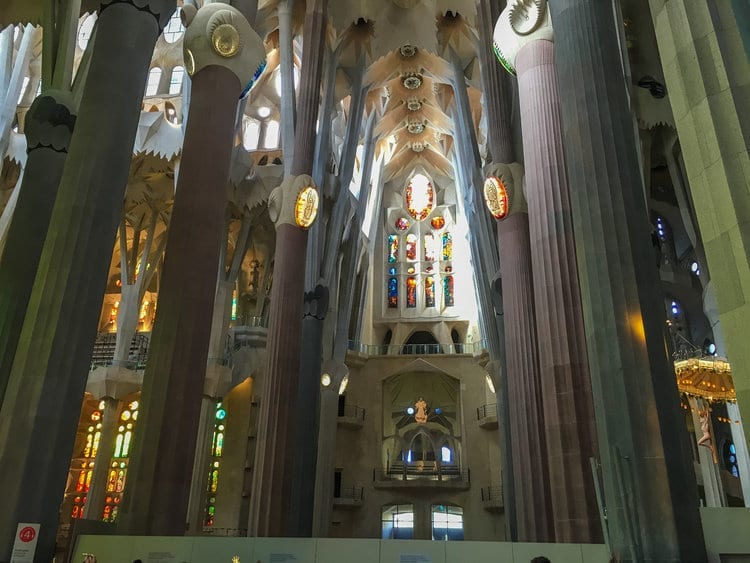
Gaudi combined classical Gothic architecture and Catalan art to create these star-like vaults on the roof, which light could easily pass through. The stars are formed by combining concave and convex hyperboloid shapes, which are systems used to disperse light and spread out the roof load of the stars also closely resemble the form of palm leaves, a powerful symbol in Christianity. Each vault centre is filled with a light diffuser decorated with colourful stained glass in various Christian symbols.

Natural Light
Light is one of the strongest symbols of faith in Christianity, so it was crucial to Gaudi to bring as much natural light as possible, the light of God, into the Basilica. Gaudi developed a new way of creating stained glass, comprised of three panes resulting in a mixture of tones and colours to cast a magical glow into the nave. The leading artist who created these windows was Vila-Grau. Vila-Grau used curved shapes to create abstract forms and ensured that the warm and cool tones were kept separate, resulting in this consistent light flow.
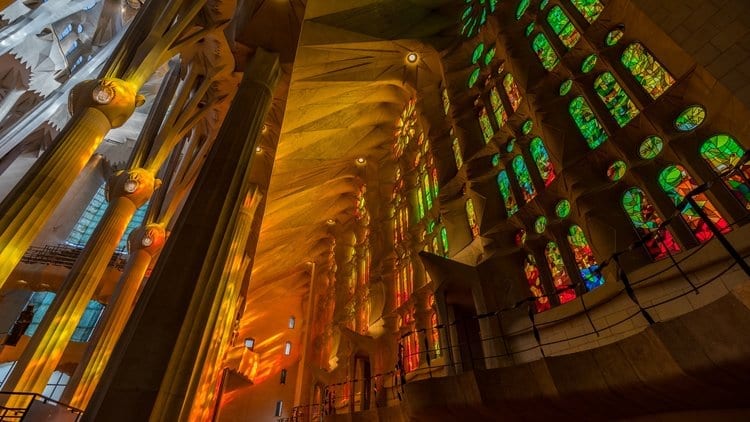
The Evangelist Capitals
Four Porphyry columns are capped with the Evangelists’ symbols, two on each side of the transept. The capitals are decorated with tetramorphs , the four angelic beings from Babylonian symbolism, which describe the vision of the Hebrew Prophet Ezekiel of the Evangelists. “As for the likeness of their faces, they four had the face of a man, and the face of a lion, on the right side: and they four had the face of an ox on the left side; they four also had the face of an eagle.” These capitals are lit from within to ensure they are always illuminated even when there isn’t any natural light.
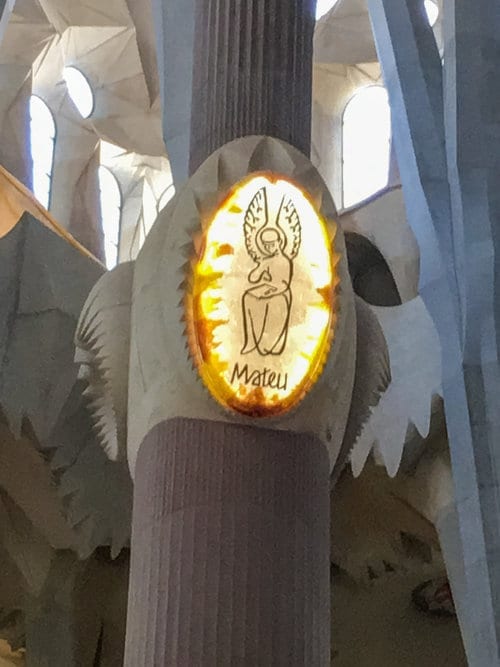
The High Altar
When you enter the church, before looking up (although I know that’s really hard), take a look at the flooring. The shimmery golden tiles are accented with two thick red lines. One of the lines symbolizes the ‘Path of Humanity,’ which runs from the Glory facade to the apse, and the ‘Path of Jesus Christ,’ which runs from the Nativity to the Passion facade. Where the two lines meet is where we find the high altar. The meeting of the divine and the human in one place here inside the church. The high altar has a ceiling two meters taller than the rest of the nave to give it that little extra touch of gravitas.
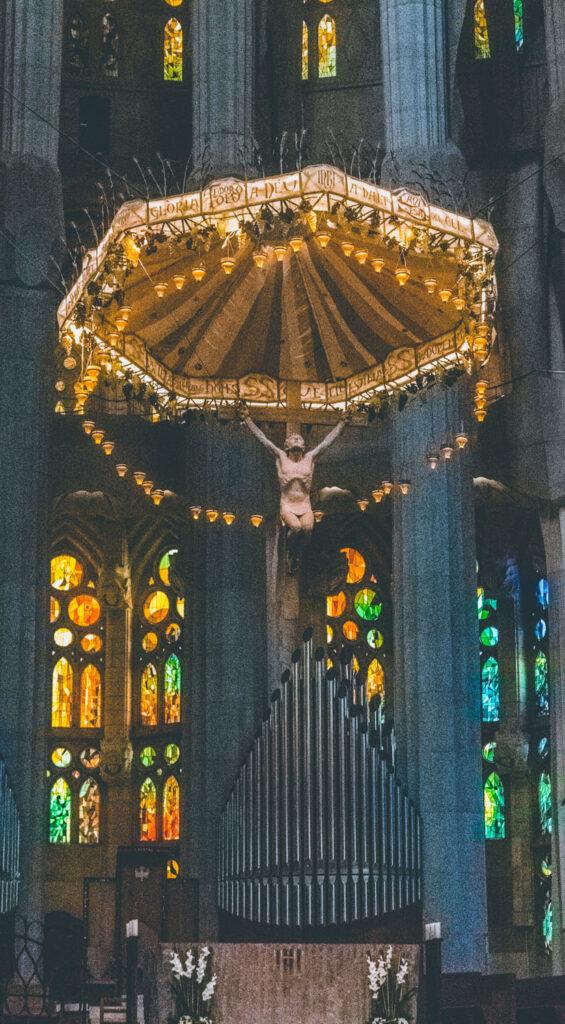
Over the high altar, we find the incredible sculptural masterpiece called a baldachin . A baldachin is a large canopy in a heptagon shape with seven edges, traditionally placed over an altar. These sever corners represent the seven gifts of the Holy Spirit; wisdom, understanding, counsel, fortitude, knowledge, piety and fear of the Lord. Fifty little hanging lights illuminate the rim of the canopy. Around the rim springs grape vines and wheat, the symbols of the Eucharist. A ribbon around the baldachin writes out the Prayer of Glory in back-lit red and Gaudí-style lettering.
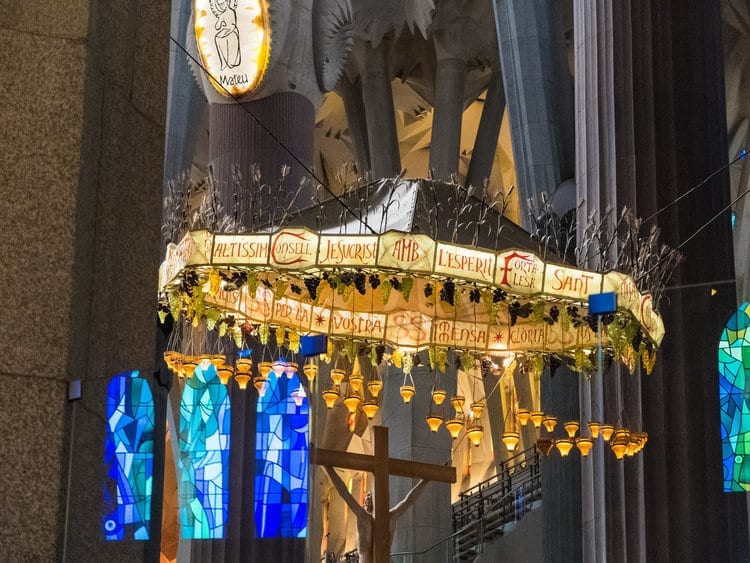
Saint Joseph Transept
Located on the Nativity side of the church is the Saint Joseph Transept, presided over by a large sculpture of Joseph himself. Joseph stands there prominently with a sceptre of lilies in his hand. Lilies represent his holiness and his celibate marriage to the Blessed Virgin. The walkway above the transept is made of dozens of Roman columns and is an easy way for the clergy to get around the church without interrupting the service. The stained glass windows featured on this wall are made of cool tones, and the morning light pours through this portion of the church.
One interesting aspect of studying stained glass is that the colours become denser and denser as we descend from the top down, letting in less and less light. This is so that the light is the brightest at the top, where you’ll find the divine, and lower to the ground, where we have humanity and slightly less light, creating a perfect space for meditation and reflection.
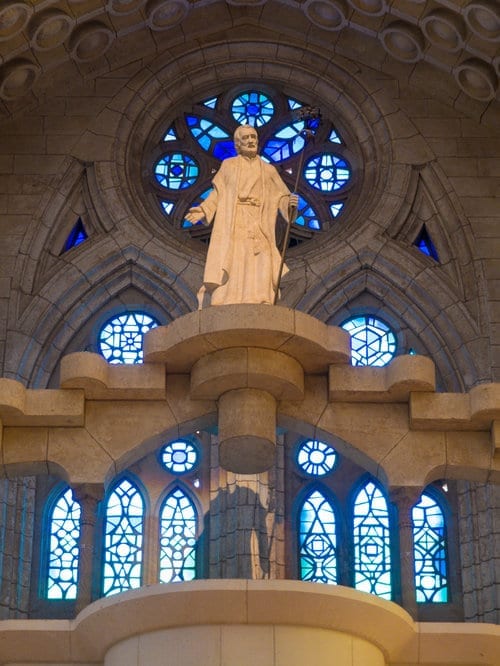
On the opposite side, facing the Passion Facade, is the Virgin Mary Transept. In the centre is the figure of the Virgin Mary under a simplistic, geometric star-shaped vault. Behind her is a beautiful example of abstract stained glass made by Joan Vila-Grau entitled ‘The Resurrection.’ This side faces the setting sun and is coloured with entirely warm tones, warm tones which make the heart feel full and content, expressing hope upon Jesus’ Resurrection.
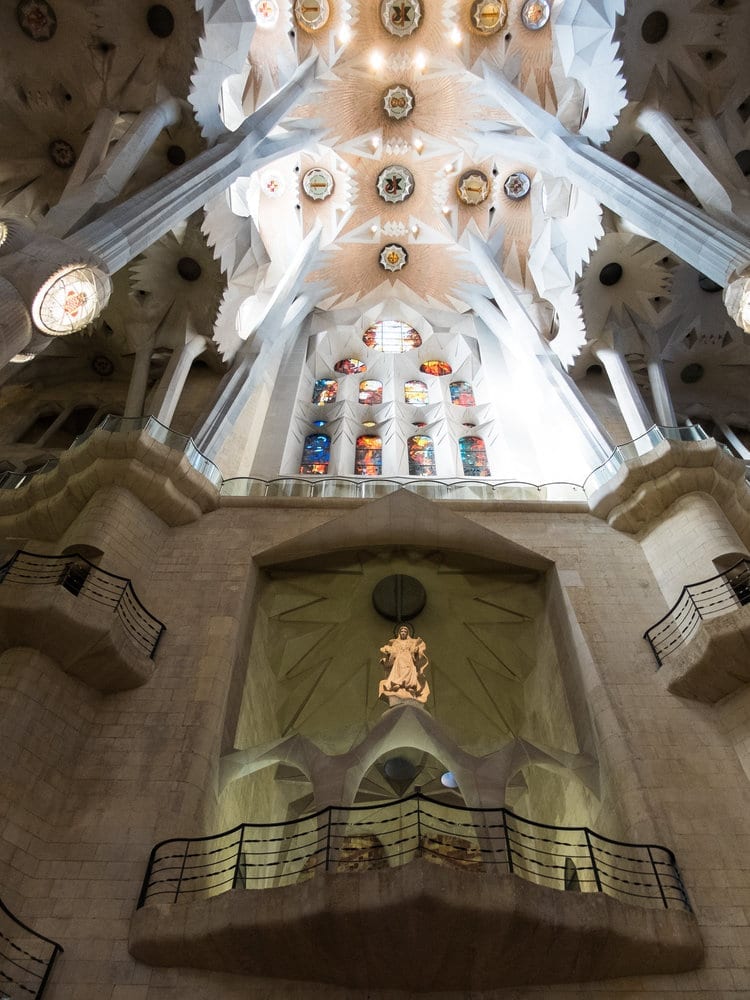
The Apsidal Chapels
The apse has seven chapels dedicated to the seven gospels of Saint Joseph. These chapels are lit from above and by impressive stained glass windows. In between these panels are the adorable carving of angel heads peeking out from the walls.
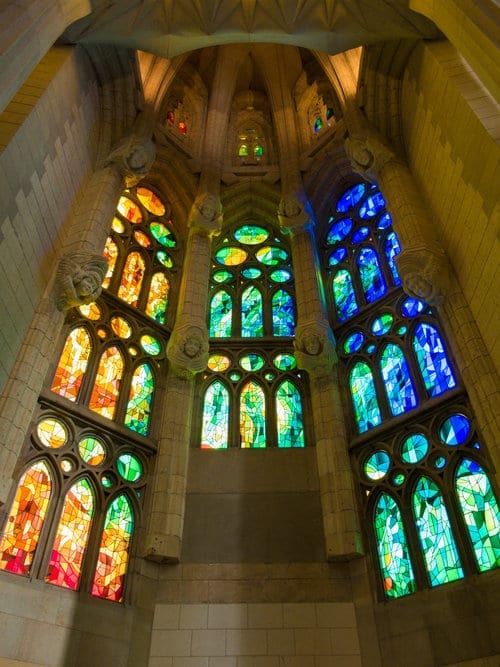
The Great Doorway
This entrance, called the Great Doorway, will eventually be the main entrance into the church once the Glory facade is finished construction. The two solid bronze doors will open out into the facade, weighing over two thousand kilos! The designer of these doors is the same one who made the Passion Facade, Josep Maria Subirachs . The doorways are inscribed with the words “Give us this day our daily bread” in fifty different languages. Above the door is the abstracted sculpture of Saint Geroge, the patron saint of Catalonia.
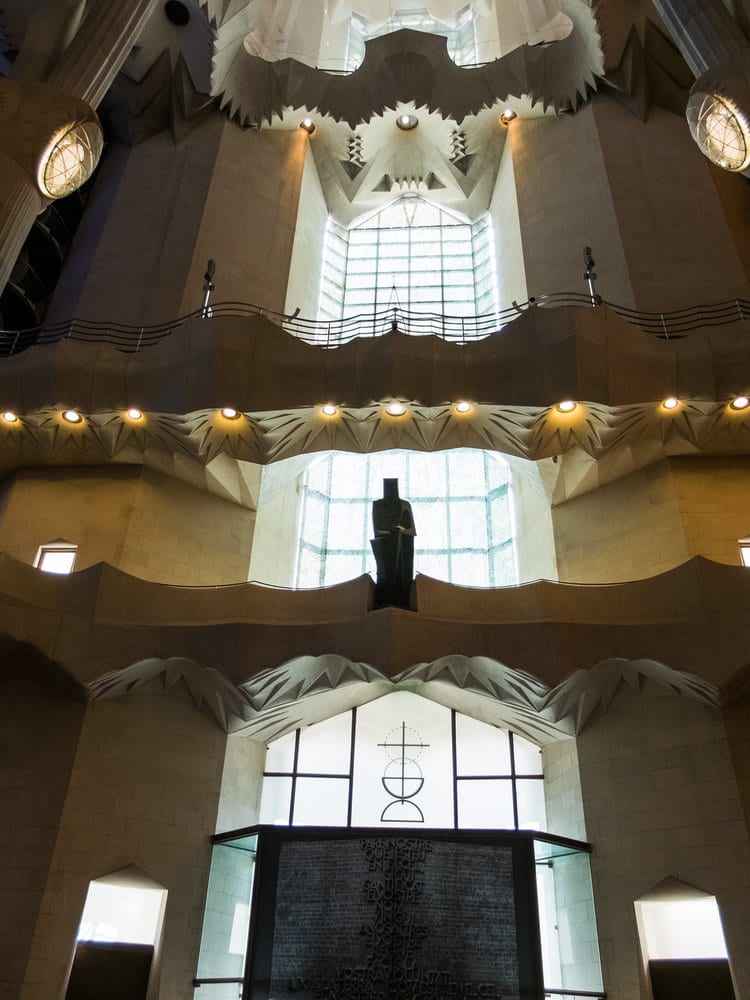
The Choir Galleries
Above the nave is a separate space that houses the choir during church services. This area can hold over 1000 singers since Gaudi wanted their voices to fill this enormous temple. Gaudi thought the importance of acoustics in the building to be of the utmost importance as he loved music so much. It was one of the few ways he could unwind and relax. The hyperbolic vaulting he used throughout the church was made to reverberate the sound throughout the church in a harmonious way and provide light.
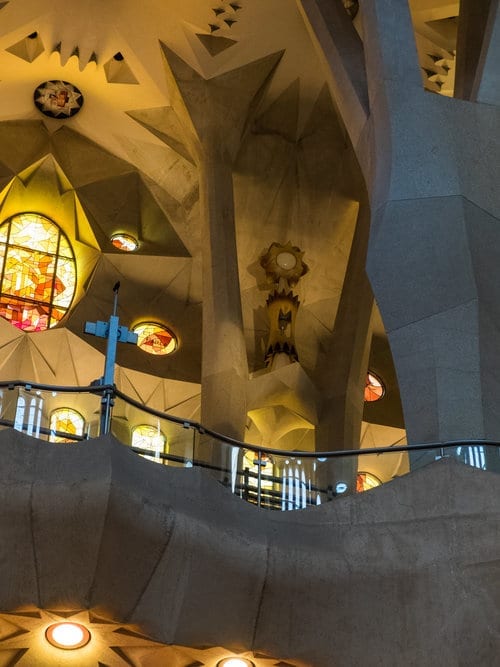
The large pipe organ looks almost holographic in certain lights and has over 1,492 pipes. And what a sound it makes when played. Gaudi wanted this organ and the music of God it created to fill the nave like the ocean. Washing across the worshippers and visitors alike.
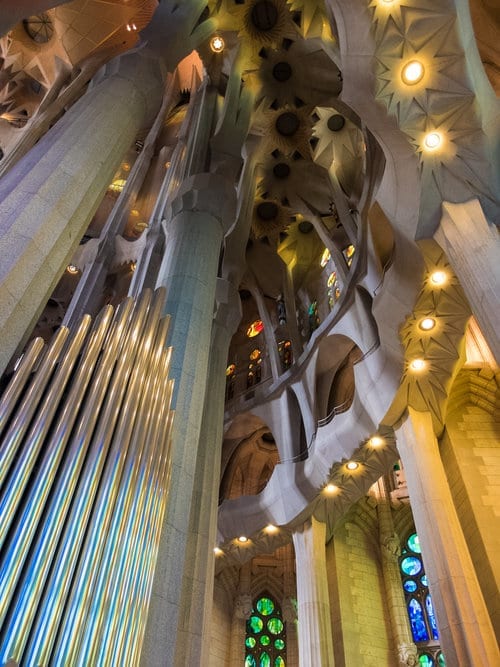
Winding Staircase
Gaudi didn’t ever want to break up the natural movement of the Basilica. No straight set of stairs would be acceptable. So Gaudi created these sets of winding staircases which the clergy could use to access the upper levels. The staircases are almost completely open, with some circular cutouts, similar to those in the cloisters, to ensure they are perfectly lit without artificial light.
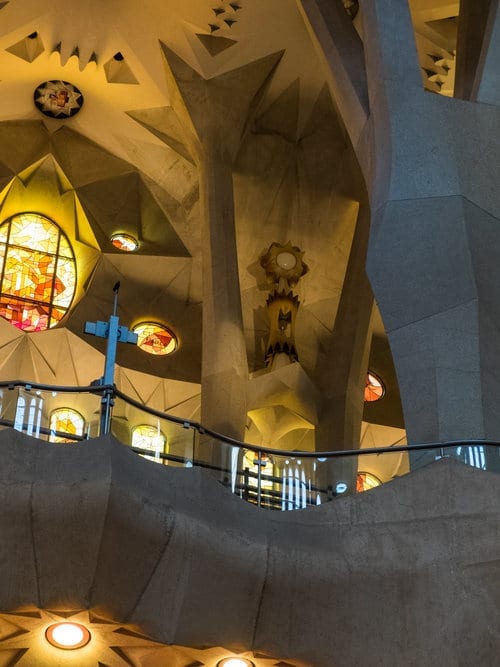
As you walk along the back of the nave, behind the altar, be sure to look down and see if you can peek into the small peepholes which open up into the crypt. Head down to see the interior of this hidden part of the church. The crypt, located under the nave and high altar, holds 12 chapels. The roof of the crypt is supported by 22 ribbed cross vaults, each decorated with shimmering keystones. Some of the keystones are adorned with scenes from the bible. The central keystone with the gold-leafed carving of Mary’s Annunciation is the most impressive. The bright gold brings the smallest details to life, making this image shine like a star underground.
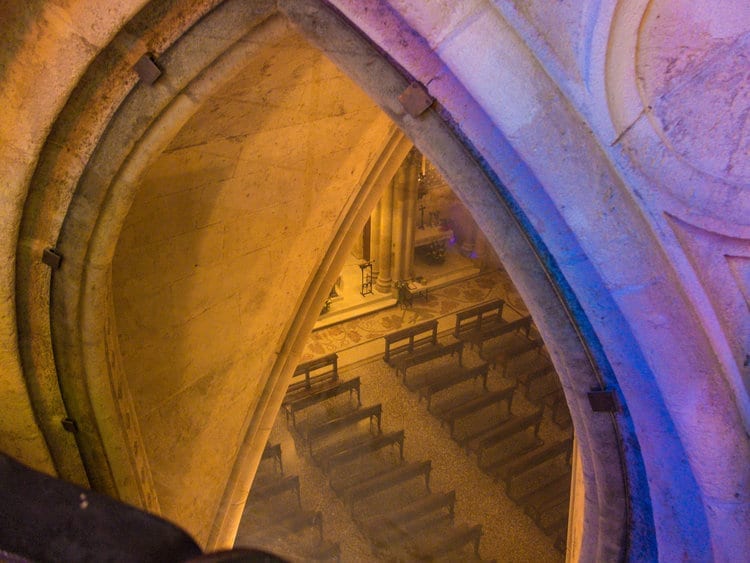
Chapel of Our Lady of Mount Carmel
You’ll find the Chapel of Our Lady of Mount Carmel inside the crypt. This chapel is of particular significance since it is where you’ll find Gaudi’s final resting place. Located on the far left-hand side of the front wall, his tomb is presided over by the Lady of Mount Carmel. Gaudi is laid to rest under a simple, jet-black tombstone.
Gaudi made it his mission to bring natural light into the otherwise darkened crypts. And he did so through those small holes in the vaults which bring light in from the nave. He also made sure to include a lot of vibrant stained glass. This created a feeling of lightness and brightness despite being underground. It is unlike any other crypt I’ve visited around the world. The stained glass within the crypt is decorated with images of angels, another interesting juxtaposition for a crypt since angels are generally found in the sky, whereas these ones are found buried under the foundation.
View this post on Instagram A post shared by José Luis Rodríguez Pineda (@joseluis661959)
The Passion Facade
The final portion of the tour of the church is the Passion Facade. This facade is located on the side of the building where the sun sets. The darkness reflects the ultimate sacrifice and death Jesus would incur. Compared with the ornate, natural forms of the Nativity Facade, the Passion Facade is gloomy, stark and restrained. Gaudi made sketches for this part of the church when he fell ill with a terrible sickness and almost passed away. This illness was the closest to death Gaudi would ever come since his eventual death would sneak up on him. During this sickness, he was consumed with fear. And he poured all these emotions into the design of this part of the temple.
While Gaudi died long before this part of the church began construction, architect Josep Maria Subirachs took up his mantle and made it his mission to create precisely what Gaudi had envisioned. Subirach’s figures are inspired by expressionism, in contrast to the realistic figures on the Nativity portal. There are over 100 figures depicted, grouped into 13 different scenes. They rise upwards in an S-shape, starting, in chronological order, with the last Supper and ending in the crucifixion.
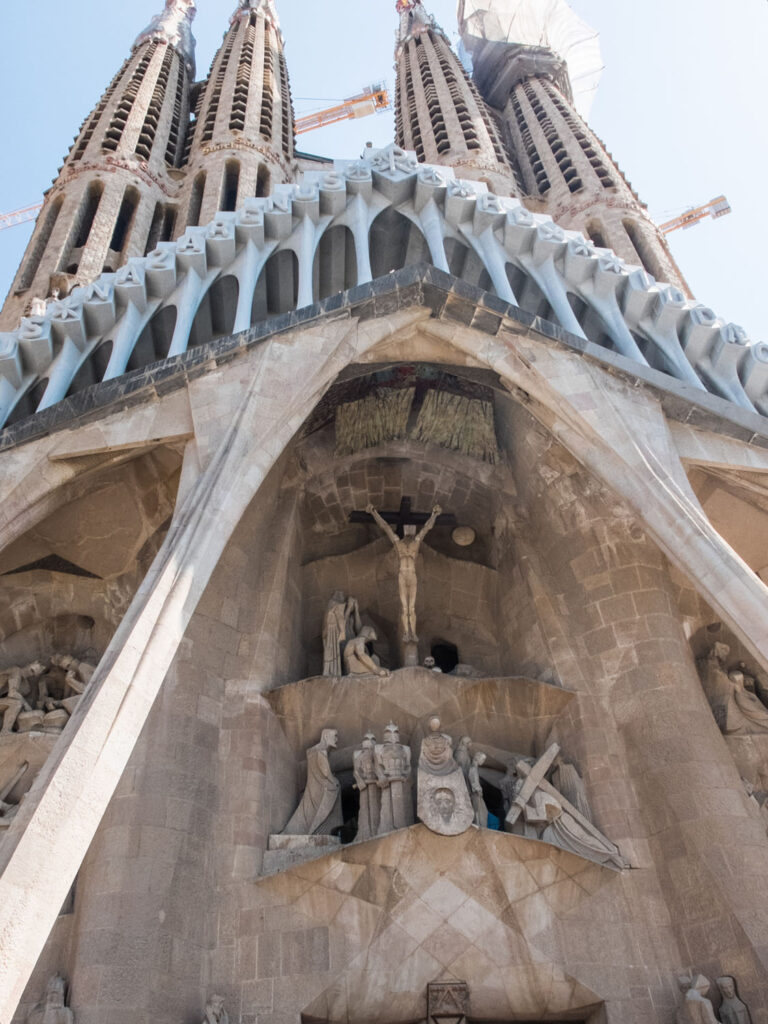
Capping the facade is the pyramid-shaped pediment. This pediment is formed with eighteen bone-shaped pillars, which symbolize those who died. The columns of the Passion Facade reach out towards the street. Unlike a regular column which just goes straight up, they are placed at an angle. Seemingly drawing the viewer in from the outside.
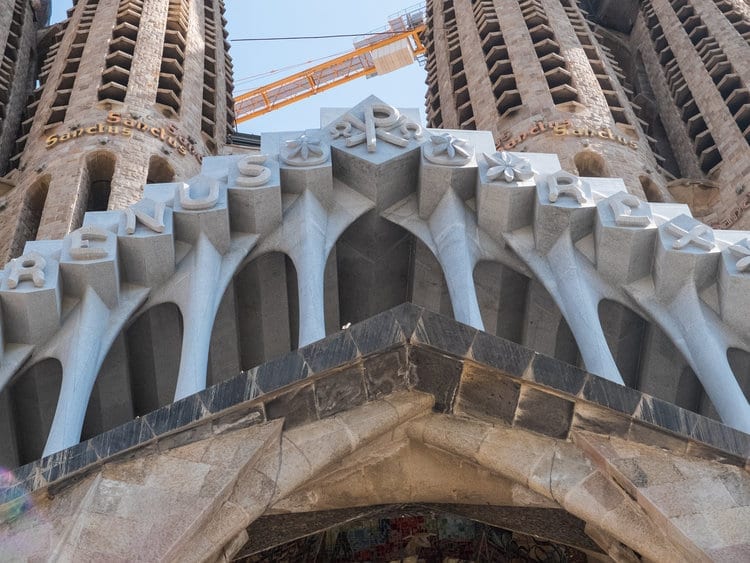
Last Supper
In the bottom left corner, we see Subirachs’ interpretation of Jesus in the Garden of Gethsemane during the Last Supper. All the faces we see here are gaunt and abstract. They seem less human, and each one appears to have an expression of sadness on their face. Jesus turns to his disciples to explain what will happen as Judas is off to the side, accepting the blood money for betraying his friend.
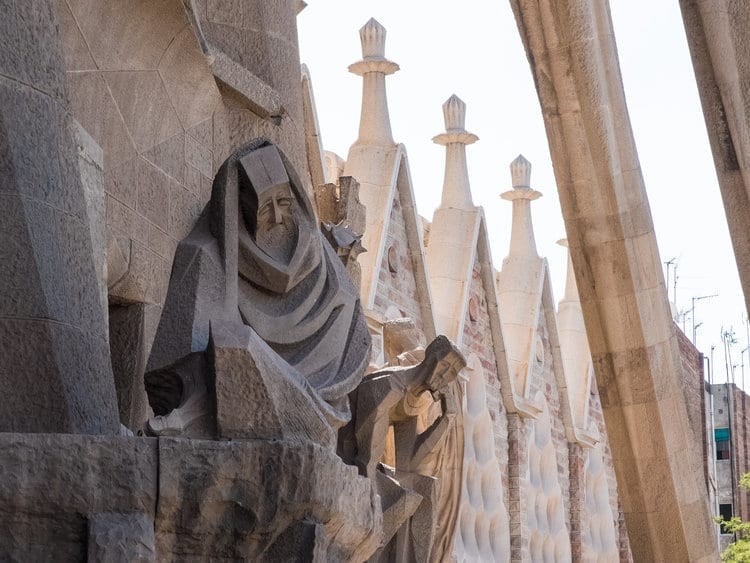
The Kiss of Judas
We then move to the scene where Juda kisses Jesus, indicating he is the man whom the Roman soldiers must arrest. In the bottom right corner of this scene, you’ll see the snarling face of a snake. The snake represents the devil as this reptile is regarded as one of the lowest terrestrial animals, closest to the devil’s lair. Besides the two men is a set of numbers on a grid called the ‘magic square.’ The magic square features a collection of numbers which, when added either along one row, one column or diagonally across, always add up the same number. In this case, the number is 33. 33 is the age at which it is thought that Jesus Christ died; it also contains the number 3 twice, which is the symbol of the holy trinity.
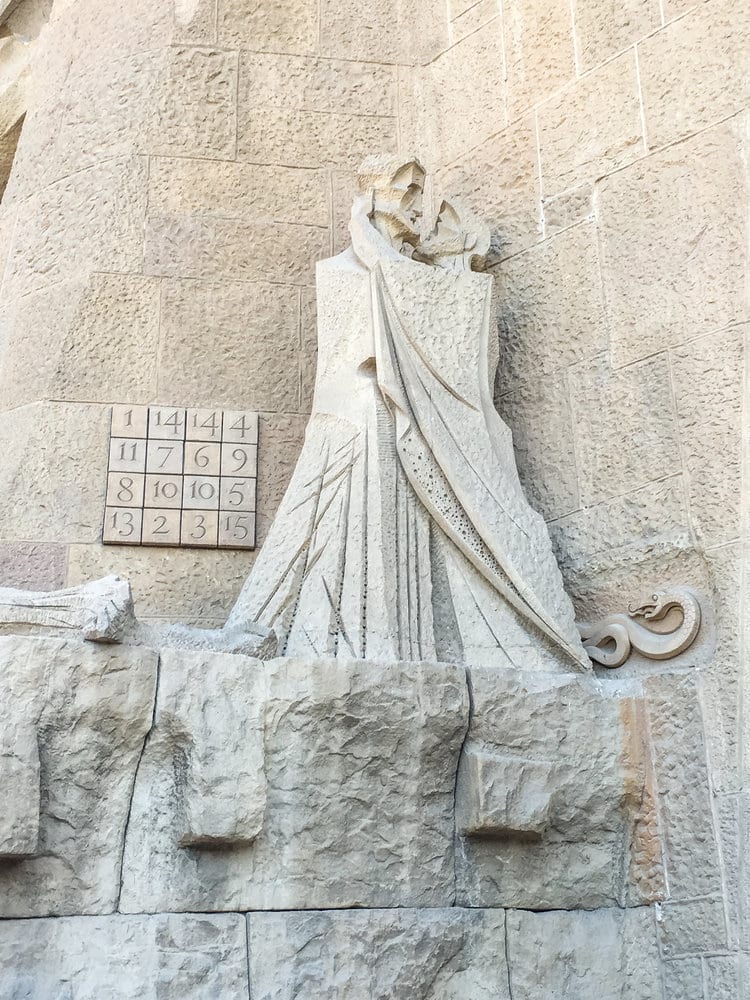
The Flagellation Column
On the main level, in the centre, we have the Flagellation Column. Bringing this scene almost at eye level with the visitors is a critical choice and, once more, brings humanity back to this otherwise godlike man. Everywhere else where Jesus is depicted, he is within a group, but here he is totally alone. An interesting detail is the three steps which lead up to the column, symbolizing the three days between Jesus’ crucifixion and the resurrection. Subirach used travertine marble to carve the column, the same stone used in all the buildings in ancient Rome.
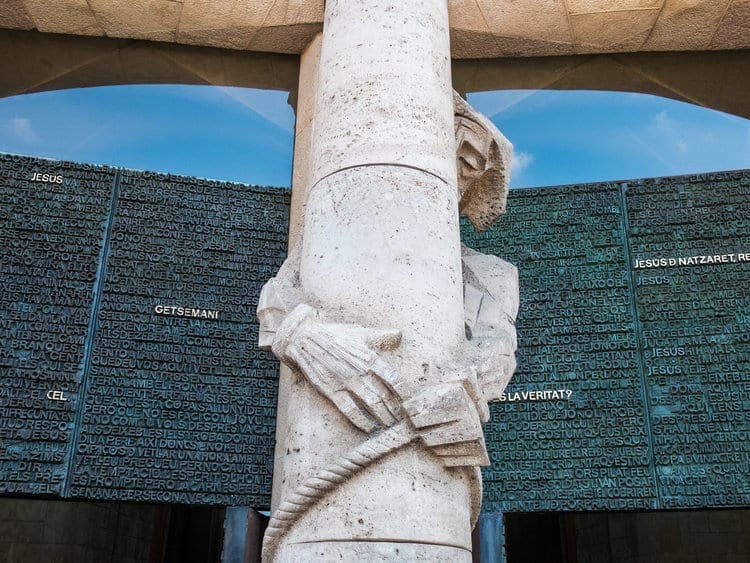
The Bronze Doors
Three broad sets of bronze doors are set behind and on either side of the Flagellation Column. On the right, we have the Gethsemane door; in the centre is the Gospel door and on the left is the Coronation of Thorns. The main entrance used today into the church is through the Gospel door. This door contains thousands of raised letters with passages from various texts relating to the last days of Jesus’ life.
The Gethsemane door looks almost like a sketchbook. It combines text and images relating to the prayers Jesus’ made in the Garden of Gethsemane, pleading for God to change his mind and save his mortal life. The Coronation of Thorn’s door has two main scenes. One of the scenes depicts the soldiers presenting Jesus to Herod and Pontius Pilate and being crowned with thorns. The top scene is of the humiliation of the soldiers who tortured Jesus on the way to the cross.
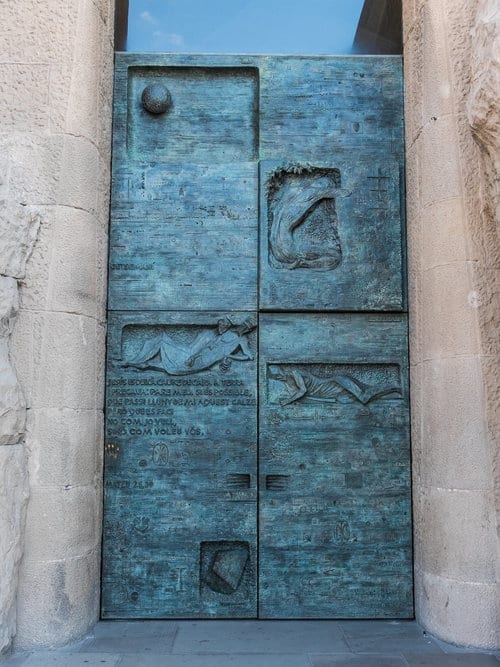
The Denial of Peter & Ecce Homo and the Trial of Jesus
This sculpture depicts the three times Peter denied he knew Jesus, represented by three women. He wears a large sheet, a symbol of cowardice. In the next scene, we see Pilate presenting Jesus to the people. In the final scene, we see Pilate washing his hands as he announces to the crowd, “I am innocent of this man’s blood; see you to it.”
The Three Mary’s and Simon Cyrene
In the next vignette, we see the three Marys; The Virgin Mary, Mary Magdelene and Mary of Cleophas. On the ground is the fallen form of Jesus, and the man carrying the cross is actually Simon Cyrene, who helped Jesus take the cross to the sight of the crucifixion. It is thought that this man showed sympathy for Jesus as he walked, so the soldiers forced Cyrene to carry the cross, another example of the soldier’s cruelty. Now, Simon Cyrene is considered the patron saint of passersby.
Veronica and the Evangelist
Over the Gospel door, we find the scene where Jesus falls again. A woman named Veronica bends down to brush the blood off his face with a cloth, and when she removes it, the face of the Messiah is imprinted on it. The carving of Jesus’ face on the cloth is masterfully done, and no matter where the viewers go, Jesus’ eyes seem to follow. To the left of the group, you’ll see the legionnaires whose armour was made in the shape of Gaudi’s famous chimneys from Casa Milá, a little reference to Gaudi’s history.
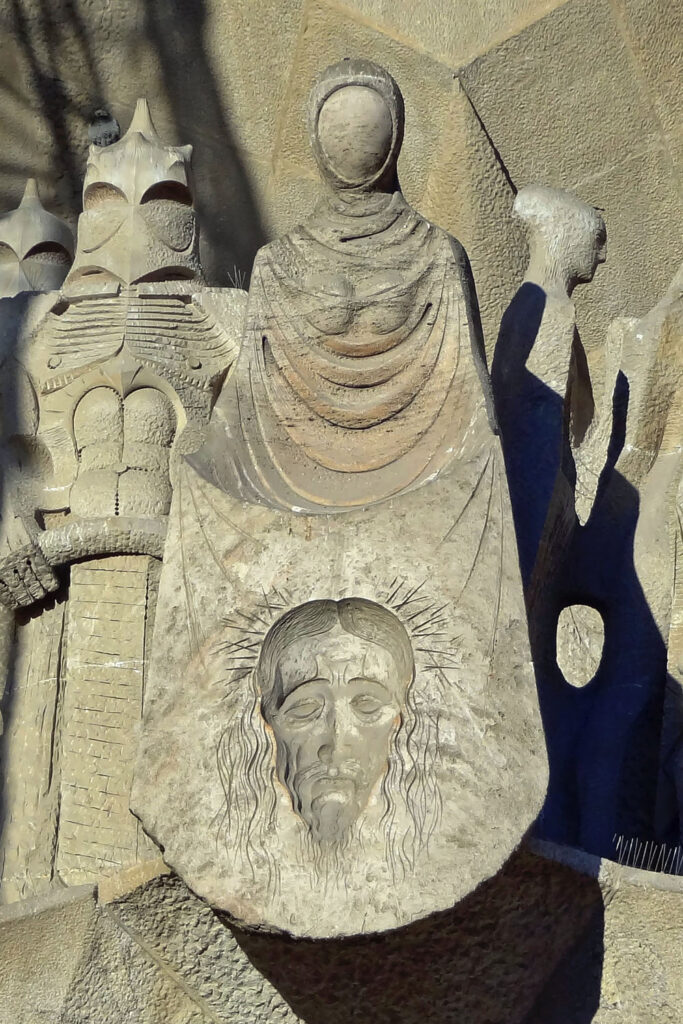
Saint Longinus
The figure to the right of Veronica is a Roman soldier on horseback. This is Saint Longinus, who was a Roman general that stuck a spear into Jesus. Legend has it that Longinus was half blind, but when he speared Jesus, a drop of blood spurted into his eyes, and they were healed. Upon this miraculous healing, Longinus repented of his sins and converted to Christianity.
Soldiers Player Dice
We have a small group of Roman soldiers to the left of the crucifixion scene. They can be seen playing a dice game. The victor of this game would win Jesus Christ’s clothing and possessions. A heartless moment but another depiction of the cruelty of man.
The Crucifixion
The top of the facade is dominated by the form of Jesus Christ crucified on the cross. He is tied to a cross composed of two iron beams. The iron beam meets to form the shape of an “I.” This is thought to recall “INRI,” which in Latin stands for ‘Iesus Nazarenus Rex Iudaeorum’ meaning ‘Jesus of Nazareth, King of the Jews, something which they nailed over Jesus on the cross as he lay dying. At his feet is the sobbing form of Mary Magdalene, while the Virgin Mary stands to the side, her face in her hands, consoled by St. John. At the base of the cross, we can make out a skull symbolizing Jesus’ final death. In the upper right corner, we can make out a full moon, as it is said that the night he died, there was a full moon.
To the right of the Crucifixion scene, we have the burial of Christ. In this sculpture, we see Joseph of Arimathea and Nicodemus preparing and wrapping Jesus’ body to make it ready for the tomb. The image of Nicodemus is actually a self-portrait of the sculptor Subirachs. In the background is the Virgin Mary with an egg on her head, symbolizing the resurrection.
The Passion Vaults
Under the vaults of the Passion’s portico, when you look up, you’ll see a torn cloth hanging in front of a brightly coloured mosaic. The enormous torn fabric acts almost as a type of baldachin hanging beneath the cross. In the Temple of Jerusalem, there was always a large cloth that separated the holier areas of the temple from the ordinary people. At the very moment of Jesus’ death, it was said that this cloth split in two, bringing together common people and God as one. The glasswork is Venetian and contains texts and imagery relating to the resurrection. Unlike the rest of the facade, which is bleak and monotonous, this hidden bright spot is representative of the hope that Jesus’ resurrection gave the people, always present but hiding in the darkness.
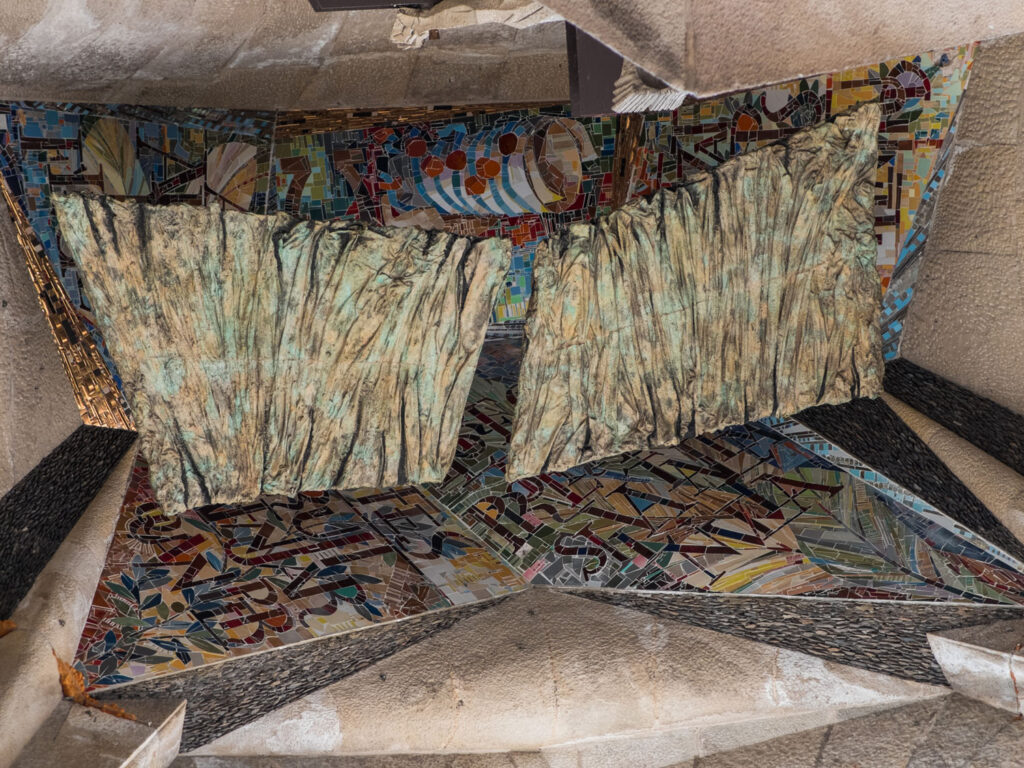
The Glory Facade
The Glory facade is the one part of the church which has not begun construction. This side faces the midday sun when the sun is the brightest and therefore exemplifies the idea of Glory and Hope. The design of the Glory facade is made up of a series of large lanterns and a grouping of fluffy white clouds. The three types of clouds represent the Holy Trinity: the Father, Son and Holy Spirit, each inscribed with words of prayer. By entering this doorway, worshippers will have a sense of movement through the earthly plain into the divine heavens.
The Schoolhouse
Outside the Passion, the facade is a small building, a recreation of the 1909 original, which once served as the children’s schoolhouse. During the Basilica’s construction, there were so many workers that they needed a dedicated school to cater to their children. Gaudi made it his mission to educate these kids and create a beautiful place for them to do it. You can enter the old schoolhouse, study the Catalan vaulting technique he employed here, and study the classroom’s various details. You can even see some of the things the children studied during their time here.
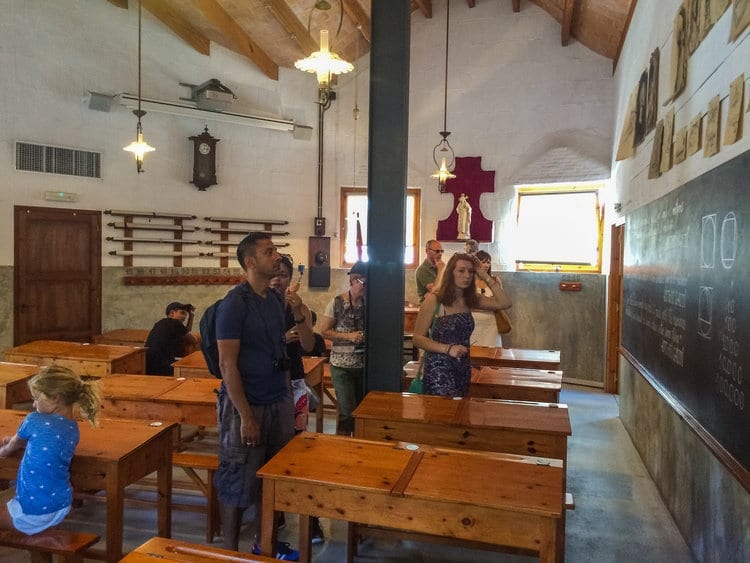
The Gaudi Museum
Located in the basement of the cathedral is the Antoni Gaudi Workshop and Museum. Although many of the original documents and plans were destroyed when a bomb went off during the Civil War, this newly created space is where the city has taken it upon itself to conserve, restore and put on display pieces of the history of the construction of this church. You can find drawings, period photographs, ceremonial furniture and several scale model copies of the originals. There is also a model of the original workshop where Gaudi would spend all this time.
If you’ve made it all the way through, I commend you and know that I appreciate the time you took to understand the immense amount of history, art and cultural values instilled in this incredible temple. I genuinely wish I could spend every day here, and I hope your time visiting this space is just as magical as mine was.
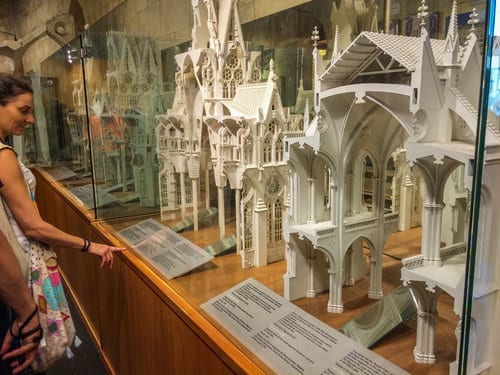
Have you been here before? What was your favourite thing to see? If you’re on your way, let me know what you’re looking forward to the most.
Happy Travel Adventurers
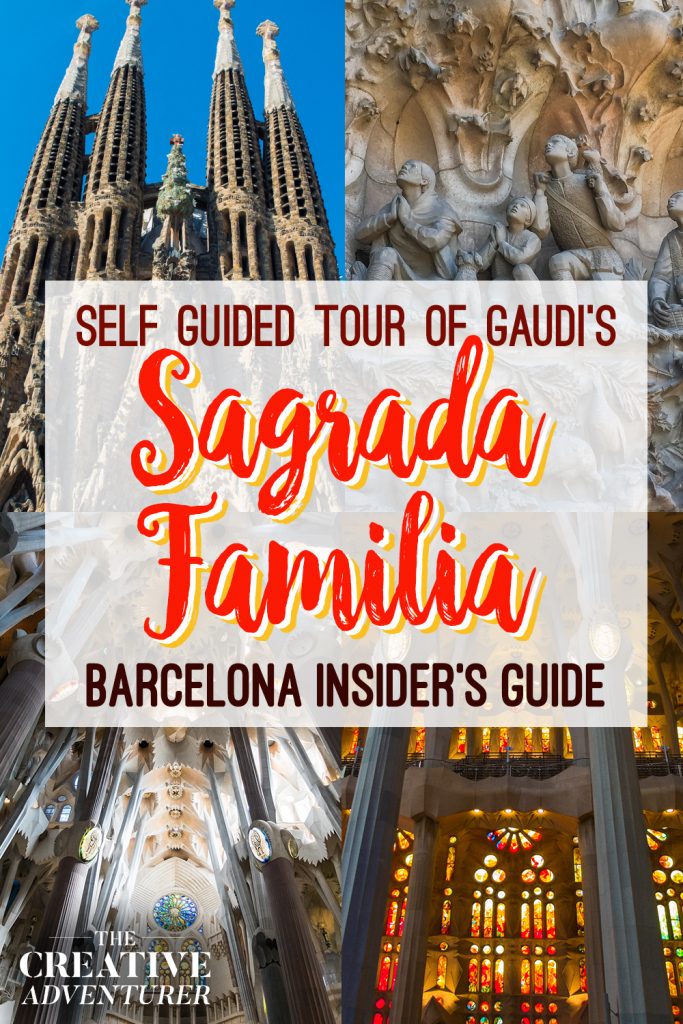
« The 11 Best Instagram-Worthy Spots in Harajuku!
The ultimate highlight tour of la sagrada familia, an insider’s guide to barcelona », you may also like.
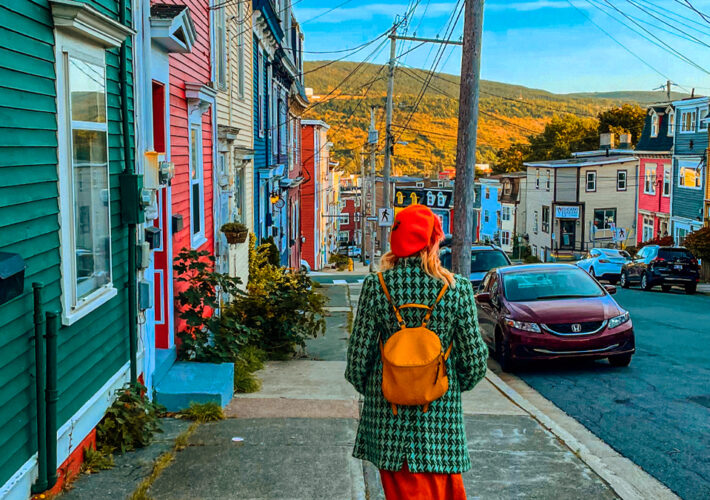
Newfoundland’s 10 Most Colourful & Beautiful Places to Visit
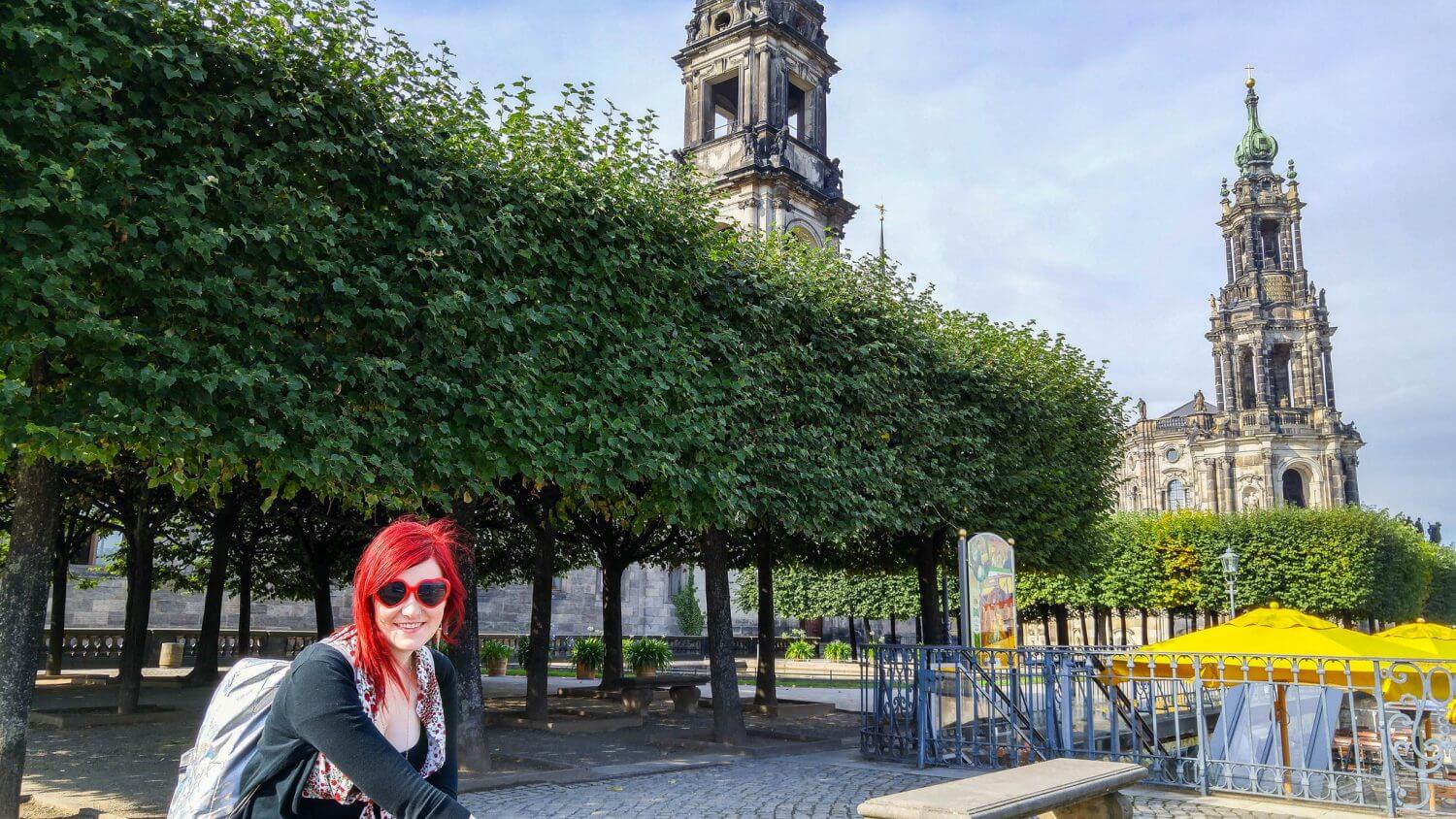
A Complete Guide to Visiting Brühl’s Terrace in Dresden

Your Ultimate Guide to Exploring the Village of Arashiyama, Kyoto
On the Passion facade, your burial information is not correct. It is Joseph of Arimathea and Nicodemus who were responsible for preparing and wrapping up Jesus body to make ready for the tomb. In the background is the Virgin Mary with an egg on her head, a symbol of the resurrection. The image of Nicodemus is actually a self-portrait of the sculptor Subirachs. xx
laura.f.whelan
Thank you ever so much Karla for taking the time to send me this information! I’ve gone ahead and updated the post to reflect those changes. I truly appreciate it as I’m always learning myself from others! Cheers, Laura
Leave a Comment Cancel reply
Your email address will not be published. Required fields are marked *
Copyright @ 2023 The Creative Adventurer | All Rights Reserved | Privacy Policy
Lions in the Piazza

Barcelona’s Ruta del Modernisme: a Self-Guided Walking Tour
There’s no better place to experience Art Nouveau architecture than in Barcelona. The dynamic forms, innovative materials, and exquisite craftsmanship acquired a deep significance in Catalonia. Known as Modernisme in Catalan (or Modernista in Spanish), the style inspired a generation of remarkable talent. Architects Lluís Domènech i Montaner, Josep Puig i Cadafalch, and others designed endlessly inventive fusions of engineering, light, and decorative art. Antoni Gaudí i Cornet went even further, exploring structure in ways we’re just beginning to understand a century later. For most visitors, the challenge in Barcelona is how to choose between a staggering array of landmark structures.
Ruta del Modernisme: the Modernisme Route
The definitive resource for Catalan Art Nouveau is the Ruta del Modernisme , a multi-day walk sponsored by the Barcelona City Council. It covers 115 monuments and a slew of related attractions in the city proper, plus separate routes for both commercial establishments and sites in surrounding areas. The 200+ page guidebook, published in 2005, is available only on the website and in local Ruta offices. (We had trouble tracking down an English translation and managed to find a used copy on eBay.) While the book may be indispensable for die-hard Modernista fans, most visitors won’t have time for the full route. Moreover, some may struggle with the format. There’s a condensed one-day walk and a list of 30 starred monuments, both of which require skipping around the book. The Ruta website lists major monuments, but presents them in alphabetical order with outdated information.
We spent a full week following the Ruta del Modernisme in Barcelona and compiled a guide to the most important works, plus a few lesser-known favorites. This post covers everything within walking distance of the city center, organized by area. Our Google map shows monument names and official Ruta numbers, and we’ve also included addresses and websites in the text. The most important buildings have the Ruta Del Modernisme symbol embedded in the pavement in front of the site.

We’ve broken the route down to 28 sites in eight different neighborhoods:
Parc Ciutadella : Castell dels Tres Dragons, Hivernacle, Umbracle
La Rambla and the Old City : Mercat de Boqueria, Palau Güell, Palau de la Música Catalana
Lower Eixample : Casa Calvet, Block of Discord (Casa Lleó Morera, Casa Amatller, Casa Batlló)
Eixample between the Plaça Catalunya and the Avinguda Diagonal : Fundació Antoni Tàpies, Casa Thomàs, Palau Montaner, Casa Milà
Along the Avinguda Diagonal : Casa Serra, Casa Sayrach, Casa Fuster, Palau Baró de Quadras, Casa Comalat, Casa de les Punxes, Casa Macaya
Above the Avinguda Diagonal : Sagrada Familia, Hospital de la Santa Creu i Sant Pau
Gràcia : Casa Vicens, Cases Ramos, Park Güell
Parc Montjüic : Fàbrica Casamarona/CaixaForum, Museu Nacional d’Art de Catalunya
Catalan Modernisme: an Introduction
Catalonia’s industrialization in the 19 th century – and the ensuing transformation of everyday living – happened during a period of major cultural and political upheaval for the region. The Renaixença , or rebirth, of Catalan identity encouraged artists to (re)discover and celebrate local traditions. Barcelona’s new school of architecture, Spain’s first outside of Madrid, fostered a community focused on meeting the needs of the new world with a fresh perspective on the past. Many leading architects became involved in politics: Domènech and Puig both held political offices, while Gaudí famously got himself arrested for speaking in Catalan rather than Spanish to a policeman.

Meanwhile, the city’s physical and economic growth led to a building boom, especially in the gridded streets of the Eixample (“Addition”). This gave Modernisme, a relatively brief architectural movement, an outsized impact on the city of Barcelona. Almost all the buildings mentioned here were built over a span of just 30 years, roughly the late 1880’s to the 1910’s.
Parc Ciutadella

For over 150 years the Spanish government had ruled over Barcelona from a much-detested military citadel. In the 1880’s, the city finally received permission to raze the site and develop it as a park for the Universal Exhibition of 1888. The Parc Ciutadella became an emblem of Catalonia’s emergence as an economic and cultural powerhouse – and its quest for independence from the national government.
Castell dels Tres Dragons

At the corner of the park, a young Domènech contributed two significant buildings inaugurating Modernisme. By combining traditional Catalan brickwork with an innovative modular system (anticipating industrial construction methods), Domènech’s designs could be built in just a few months at low cost. The hotel was later dismantled, but the café-restaurant, often referred to as the Castell dels Tres Dragons, still exists although it’s now a museum of zoology. Currently the building is closed; it appears a restoration is in progress, although the website has no information. Ruta #3: Pg. de Picasso at Pg. de Pujades.

Next door, Josep Amargós i Samaranch’s Hivernacle (greenhouse) of 1883-87 is an example of early industrial architecture. The structure is currently under restoration. Ruta #4: Pg. de Picasso, 7.

Further down, Josep Fontserré i Mestres’s 1883-84 Umbracle (shade house) uses an unusual combination of brick with wood slats as well as glass and iron. Ruta #5: Pg. de Picasso, 13.
La Rambla and the Old City
Modernisme transformed Barcelona’s shops and businesses as well as private homes and larger edifices. Most of the commercial areas, however, were located in the older parts of the city and consequently the style was restricted to mostly to interior renovations rather than new construction. The Ruta del Modernisme has a special guide called Sortim (“Let’s Go Out”) for visiting establishments like the legendary Quatre Gats café.
Mercat de la Boqueria

The Mercat de la Boqueria is one of several market halls which pioneered the use of cast iron, steel beams, and wide expanses of glass, paving the way for Modernisme. Ruta #16: La Rambla, 91.
Palau Güell

From the fortress-like entrance paying tribute to the neighborhood’s medieval roots to the shocking roofscape of roiling bricks and alien chimneys, it’s hard to believe the spaces in the 1885-89 Palau Güell belong to the same building.

Gaudí’s orchestration of every step of the journey shows a command of light and a flair for drama to rival Caravaggio. Visiting information on website . Ruta #8: Carrer Nou de la Rambla, 3-5.
Palau de la Música Catalana

The epitome of Catalan Modernisme, every inch of Domènech’s Palau de la Música Catalana (Catalan Music Hall) of 1905-08 brims with color, light, form, and texture.

The Orfeó Català choral music society was a cause dear to the architect’s heart, and designing its new home seems to have given him a special inspiration which infected everyone working on the project. Possibly the most joyful building ever constructed, the Palau is a perfect complement to the atmospheric Born district. Visiting information on website . Ruta #24: C/ Palau de la Música, 4-6.
Lower Eixample
Casa calvet.

Located near the transition from the old city to the gridded streets of the Eixample, the 1898-99 Casa Calvet is itself a transitional work. Although Gaudí’s first residential building – with offices and commercial space on the ground floor – seems fairly tame compared to his other work, one can spot hints of his mad genius in the ornamentation. The wrought iron railings and reliefs represent fungi since the original owner of the building was an amateur mycologist. A restaurant on the ground floor seems to have closed. Ruta #27: Carrer de Casp, 48.
Block of Discord
Barcelona’s epicenter of Modernisme, the “Block of Discord” on the Passeig de Graacia, features work from each member of the great triumvirate. Domènech, Puig, and Gaudí were each commissioned to renovate a building, although not at the same time. Working within the constraints of existing structures and collaborating with many of the same artists and craftsmen, they managed to create strikingly distinct visions.
Casa Lleó Morera

Sadly, Domènech’s 1902-05 Casa Lleó Morera isn’t open to the public, but the wraparound façade features some of the same exuberance as his Catalan Music Hall. (A boutique on the ground floor obscures the original interior.) According to legend, the little tower was used as a sniper’s nest during the Civil War. Ruta #43: Pg. de Gràcia, 35.
Casa Amatller

A few doors down, Puig renovated the Casa Amatller for a chocolate baron in 1898-1900. The Neo-Gothic building bursts with references to local landmarks such as Palau de la Generalitat as well as local legends such as the perennially-popular Saint George and the dragon. Some critics consider its façade to be the pinnacle of decorative arts in architecture. Visiting information on website . Ruta #44: Pg. de Gràcia, 41.
Casa Batlló

Gaudí’s 1904 Casa Batlló also features a dragon, now as a transformed into a shimmering, writhing roof. Whimsical and endlessly surprising, this building demonstrates the exceptional nature of Gaudí’s talents; next to the Batlló, even Domènech and Puig’s work looks conventional. Astronomically-priced tours include distracting special effects and installations. Visiting information on website . Ruta #45: Pg. de Gràcia, 43.
Eixample between the Plaça Catalunya and the Avinguda Diagonal
Besides the Block of Discord, the Eixample between the Plaça Catalunya and the Avinguda Diagonal contains the highest concentration of Modernisme buildings in the city. Some of the most notable include:
Fundació Antoni Tàpies

Domènech’s pioneering 1881-86 Editorial Montaner i Simón, now the Fundació Antoni Tàpies, drew from industrial structures such as railway stations, with metal pillars and beams supporting massive skylights. The brick façade’s Mudejar-inspired accents brought a uniquely Spanish flair to the otherwise streamlined design. Tàpies’s huge, abstract wire cloud crowning the building makes an interesting contrast. Visiting information on website . Ruta #46: C/ d’Aragó, 255.
Casa Thomàs

In the 1895-98 Casa Thomàs, Domènech used different materials for the two side towers to keep the façade lively. His son-in-law, Francesc Guàrdia i Vidal, added the top three floors in 1912. The design store on the ground floor preserves some of the original interior. Ruta #65: C/ de Mallorca, 293.
Palau Montaner

On the next block, the Palau Montaner houses the offices of the Spanish government in Catalonia. Josep Domènech i Estapà designed the building in 1889, but fell out with the owner midway through construction. Domènech took over, adding a spectacular entrance hall with a grand staircase and a huge skylight. He also added the dramatic eaves and most of the ornamentation. Ruta #66: C/ de Mallorca, 278.

Gaudí’s iconic Casa Milà dominates the upper Passeig de Gracia. Known locally as La Pedrera (the stone quarry), this 1905-1910 apartment complex only looks carved out of rock – in fact, the stone façade hangs off a steel frame in the same way modern skyscrapers hang curtains of glass.

The current setup in the Casa Milà takes visitors through the building in reverse order – for example, the residential level starts in a back bedroom and finishes at the front door – which detracts from the experience. We do, however, highly recommend the ground-floor restaurant. Visiting information on website . Ruta #67: Pg. de Gràcia, 92.
Along the Avinguda Diagonal

Puig’s 1903 Casa Serra has been called “one of the best examples of single-family urban mansions in Barcelona.” We were intrigued by the 1987 addition of an ultra-contemporary section in smoky glass. Ruta #69: Rambla de Catalunya, 126.
Casa Sayrach

Manuel Sayrach i Carreras designed the Casa Sayrach while still a student, so the building’s owner had to sign the drawings. The 1918 façade’s curving forms echo Gaudí’s work, with a tiny tower on the corner in a nod to Domènech.

Unfortunately the apartment building isn’t open to the public, although we got a tantalizing glimpse of the lobby through the windows. Ruta #71: Av. Diagonal, 423, 425.
Casa Fuster

The 1908-11 Casa Fuster shows Domènech contending with three separate street facades with his usual panache. Originally a single-family house, the building was later used as offices and an exhibition hall before being converted into a hotel in 2000. Unfortunately, very little of the interior finishes survived. Ruta #75: Pg. de Gràcia, 132.
Palau Baró de Quadras

Another Puig building, the Palau Baró de Quadras of 1904 features two façades: a grand mansion on the Avinguda Diagonal, and a humbler rear revealing a block of flats. The interior looks exquisite based on a peep through the doors. The website says there are tours every Friday morning, but we found a sign at the back entrance listing only a few specific dates in July and August; we recommend emailing or calling ahead of time to confirm a visit. Ruta #76: Av. Diagonal, 373.
Casa Comalat
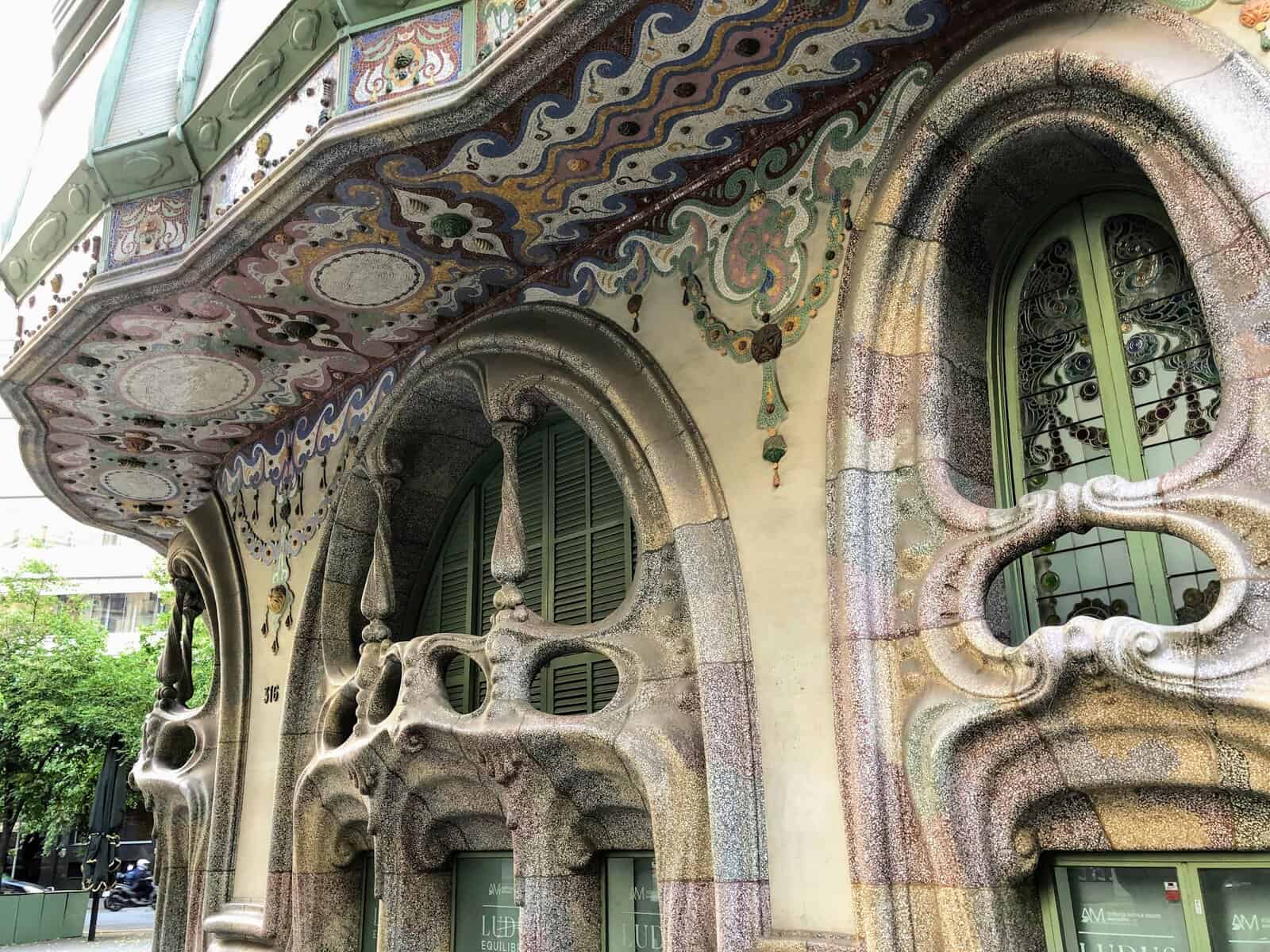
Designed by Salvador Valeri i Popurull, the 1909-11 Casa Comalat looks like a mash-up of Gaudí’s Casa Calvet and Casa Batllò, with a dash of Domènech thrown in for good measure.

Wildly different facades on the Avinguda Diagonal and the Carrer Còrsega make this worth a visit, even if the interior is closed to the public. Ruta #77: Av. Diagonal, 442.
Casa de les Punxes

Puig’s iconic 1905 Casa de les Punxes (House of the Spires) consists of three separate houses for a trio of sisters, merged into a medieval fantasy of spires and lacy stonework mixed with warm brick. Locals managed to preserve the panel depicting Saint George with its provocative legend – “Holy Patron of Catalonia, give us back our freedom” – all the way through Franco’s reign. The building is now used as a space for conferences. Ruta #78: Av. Diagonal, 420.
Casa Macaya

Casa Macaya – another Puig design, this one from 1901 – features a wonderful contrast between expanses of pure white and ornate details. It also uses traditional sculptural decoration to portray modern subjects, such as the cyclist in a capital near the front door. Apart from the entrance foyer and central courtyard, most of the original interior is gone. Free guided tours in Catalan and Spanish on a very limited schedule; check website for details. Ruta #79: Pg. de Sant Joan, 108.
Above Avinguda Diagonal
Sagrada familia.

The iconic Sagrada Familia lies just above the Avinguda Diagonal. Gaudí’s monument still sparks all kinds of controversies and more than a little awe. We recommend reserving tickets several weeks in advance, and visiting the Nativity Tower Façade (the only one Gaudí worked on). Traffic is somewhat lighter early in the day. For more information, see our full post and the official website . Ruta #81: C/ de Mallorca, 401.
Hospital de la Santa Creu i Sant Pau

A tree-lined promenade connects the Sagrada Familia to the 1902-26 Hospital de la Santa Creu i Sant Pau complex. With the possible exception of the Catalan Music Hall, this is Domènech’s masterpiece, harnessing his progressive social vision with the healing power of nature and beauty. For more information, see our full post and the official website . Ruta #82: Sant Antoni Maria Claret, 167.
Casa Vicens

From Avinguda Diagonal, it’s a 15 minute walk up the lovely Carrer Gran de Gràcia to the 1883-88 Casa Vicens. Gaudí appropriated Andalusian Islamic techniques to blur the boundaries between indoors and out, and showcase his client’s tile manufacturing capabilities.

It might not have quite the visionary wildness of his later work, but his absolute mastery of architecture makes this house a personal favorite of many visitors. Visiting information on website . Ruta #89: Carrer de les Carolines, 20-26.
Cases Ramos

A few blocks up, Pedro Almodóvar filmed some of All About my Mother at the Cases Ramos. Jaume Torres i Grau joined three buildings with a single, colorful façade in 1906. The central balcony features bee-shaped wrought-iron bannisters. Ruta #88: Pl. de Lesseps, 30.

Gaudí’s fusion of sculpture, architecture, and nature in the Park Güell (1900-14) is one of Barcelona’s most popular attractions. After visiting on a jam-packed afternoon in June, we almost wished it wasn’t so universally appealing.

Getting to the park takes a bit of planning. We experienced some of Barcelona’s more workaday neighborhoods by walking from the Casa Vicens to the Park Güell and back to the Passeig de Gràcia. The #24 bus takes about 30 minutes from the Plaça Catalunya and stops directly across from the park. The taxi line at the park wrapped around the block. Visiting information on website . Ruta #83.
Parc Montjüic
Antiga fàbrica casamarona (caixaforum).
Josep Puig i Cadafalch’s design for the Antiga Fàbrica Casamarona textile factory won the City Council’s award for best industrial building in 1911. Later it was used by the Spanish National Police Force, before being converted into a huge modern art complex, the CaixaForum, in 2002. (The new entrance is by Japanese architect Arata Isozaki.)

The site’s highlight is the surreal roofscape, slightly surprising from the normally more conservative Puig. The museum offers separate tickets for visiting the factory only; see website for information. Ruta #35: Av. Francesc Ferrer i Guàrdia, 6-8.
Museu Nacional d’Art de Catalunya (MNAC)

If the 1888 Exposition helped put Modernisme on the map, the 1929 International Exposition marked its finish. By this time, Domènech and Gaudí had passed away, and younger architects turned instead to a style known as Noucentisme . With its emphasis on the rational over romantic, international over regional, and classicism over eclecticism, Noucentisme moved away from many of the tendencies which made Catalonian architecture appealing. The focal point of the 1929 exhibition was the Palau Nacional, now the Museu Nacional d’Art de Catalunya.

It’s a massive, gorgeous edifice – especially the oval dome in the rear – but feels like a step backwards architecturally. Compared to Mies van der Rohe’s sleek little Barcelona Pavilion, the local architecture seemed fussy and outdated. Visiting information on website . Ruta #34: Palau Nacional, Parc Montjïc.
Beyond Central Barcelona
For more on Catalan Modernisme, see our posts on Reus and Sóller, Mallorca .

IMAGES
VIDEO
COMMENTS
Top 3 Highlights: Do our free self-guided Barcelona Walking Tour. Take a walking food tour, or get a taste of Barcelona after dark on a Tapas, Taverns & History Tour. Visit Gaudi's otherwordly Sagrada Familia (we recommend a skip the line ticket and Park Güell.
Continue your Self Guided Free Walking Tour in Barcelona to southern end of La Rambla and the Columbus Monument. The obelisk rises 200 feet into the sky marking the south end of La Rambla and the beginning of the Barcelona waterfront. A statue of Christopher Columbus pointing to the New World is perched atop the singular, decorative column.
This self-guided walking tour of Barcelona with a map to introduce you to the city. This Barcelona walking tour will guide you to some of the must-see spots in the city, from the Gothic Quarter to the Gaudi architecture. This is the first post in the Spain Bucketlist series. Here's the complete 10-part series:
La Sagrada Familia. Next, carry on this self-guided Barcelona walking tour right towards the cathedral. This is one of the easiest steps of the self-guided tour as its hard to miss the nature-inspired towers of the Sagrada Familia presiding over the rest of the buildings in the area. Designed by Antoni Gaudi in the 19th-century, the cathedral ...
Sightseeing Walk: Antoni Gaudí's Masterpieces Walking Tour. Sightseeing Walk: Barcelona Shopping Walk. Sightseeing Walk: Montjuic Walking Tour. Sightseeing Walk: La Rambla Walking Tour. Discovery Walk: Gothic Quarter Antiques. Discovery Walk: Gracia and Barri Gòtic Shopping.
The Ultimate Self Guided Tour of Barcelona's Gothic Quarter. on May 20, 2020 ... When not overwhelmed with tourists, this vehicle-less area really adds to the ancient feeling of the neighbourhood. A walking tour is the best way to experience all the sights and sounds this place has to offer. Download the google map at the bottom of this post ...
A leisurely 20 minute stroll down Carrer Gran de Garcia on your Barcelona walking tour will take you to Casa Milà, contrastingly one of the most famous Gaudi-designed homes in Barcelona.The fabulous exterior façade of the house, known as La Pedrera (the stone quarry), is intricate and captivating enough, yet the exhibition room in its interior and the amazing rooftop terrace certainly ...
Our self-guided tour is the best way to experience what the city has to offer. Our interactive walking itineraries developed by local experts will take you through Barcelona's most famous sites, including several off-the-beaten-path places. All without the worry of figuring out which way to go.
Dive into Barcelona's history and architectural wonders. Explore at your own pace on a self-guided smartphone tour. Follow a 6 km route through the heart of the city. Uncover fascinating historical facts about the landmarks you visit. Engage with the city's past through 9 intriguing riddles to solve as you walk. Full description.
Self-Guided Barcelona Gaudí Tour: This self-guided tour will take you to all of the main Gaudí sites. As they are spread out, we will need to twice jump on the metro system. ... Stephen is the CEO of Free Tours by Foot and has overseen the transformation of a local walking tour company into a global tour community and traveler's advice ...
September 26, 2023. The Gothic Quarter is jam-packed with fascinating history and hidden gems. Discover it for yourself on this self-guided walking tour of Barcelona! Barcelona is the perfect city to explore on foot; even a short stroll can take you through six centuries of architecture. That said, you'll get the most bang for your buck in ...
To make sure you'll fully prepared for your visit, also check out the 5 mistakes to avoid when visiting La Sagrada Familia. Address: Carrer de Mallorca, 401, 08013 Barcelona, Spain. Hours: Every day from 9 am - 6 pm. There you have it - your very own self-guided Gaudi walking tour of Barcelona.
The Barcelona Seaside Self-Guided Walking Tour offers a captivating 1h30 audio-guided experience on a smartphone. Participants can explore Barcelona's seaside at their own pace and pause the tour for photos, snacks, or enjoying coastal views. The tour provides fascinating insights about Barcelona's history and landmarks, including iconic places like Barceloneta Beach and El Born.
Our self-guided walking tour of Barcelona invites you to unravel the layers of history etched into the very stones beneath your feet. As you meander through the labyrinthine streets, each twist and turn unveils a new chapter in Barcelona's narrative, offering a profound and immersive exploration of one of Europe's most cherished ...
Taking a self-guided walking tours of Barcelona is the best way to tour the city at your own pace, and here's just a few of the things to add to your itinerary. World-famous architecture. On your visit to Barcelona, it would be remiss not to visit some of the best architecture in the world. Designed by Antoni Gaudi, the Sagrada Familia is an ...
There is no meeting point. The self-guided audio tour is designed to start in Plaça Sant Jaume. The easiest way to get there is by metro Jaume I (line L4) or Liceu (line L3) stations or by bus (Lines 14, 17, 45, 59, 91, 120 and V17). The tour ends at Sagrada Familia, located in Carrer de la Marina. Open in Google Maps .
Explore Barcelona's beauty at your own pace with a self-guided audio tour. Discover this beautiful and romantic city while listening to its interesting history and local stories from the audioguide. Just download the MP3 and detailed map, and learn as you go.
Guide Name: Gothic Quarter Walking Tour Guide Location: Spain » Barcelona (See other walking tours in Barcelona) Guide Type: Self-guided Walking Tour (Sightseeing) # of Attractions: 15 Tour Duration: 2 Hour(s) Travel Distance: 1.8 Km or 1.1 Miles Author: clare Sight(s) Featured in This Guide:
The Wonders of Architecture Self-Guided Walking Tour offers a unique opportunity to uncover the rich history and cultural significance behind Barcelona's iconic landmarks. As you embark on this 1.5-hour audio-guided adventure, you'll be captivated by the stories and secrets that lie within each architectural masterpiece.
Tour Duration: 3 Hour (s) Travel Distance: 5.0 Km or 3.1 Miles. View all walking tours in Barcelona, Spain. Self-guided walking tour: Barcelona Introduction Walking Tour in Barcelona, Spain. The detailed walk route map can be downloaded to your mobile device for turn-by-turn travel directions.
The church feels like a summation of what Barcelona is all about and understanding it before visiting or while you tour it is so essential to better enjoying this fantastic monument. ... Walking Tours . Art Guides; ... Search here... X. TOP. Architecture Art Barcelona Catalonia Guides Spain. The Ultimate Insider's Self-Guided Tour of Gaudi ...
A comprehensive guide to Catalan Art Nouveau architecture in Barcelona. Modernista sites arranged by area with up-to-date information. ... a Self-Guided Walking Tour. July 19, 2022 ... most of the original interior is gone. Free guided tours in Catalan and Spanish on a very limited schedule; check website for details. Ruta #79: Pg. de Sant Joan ...